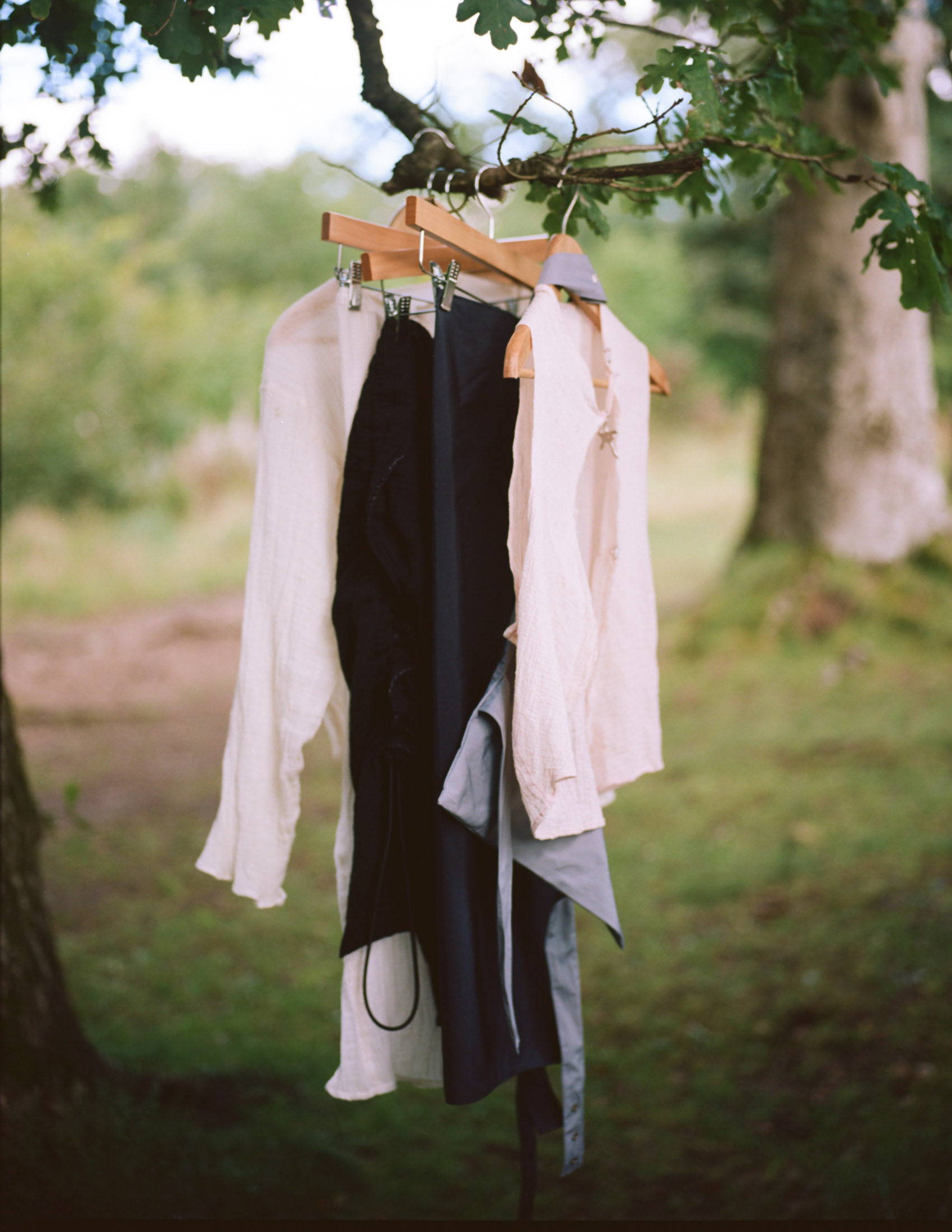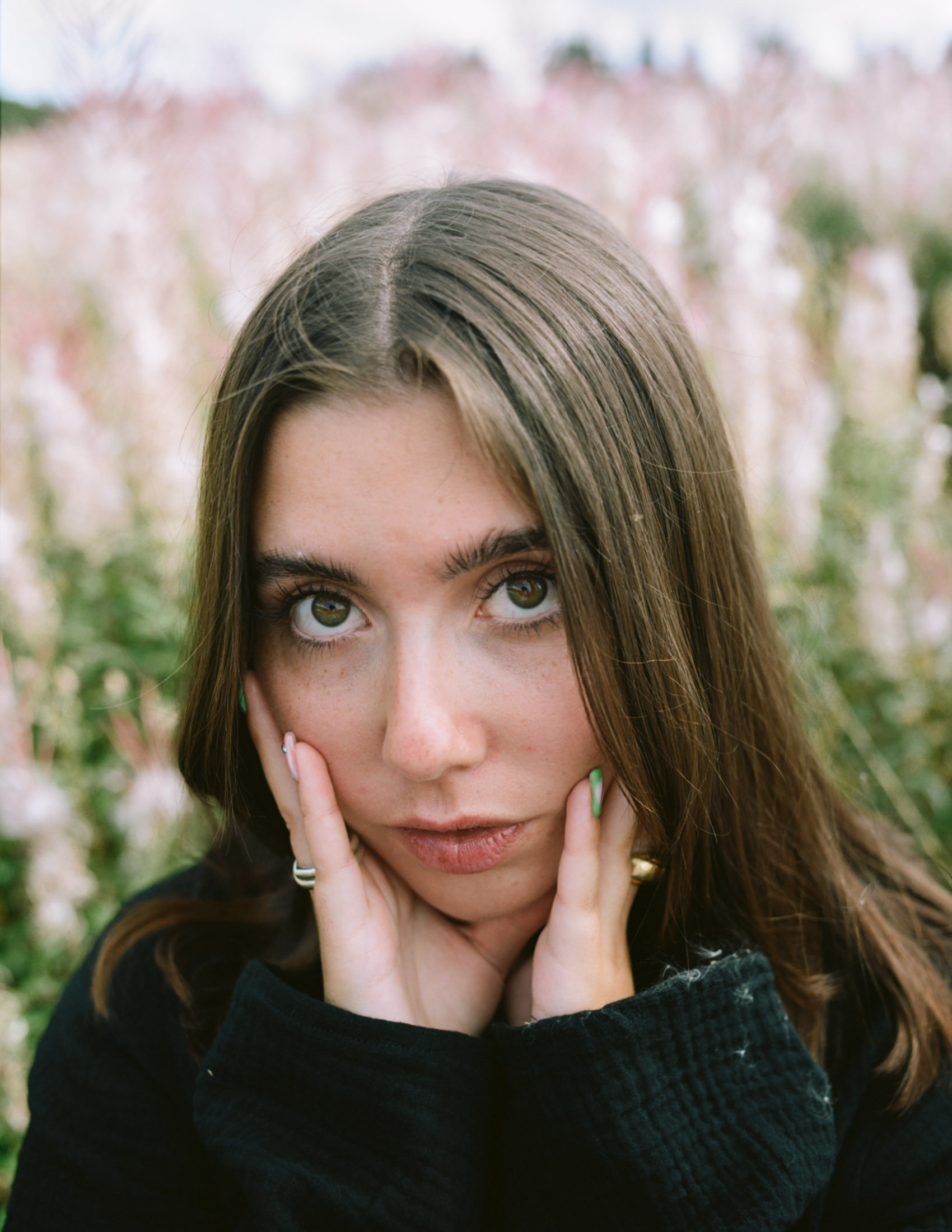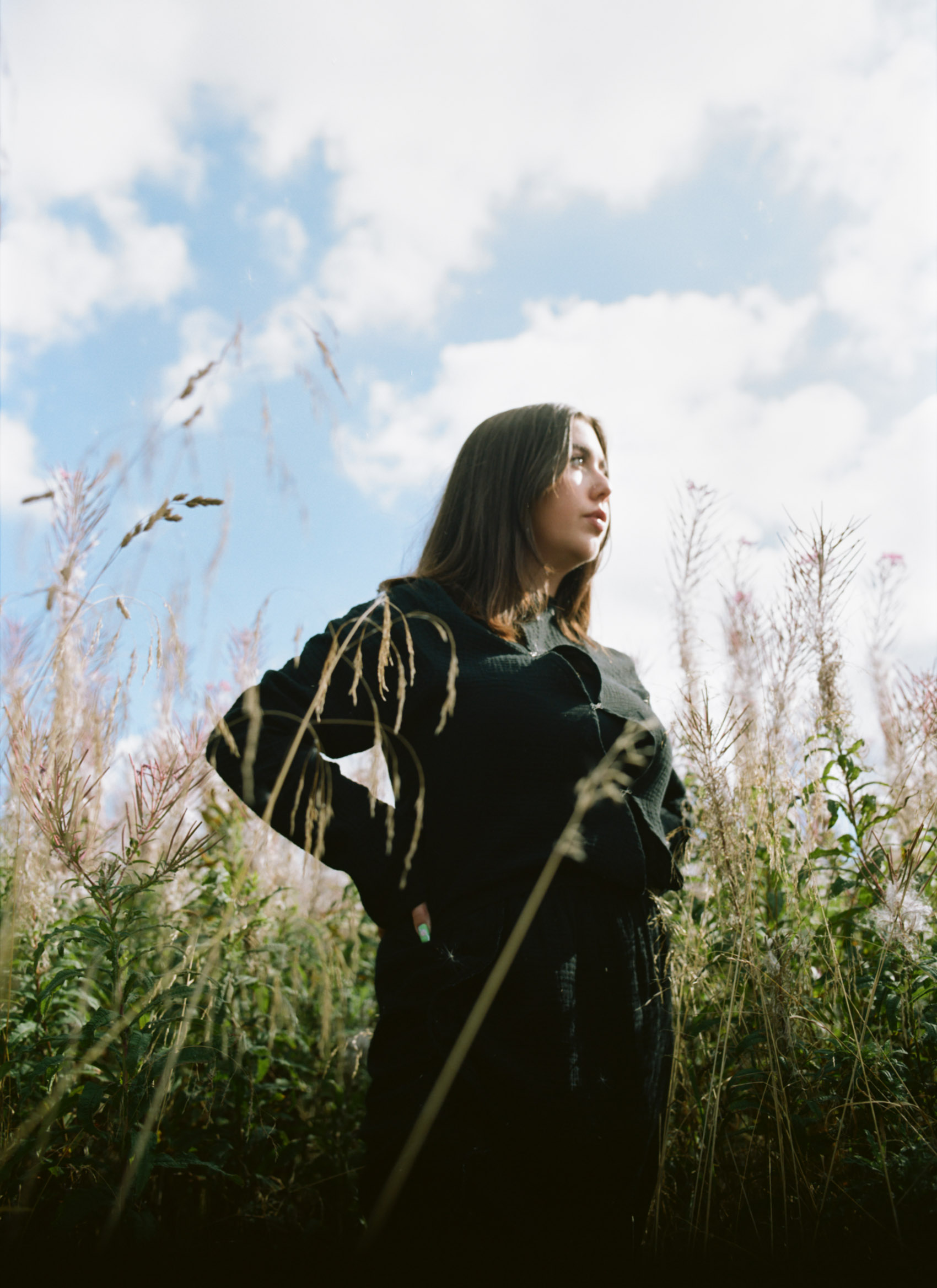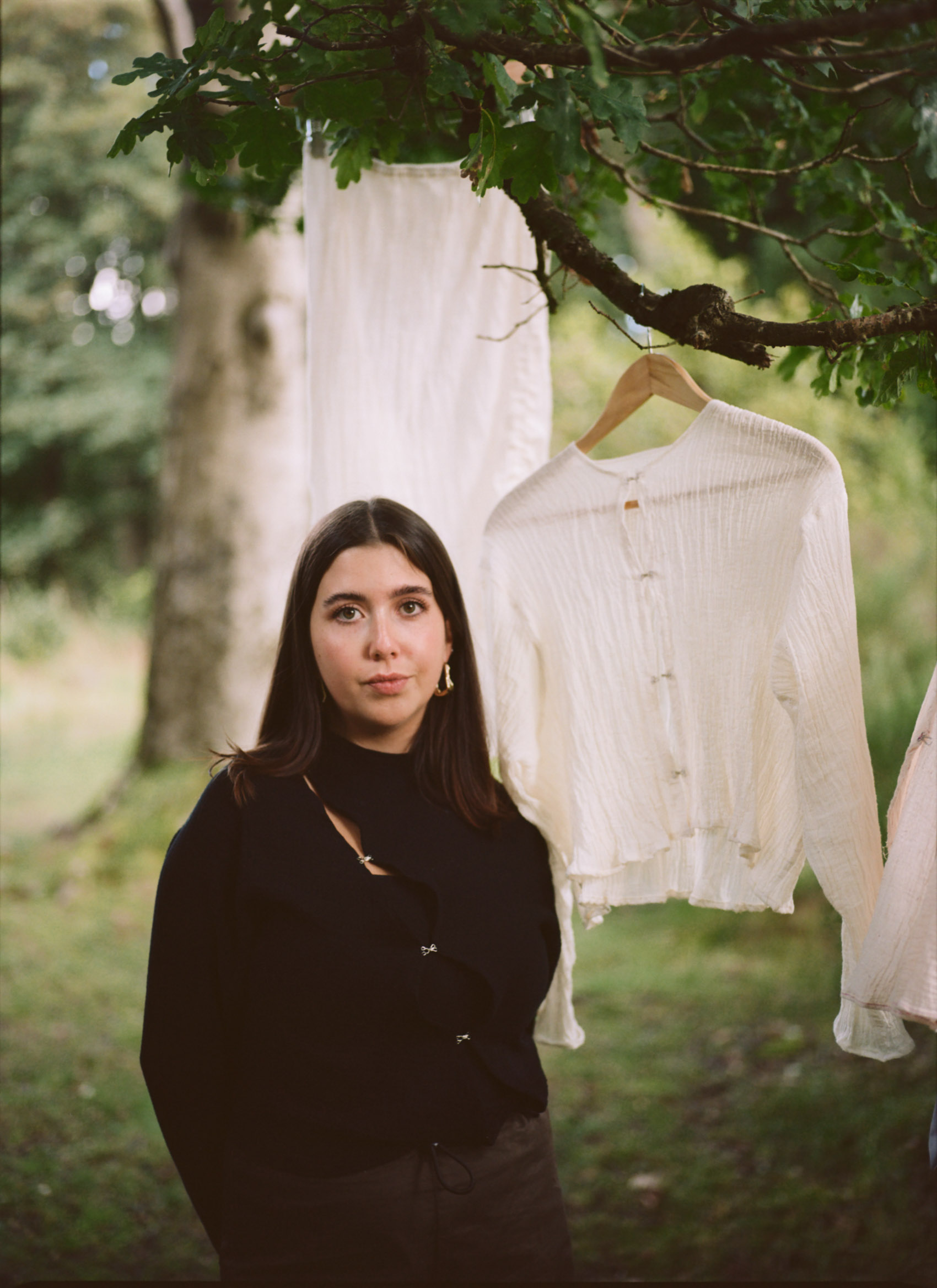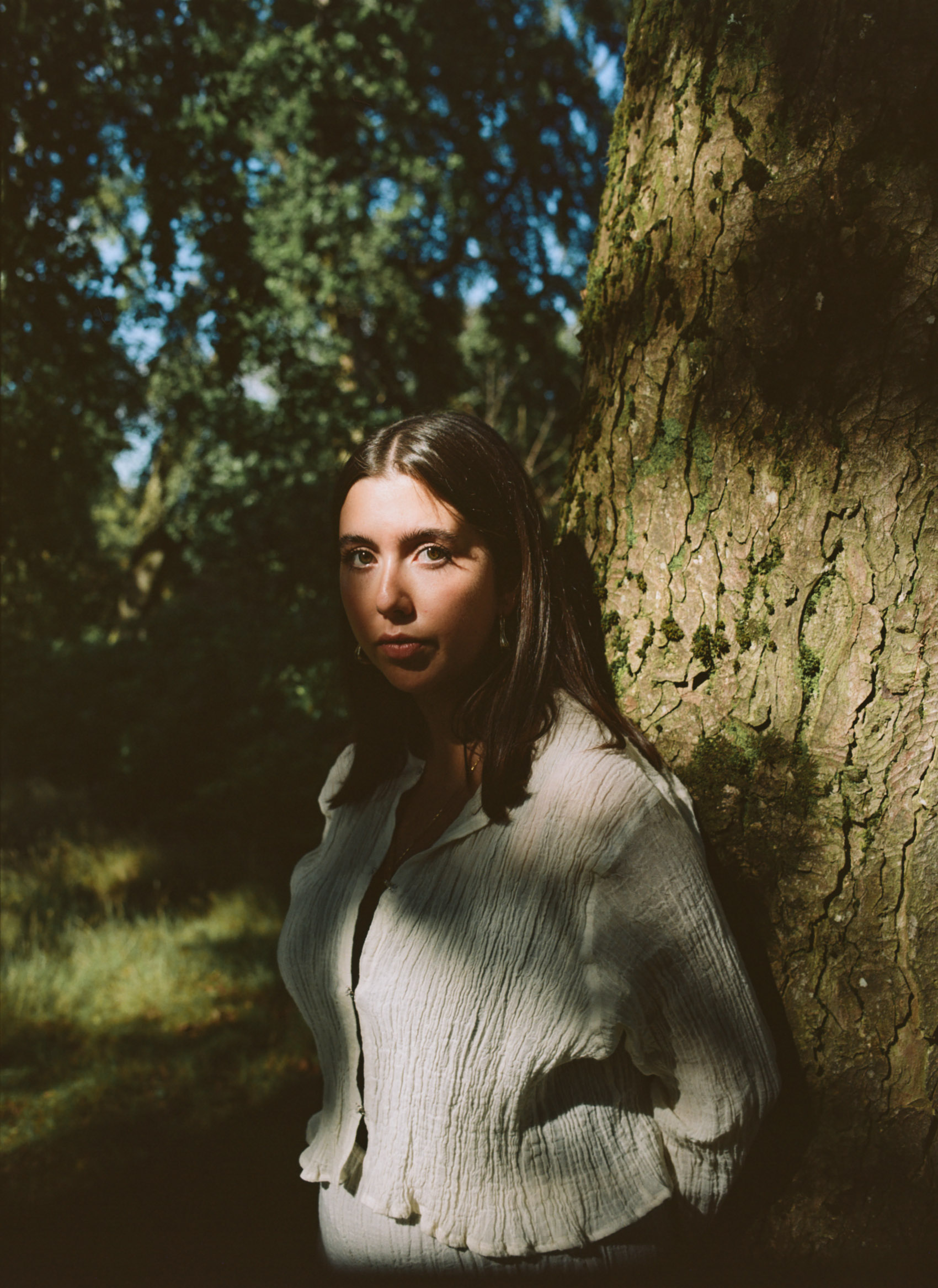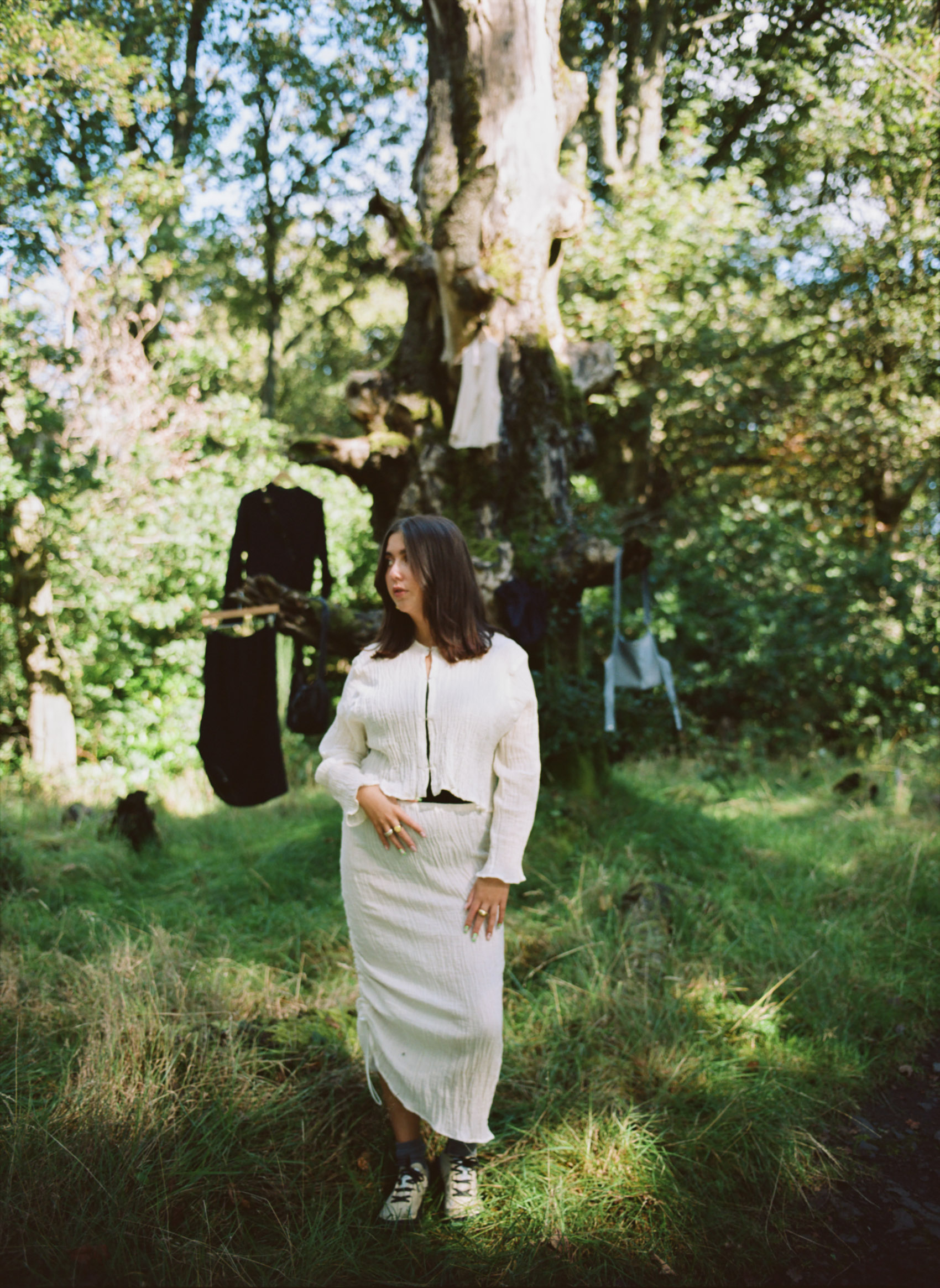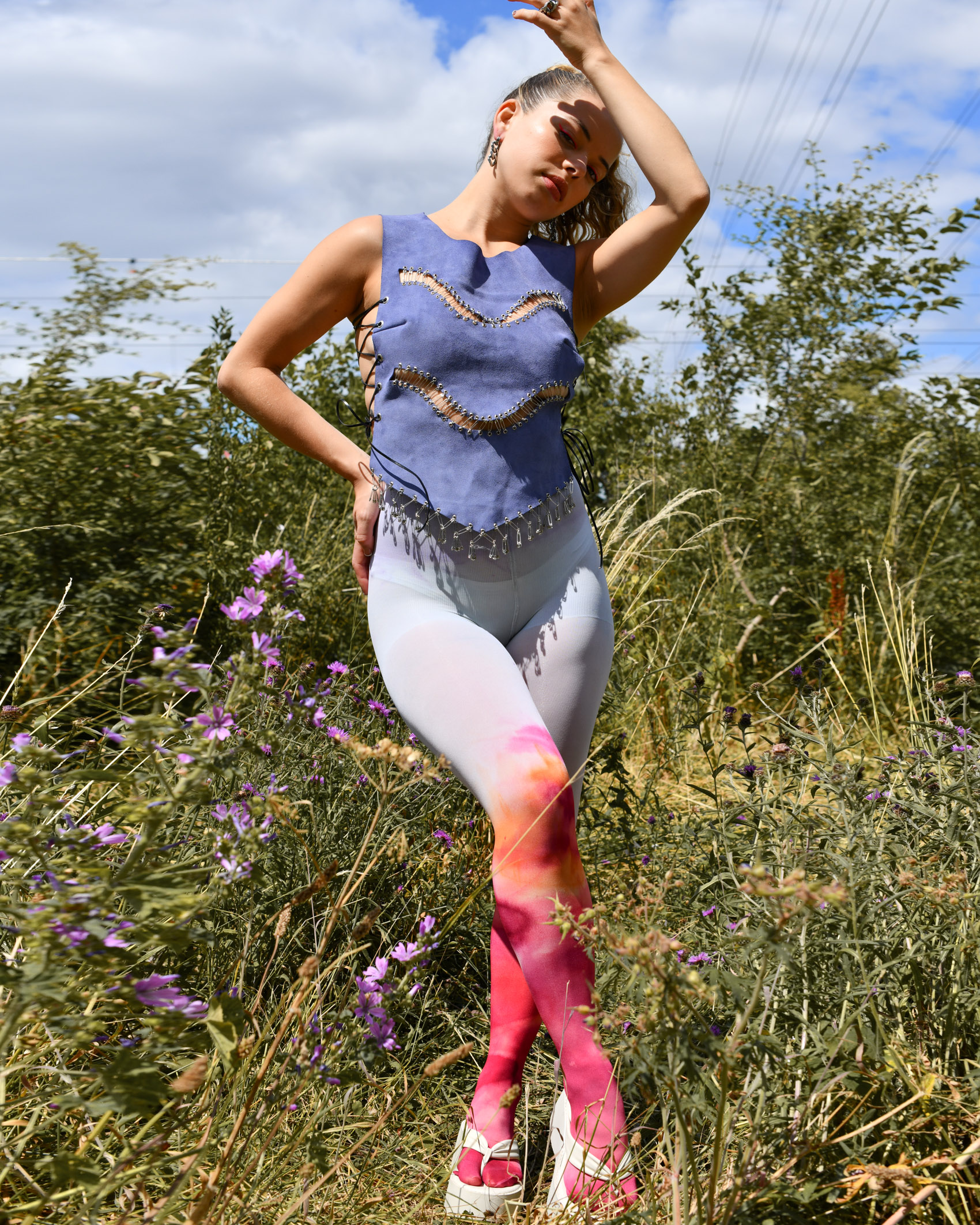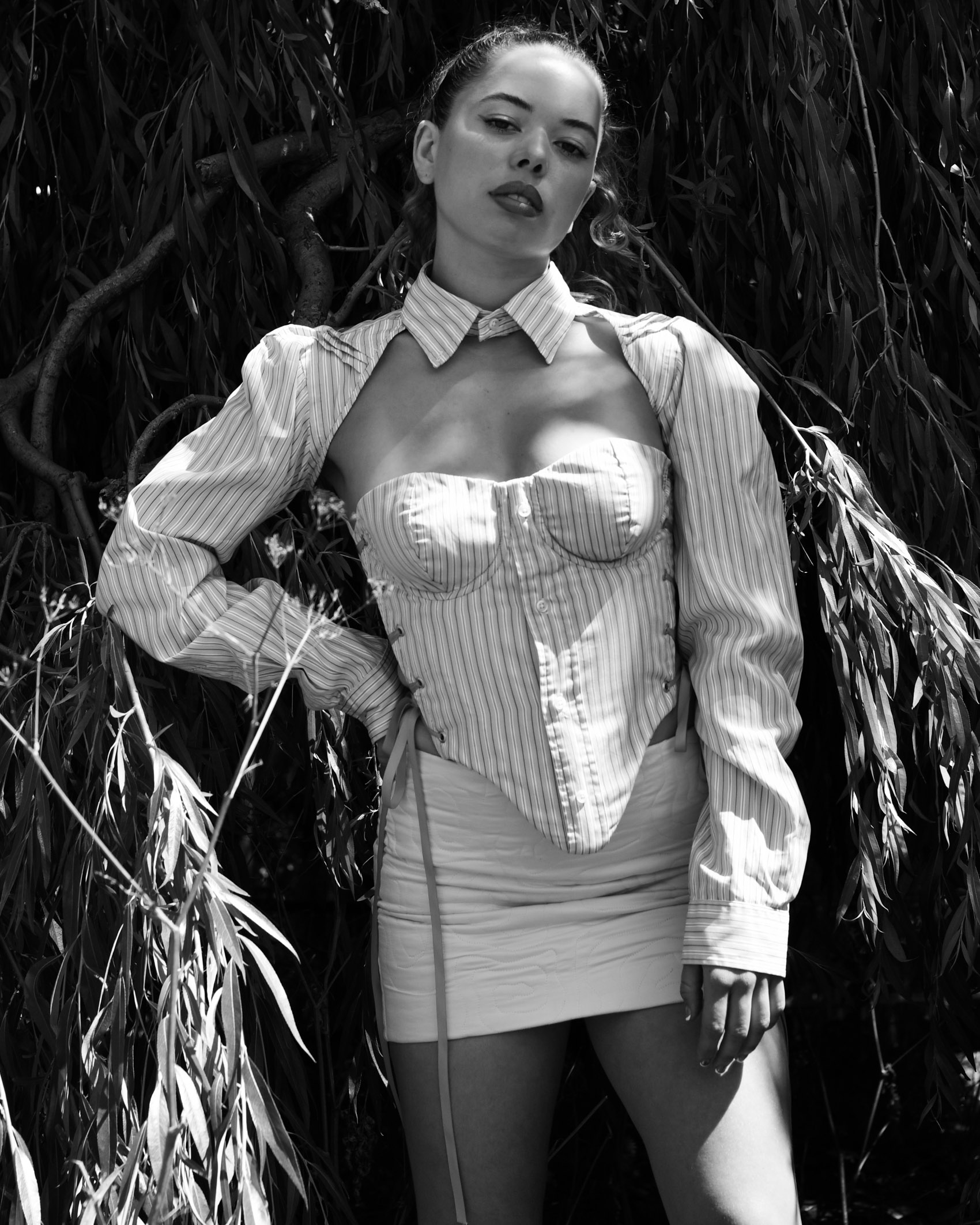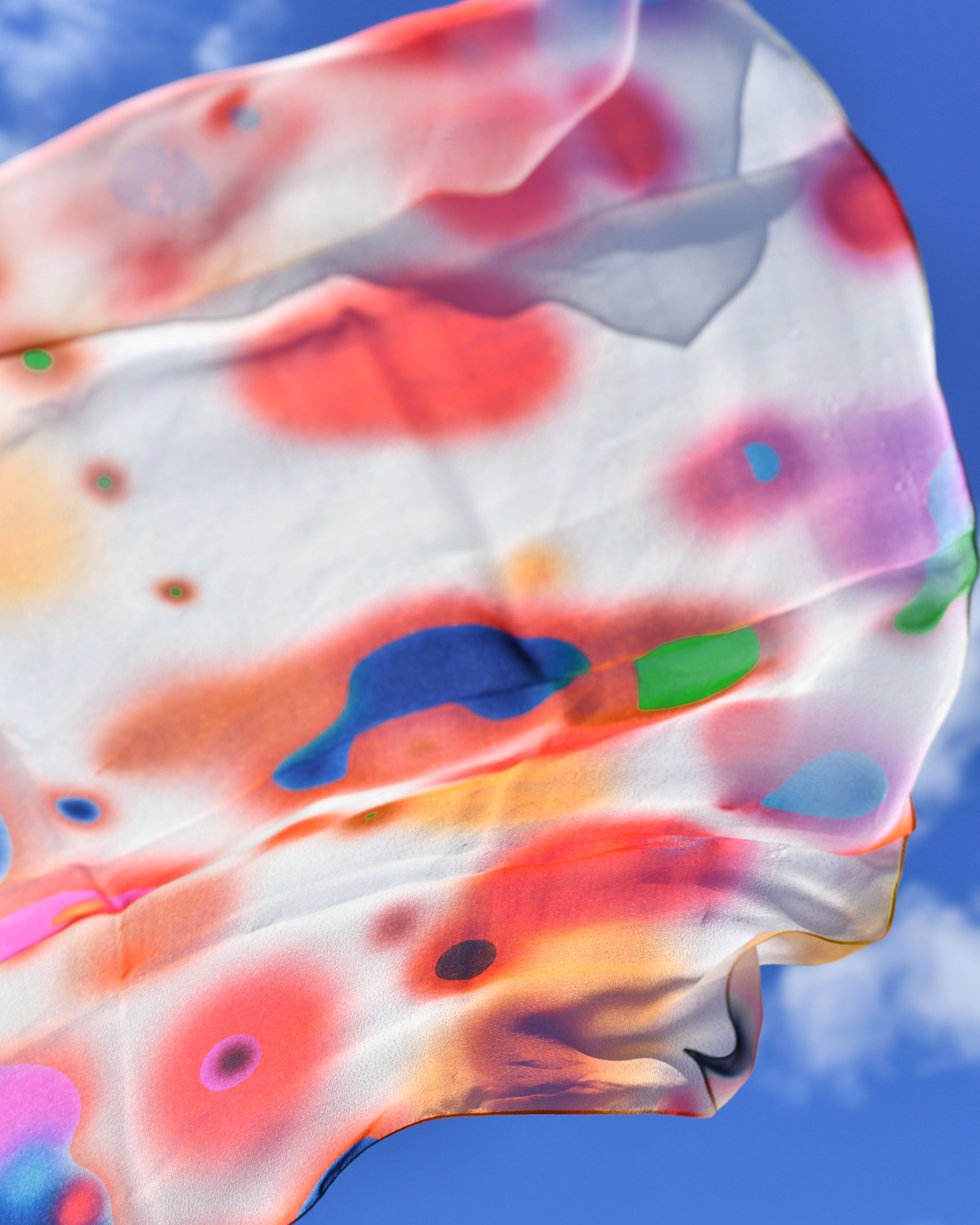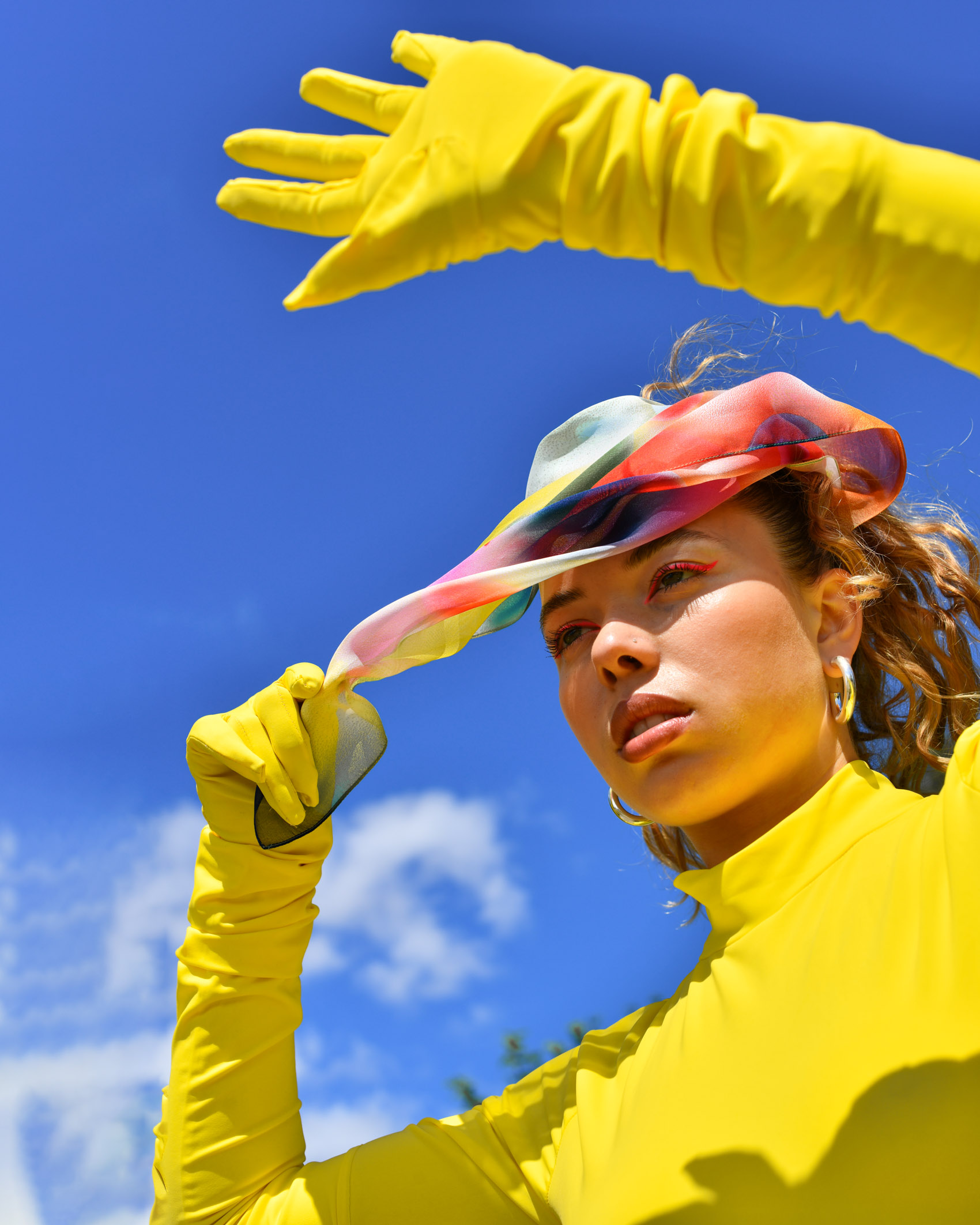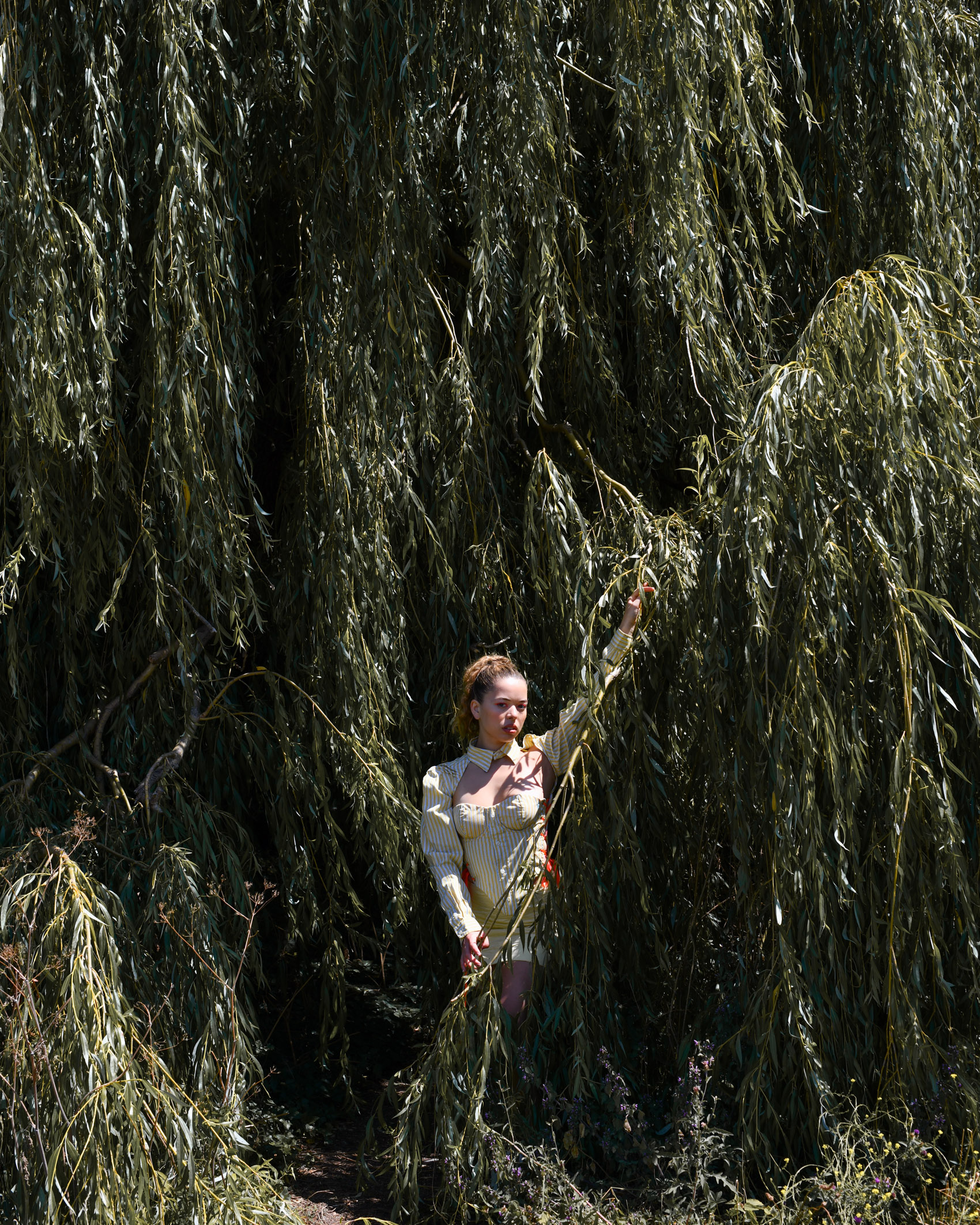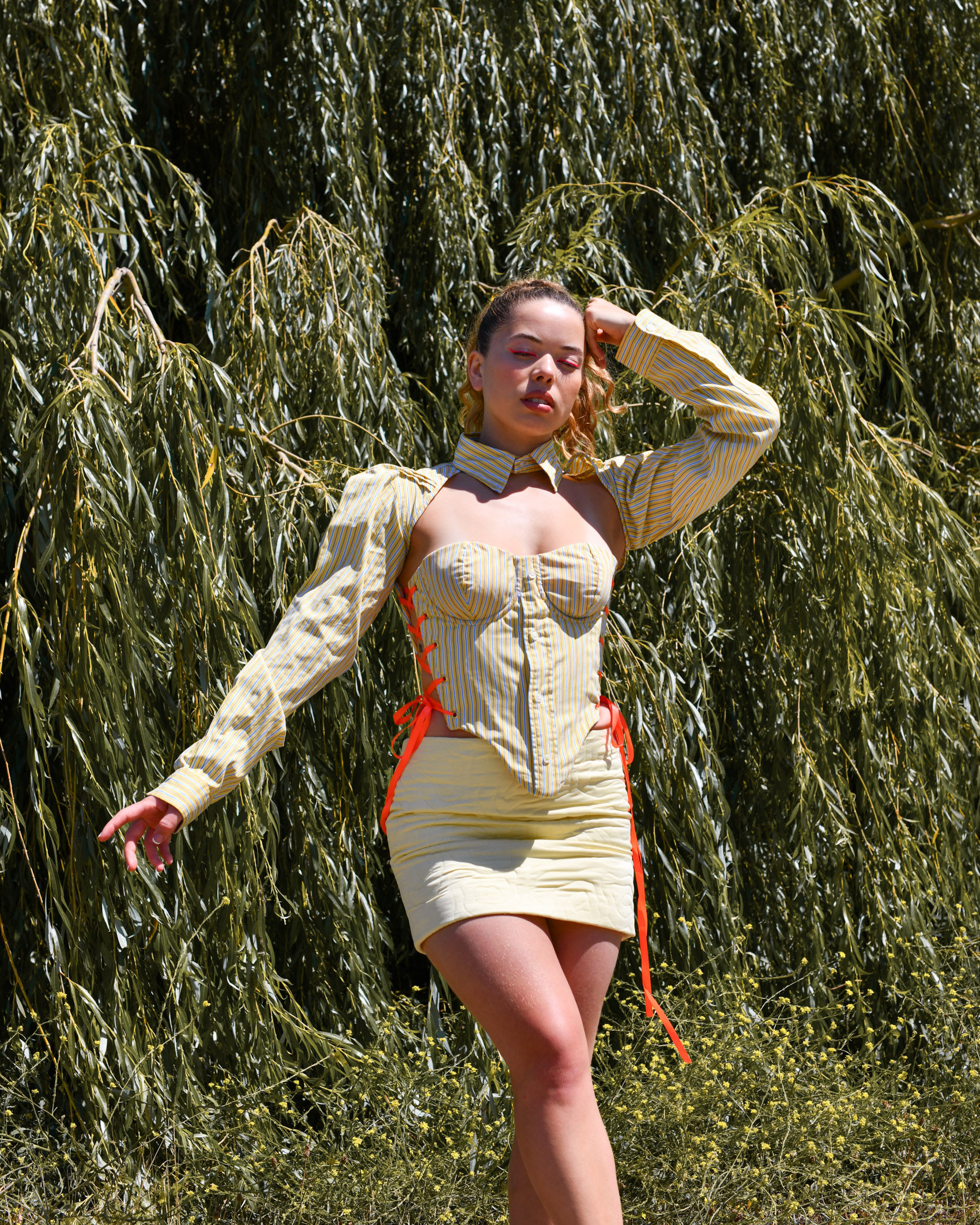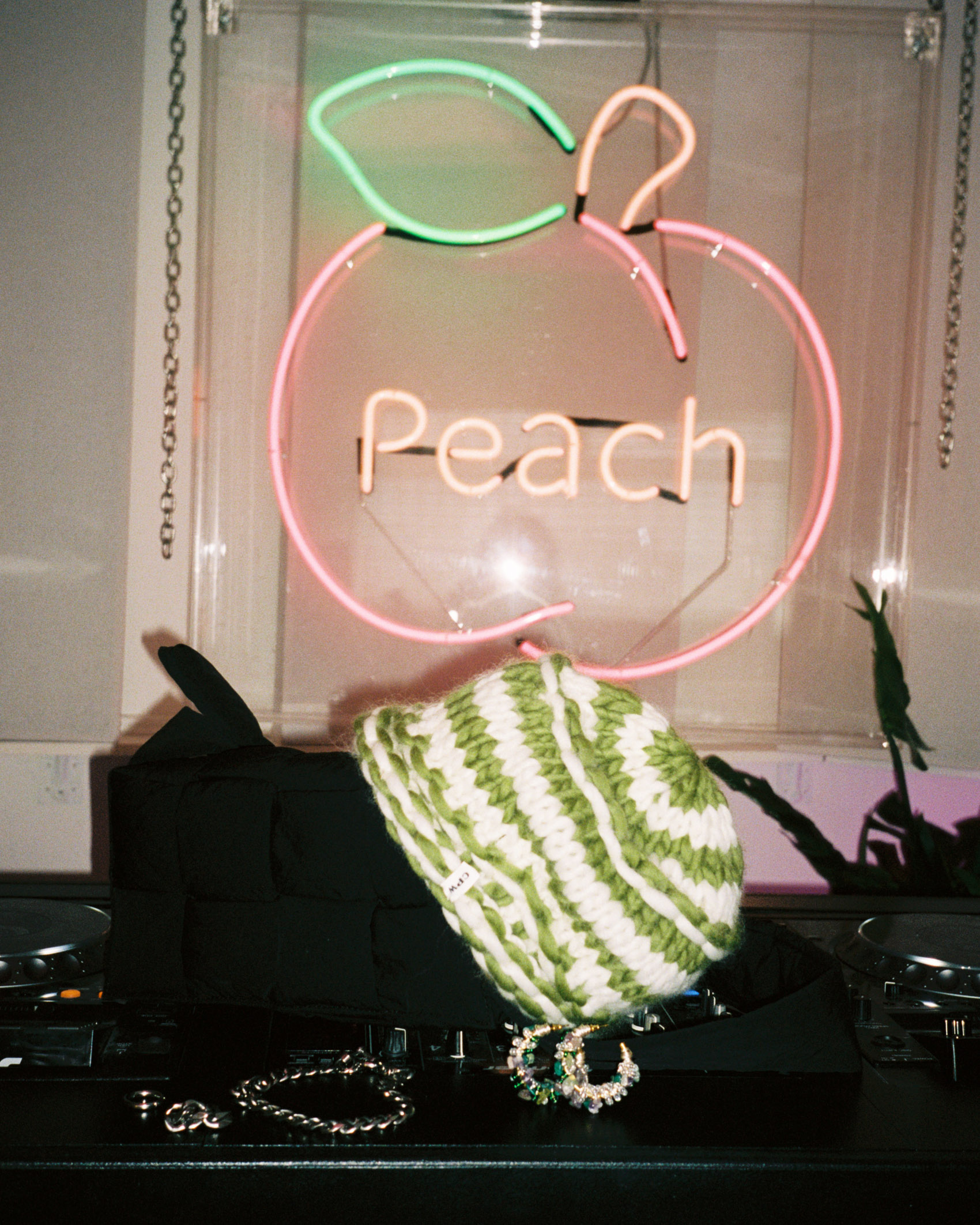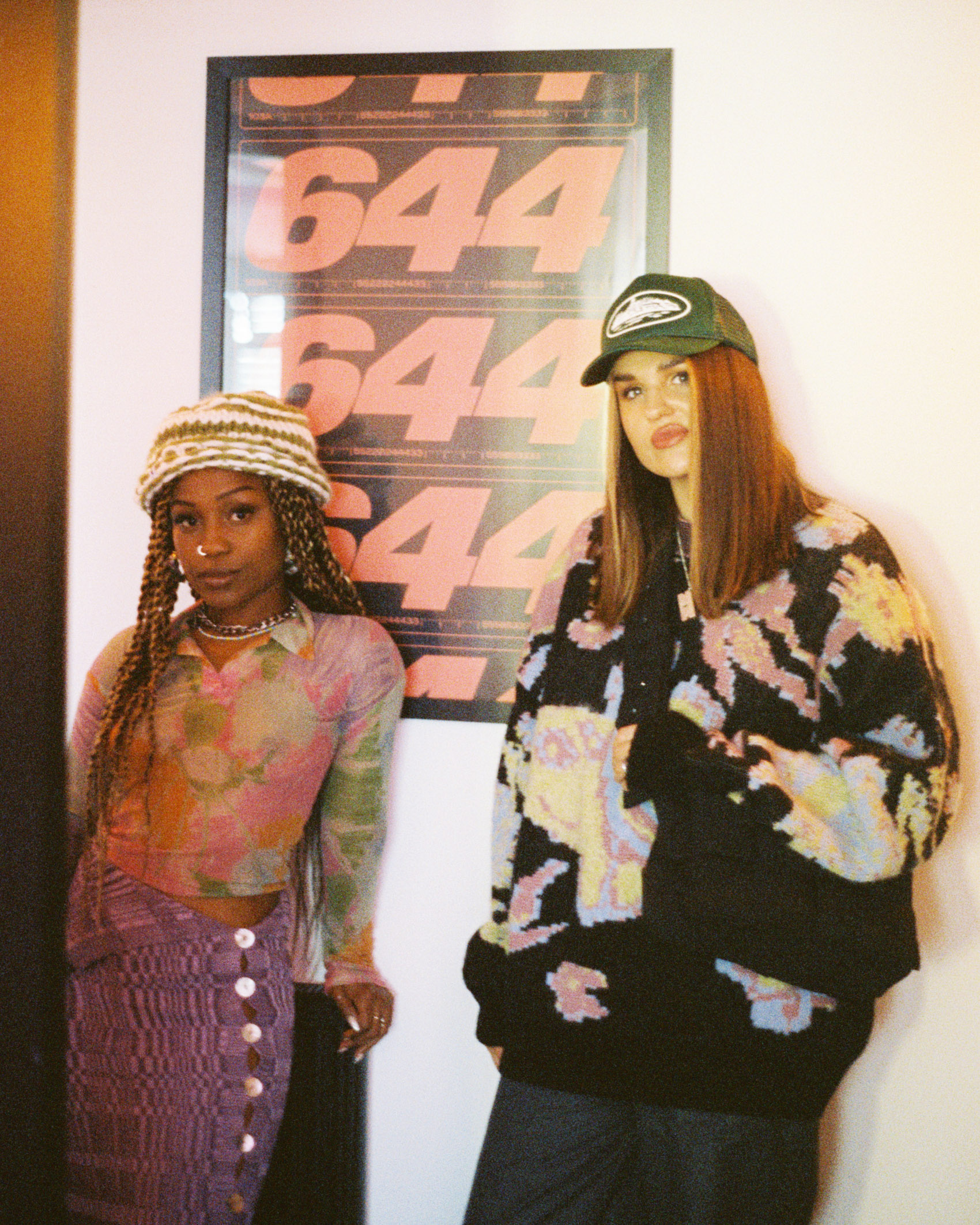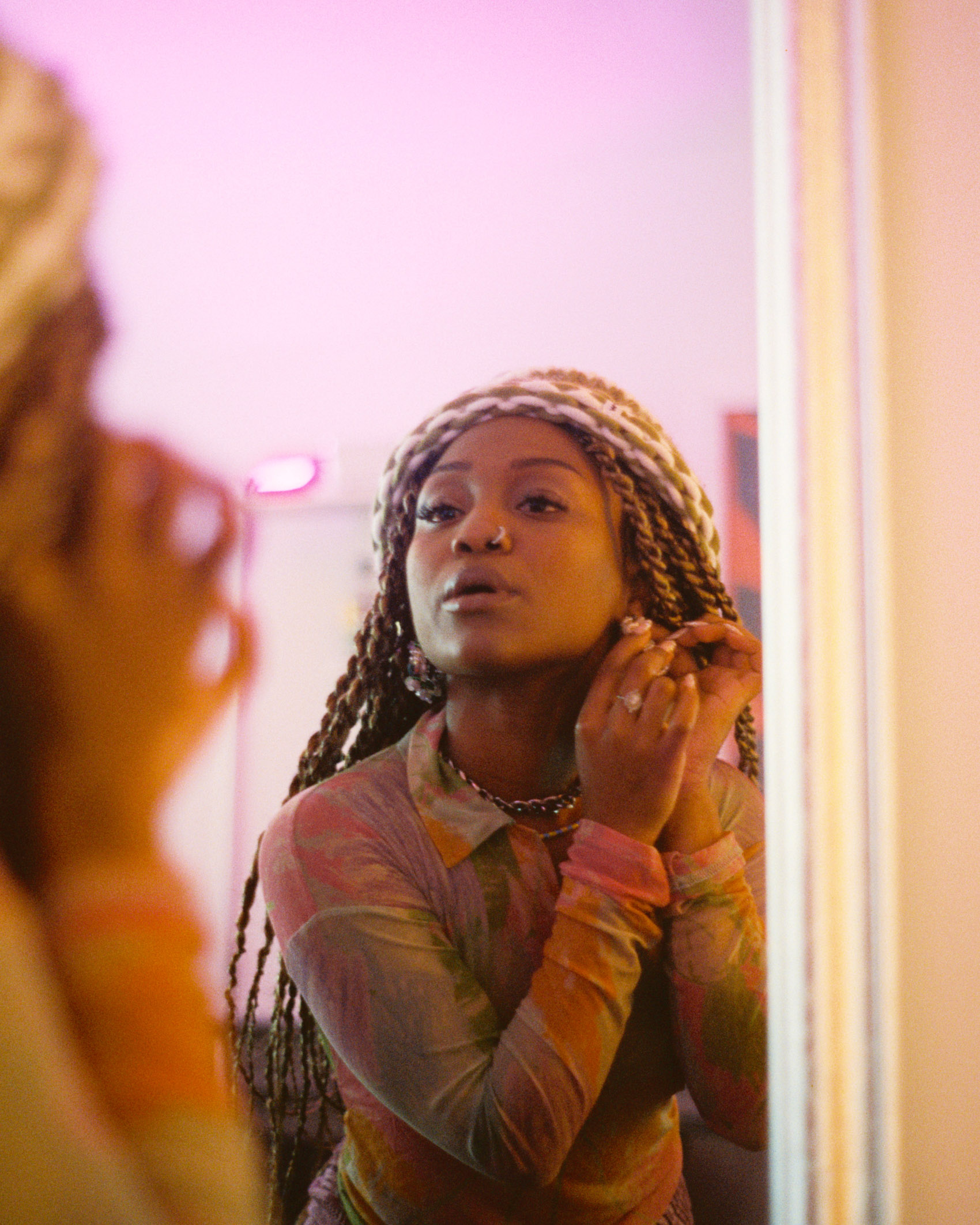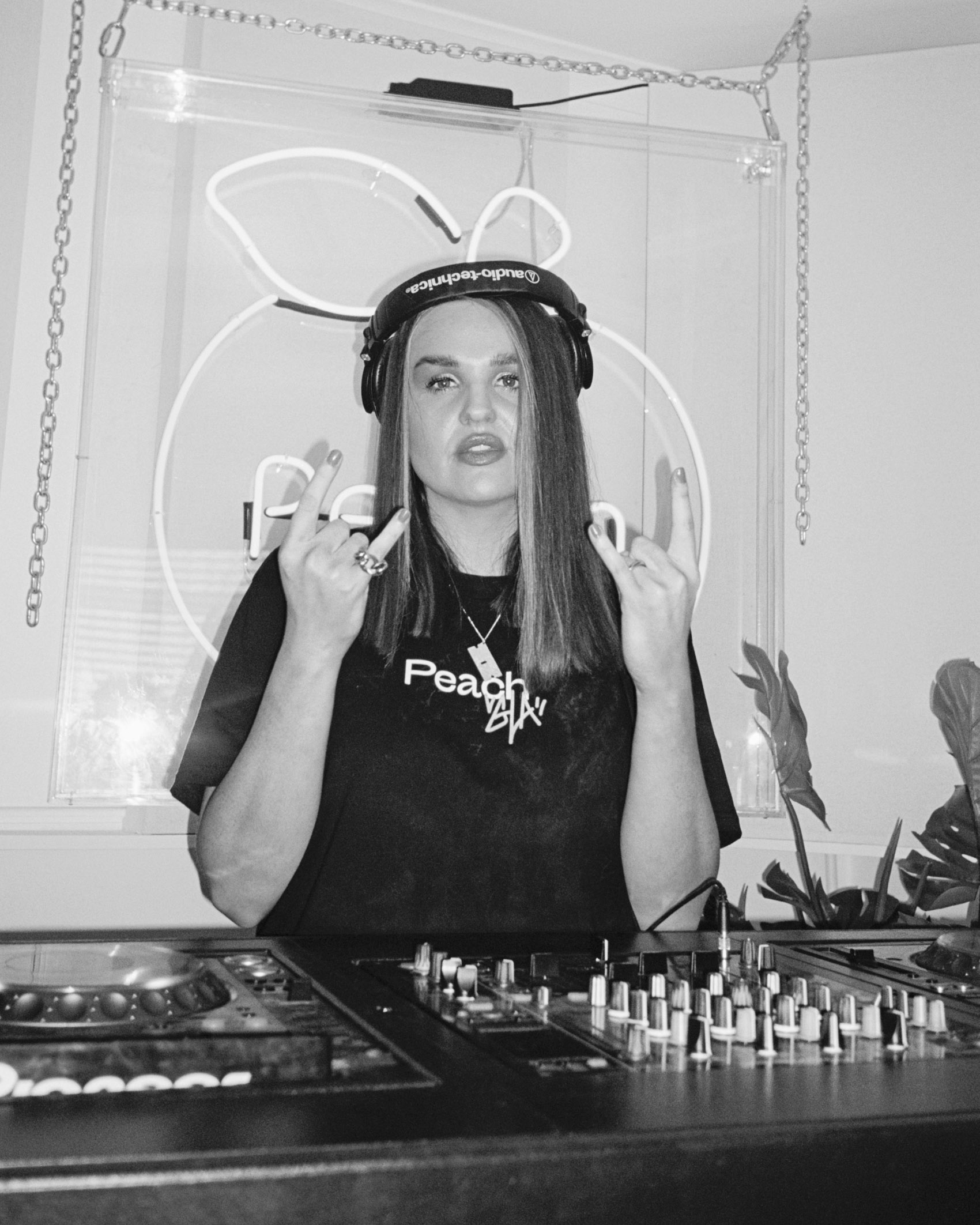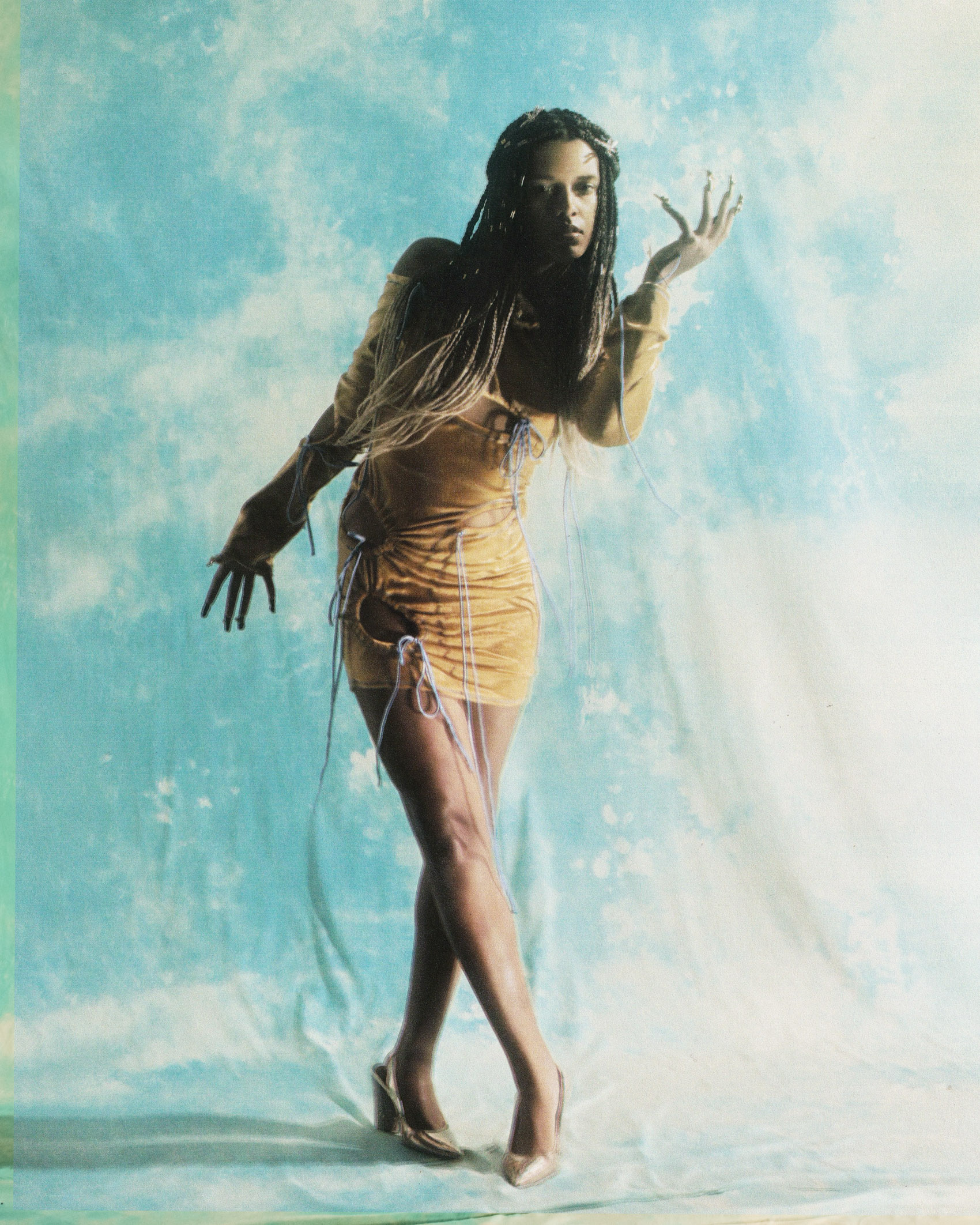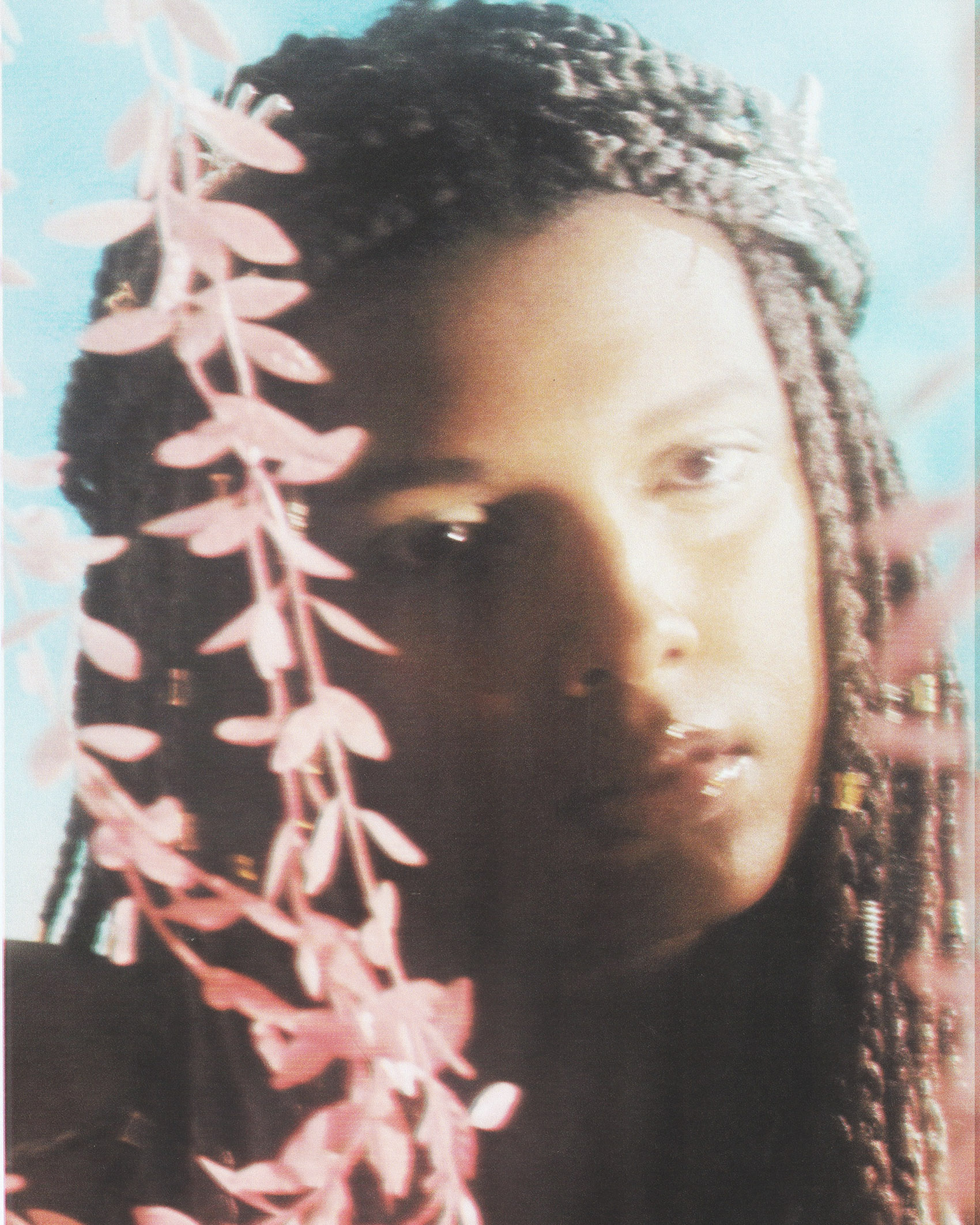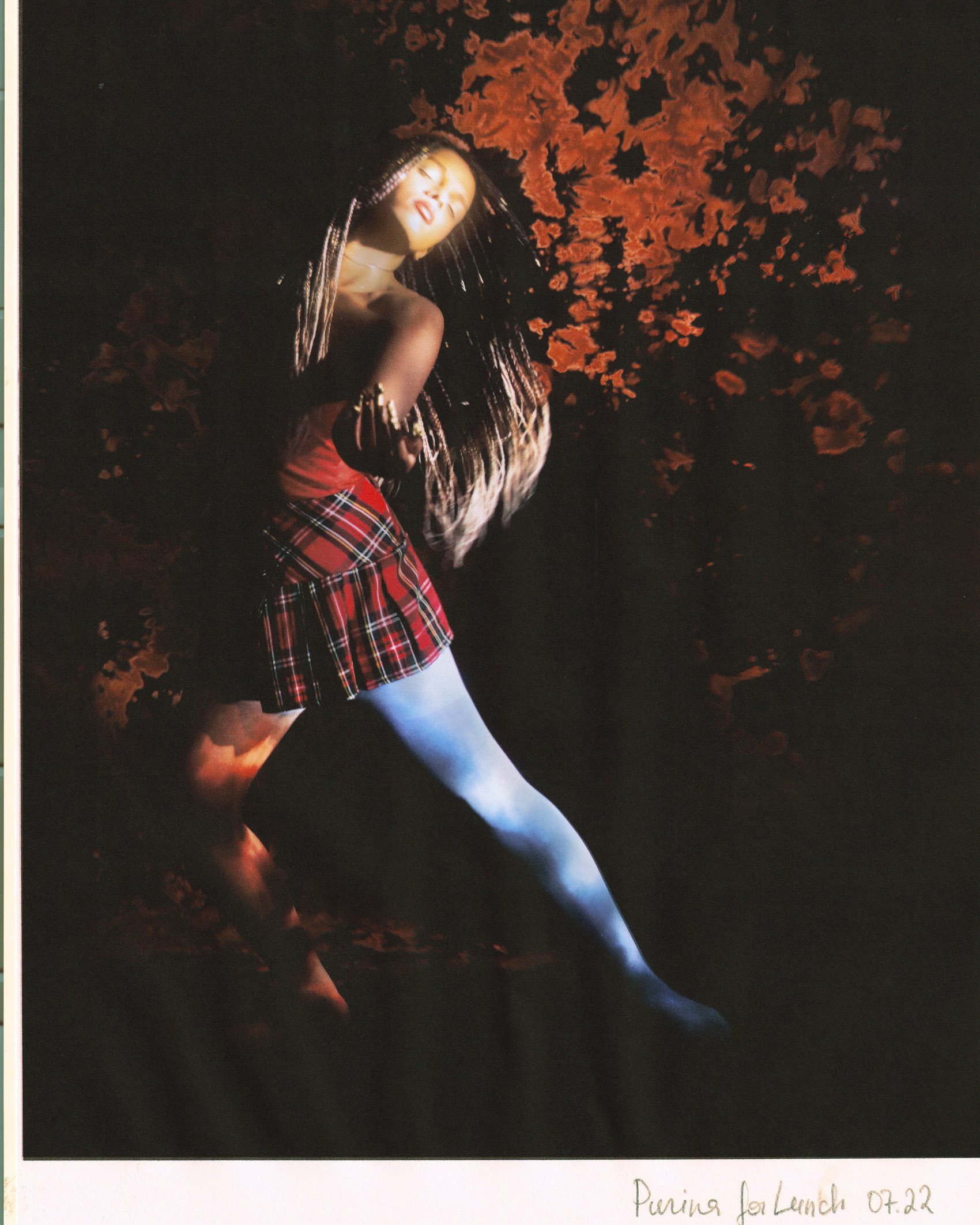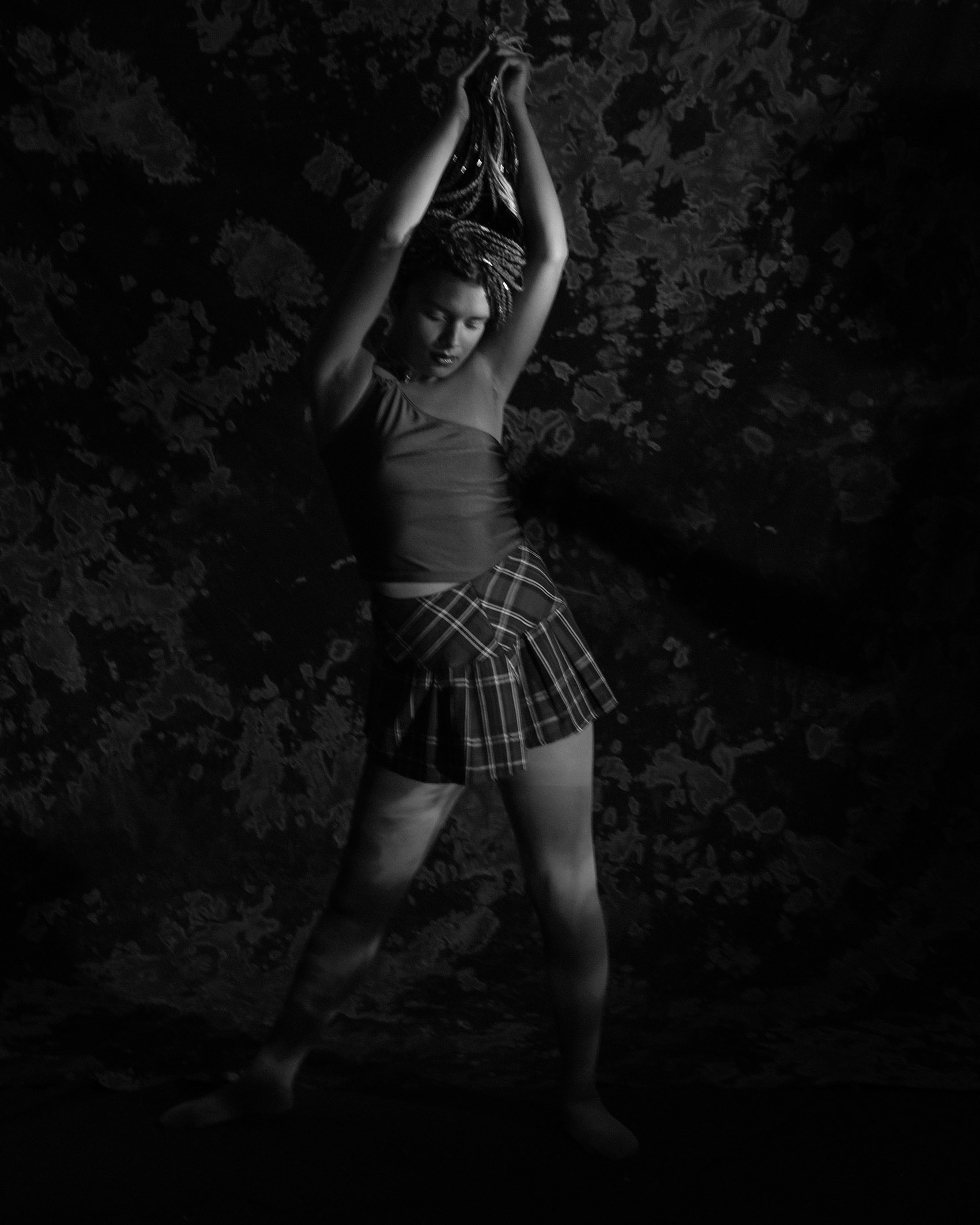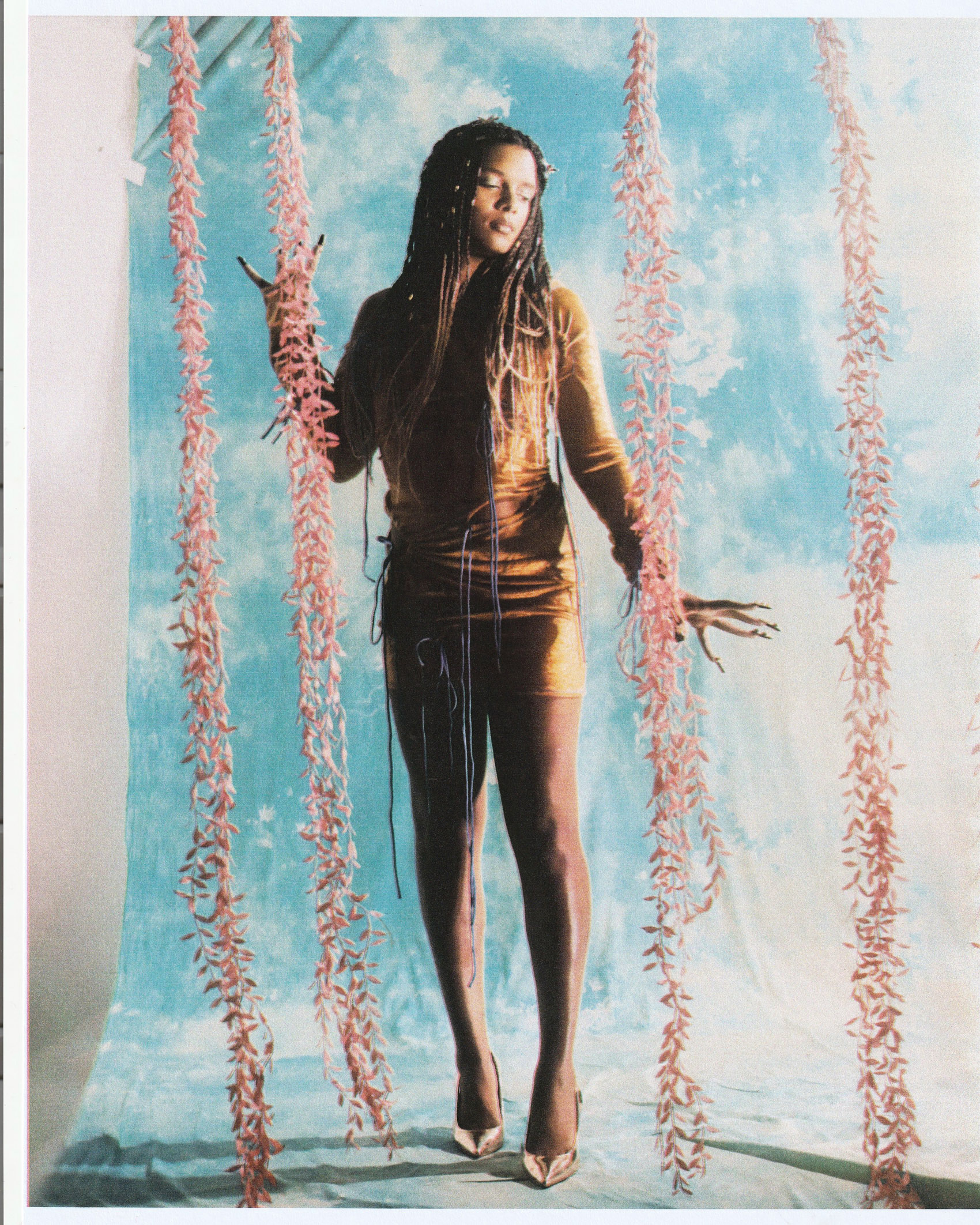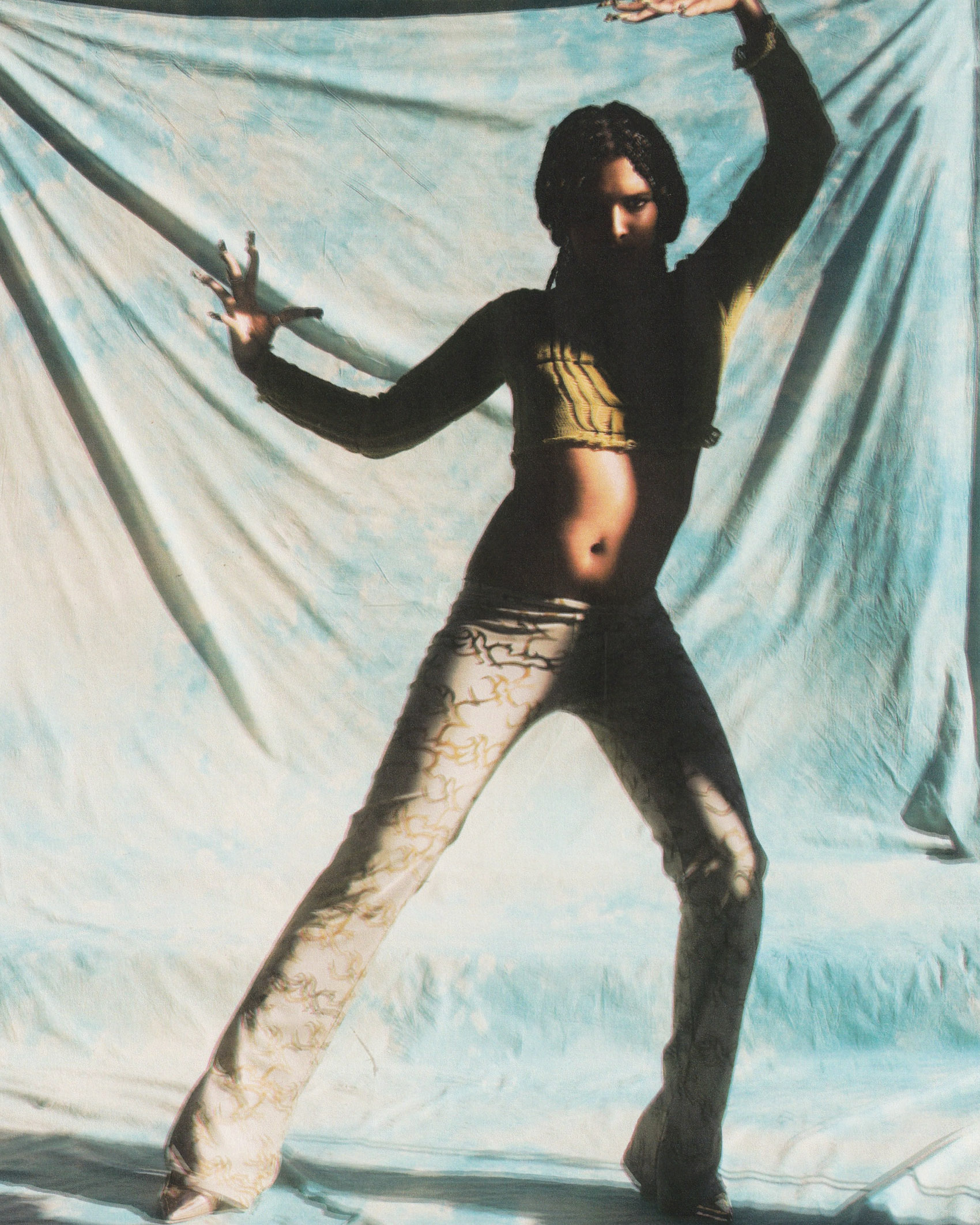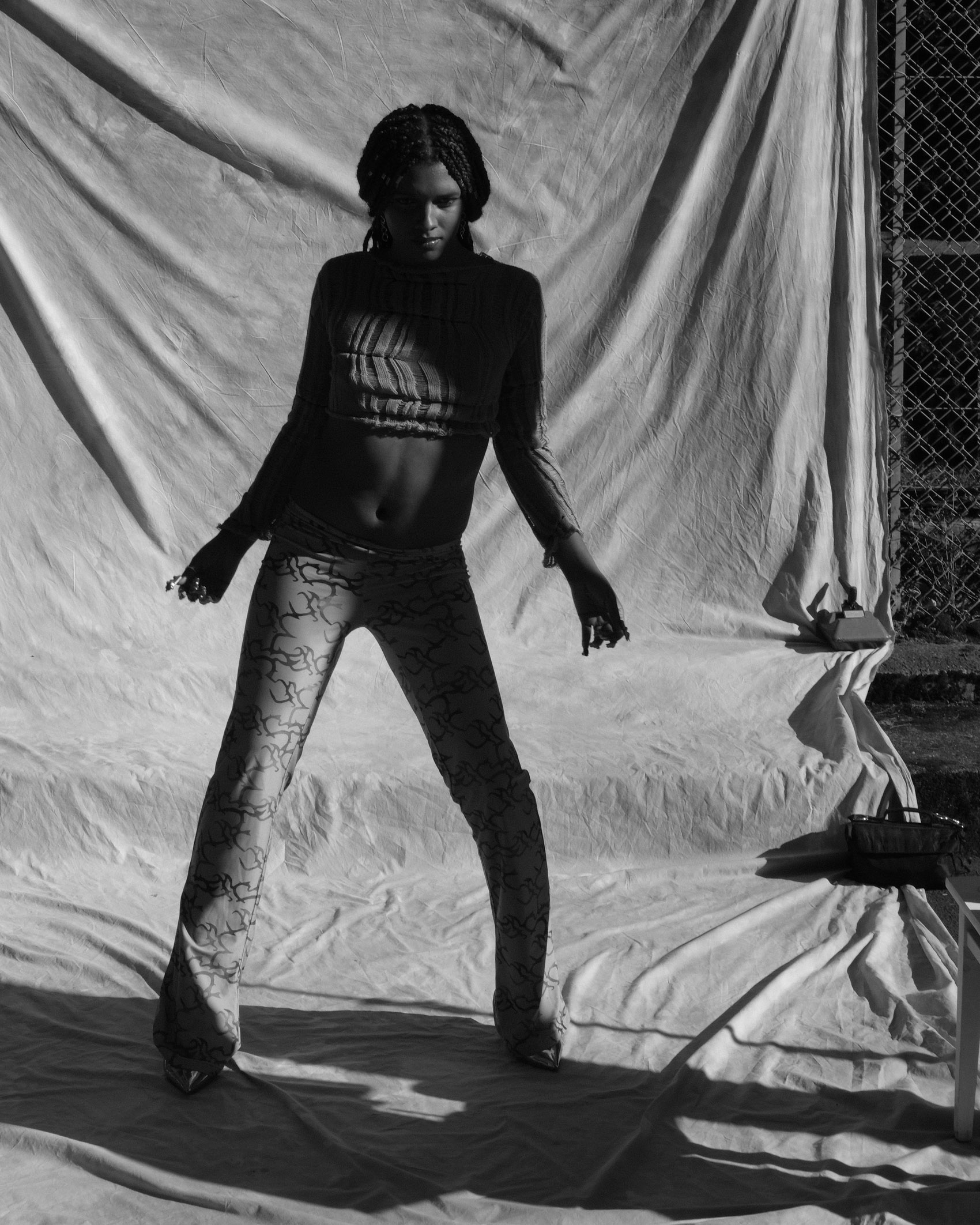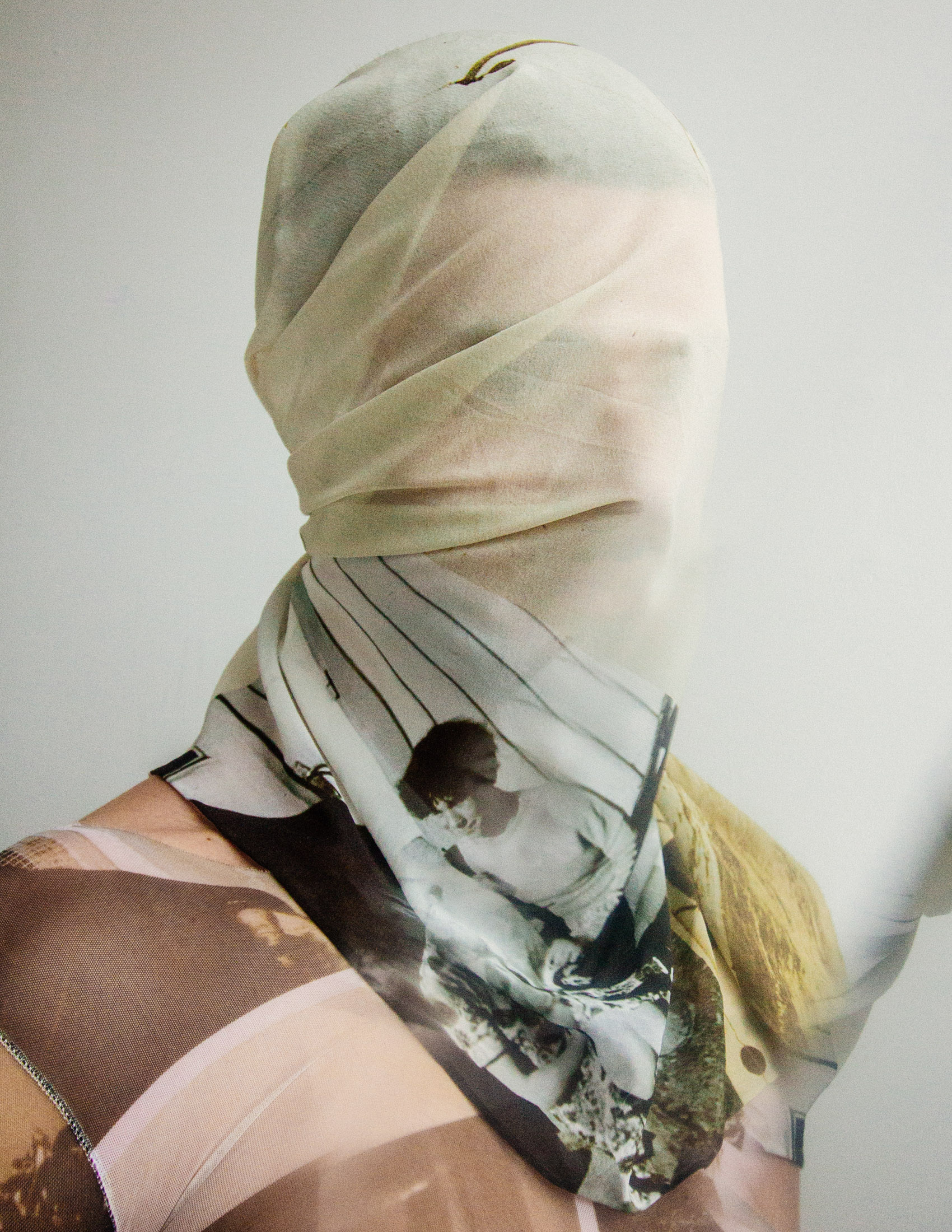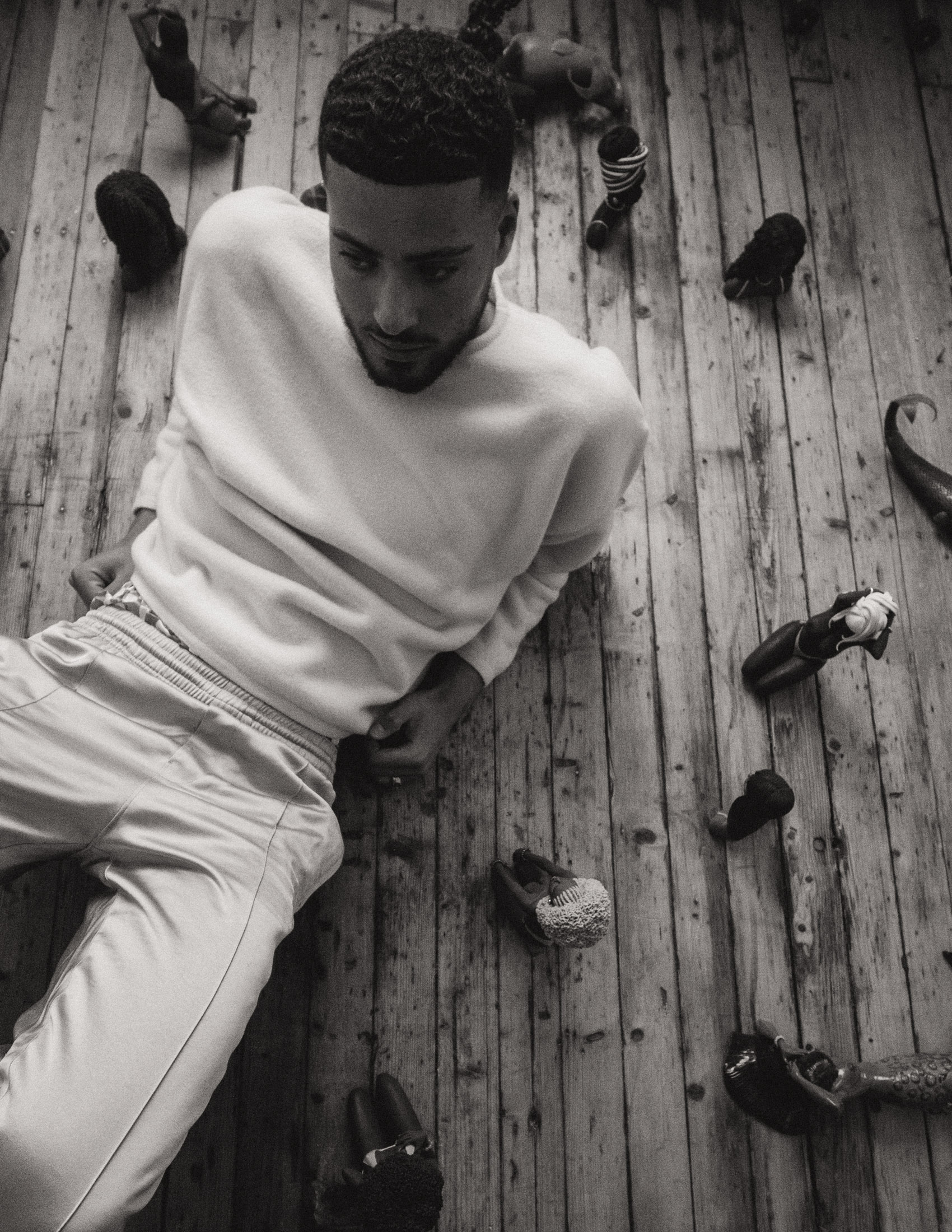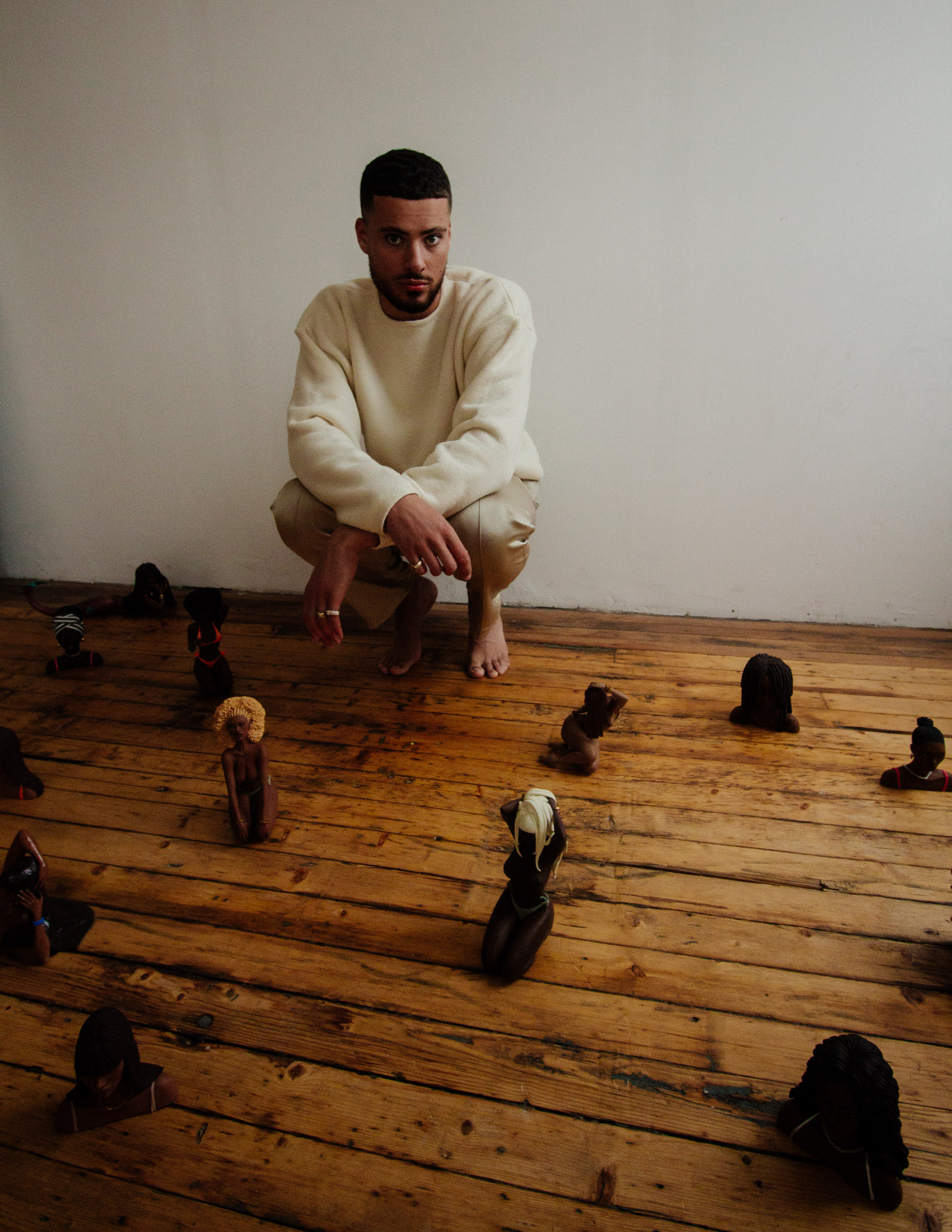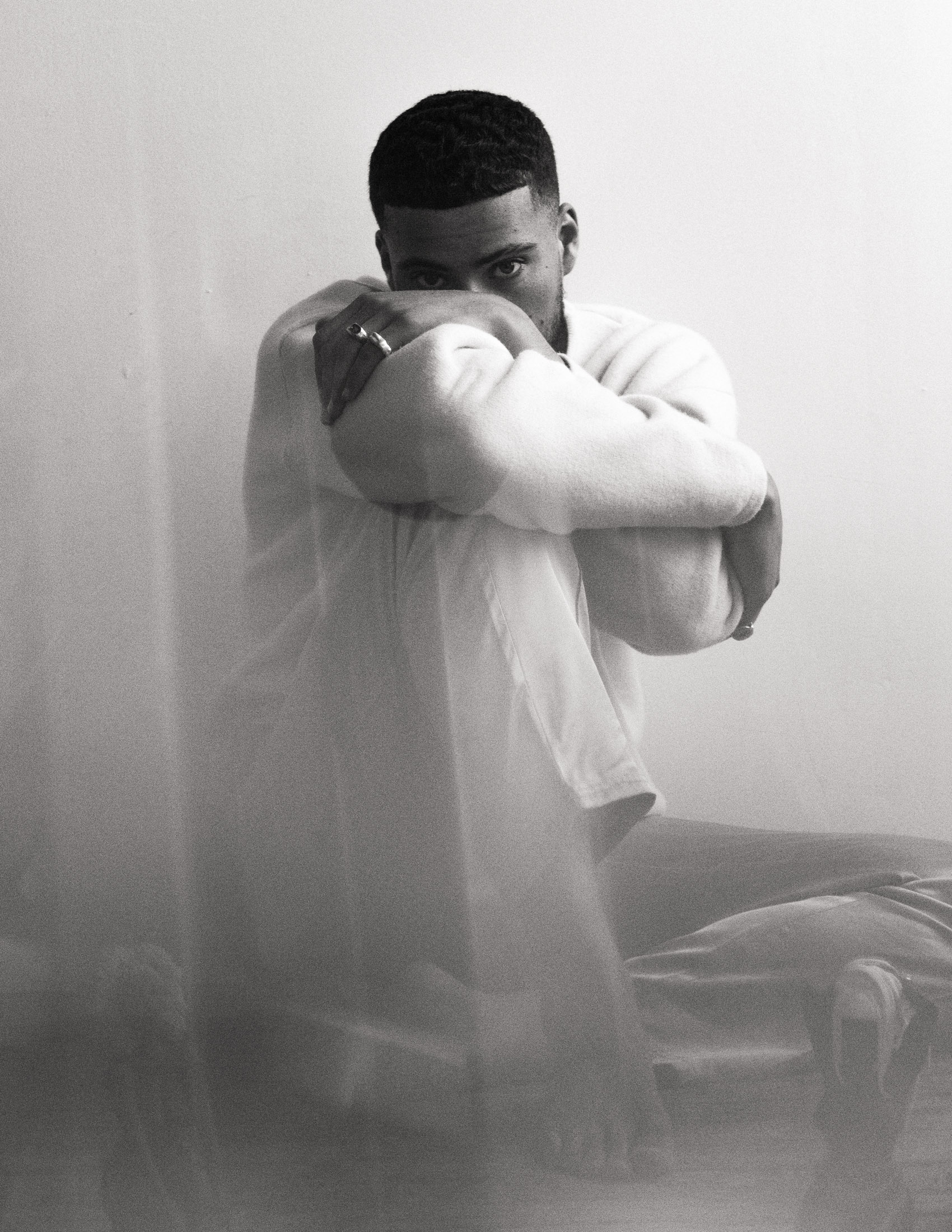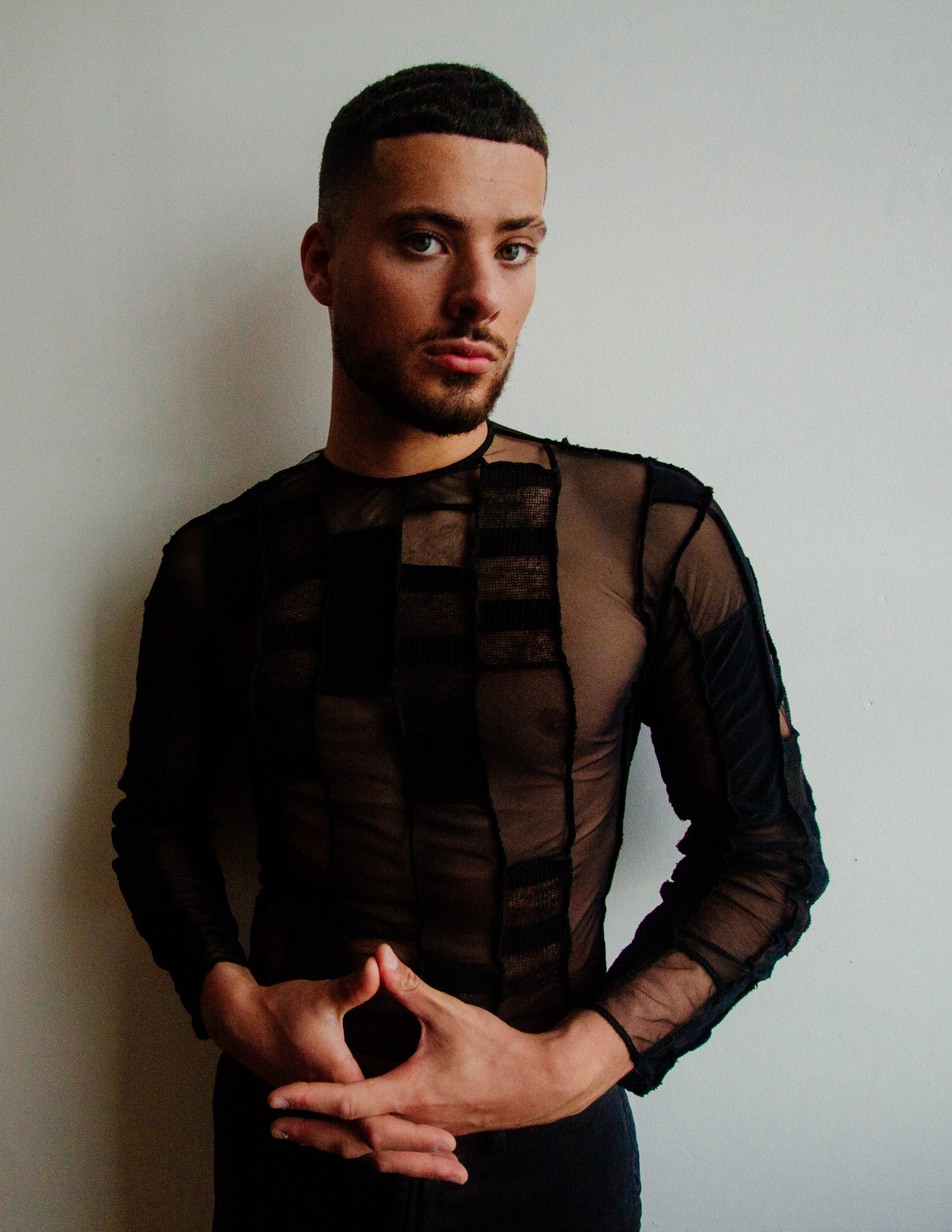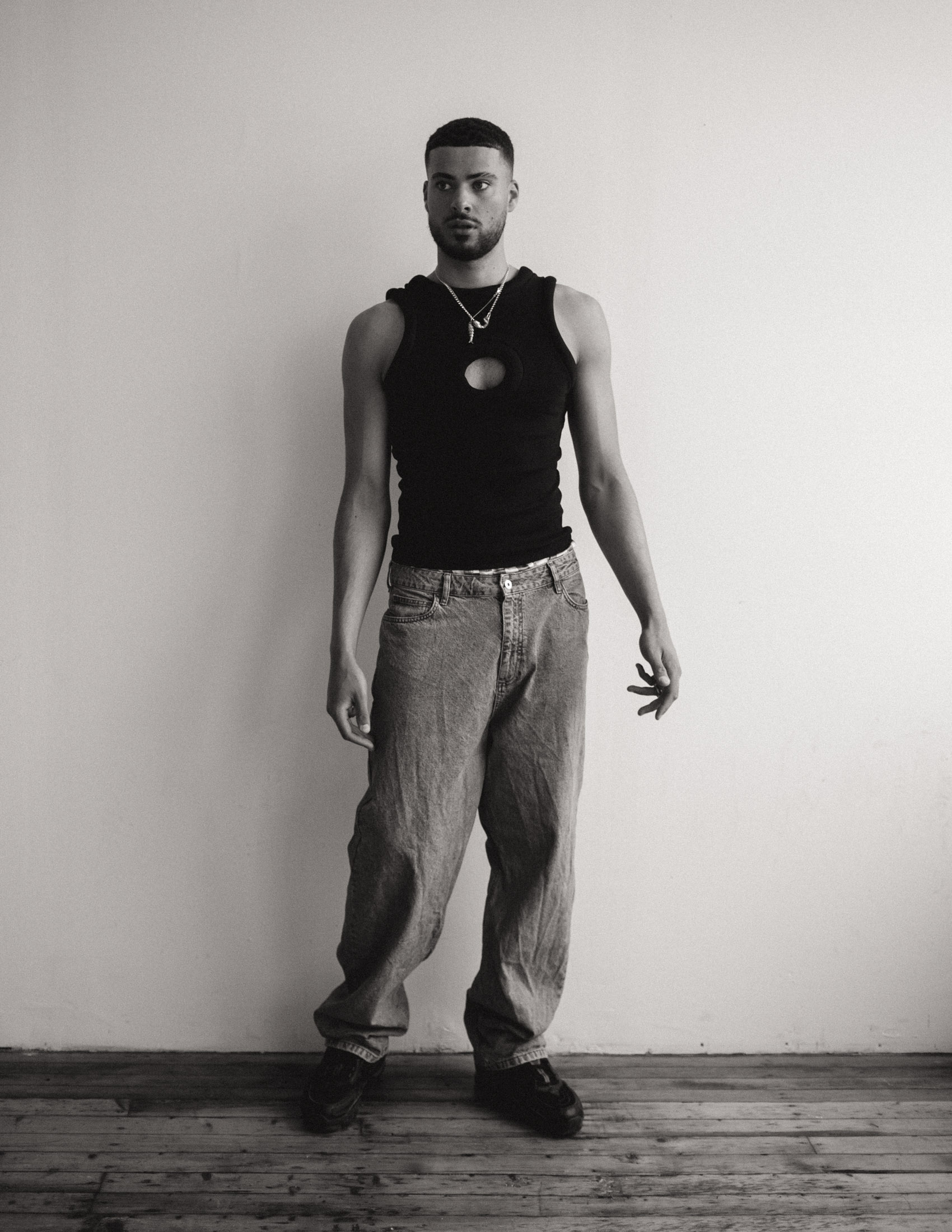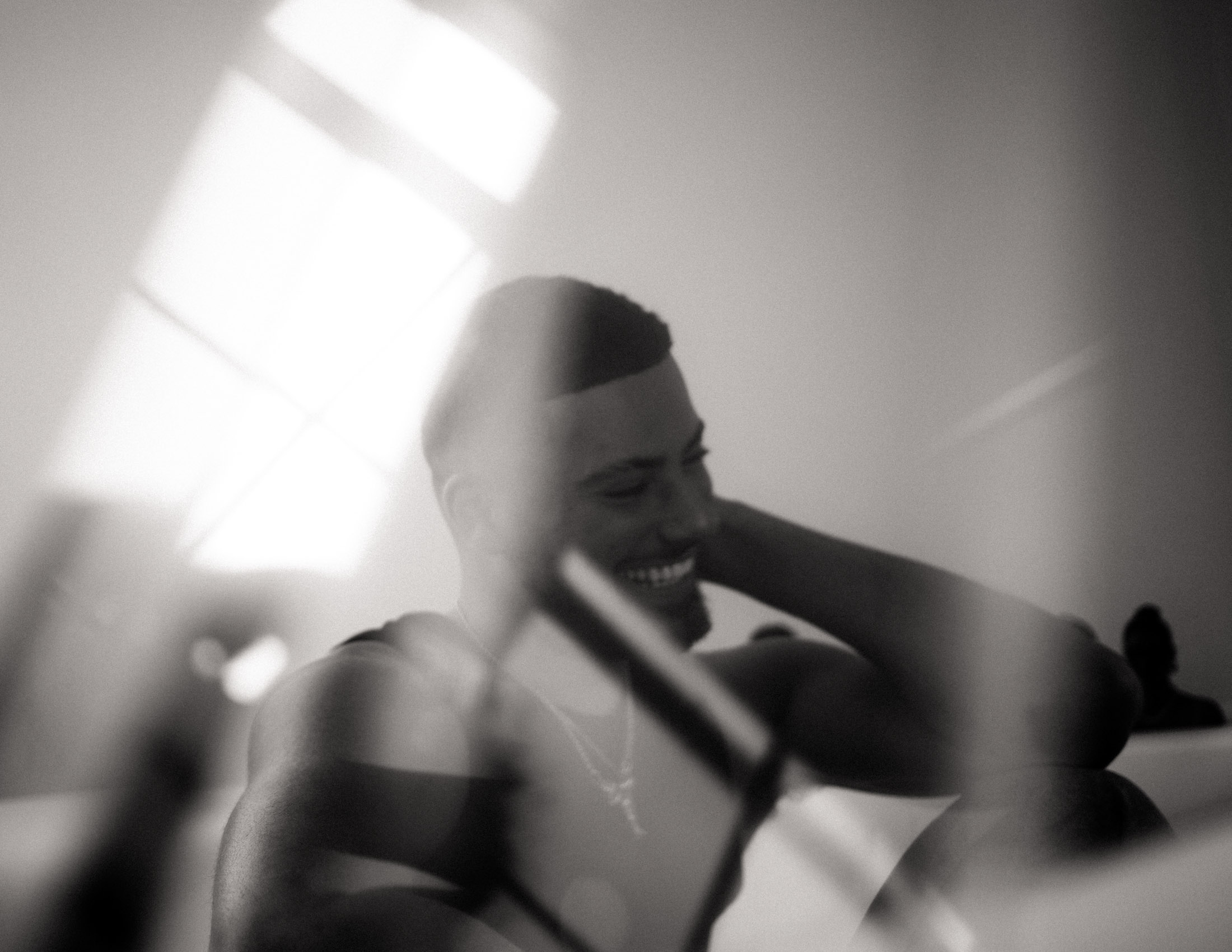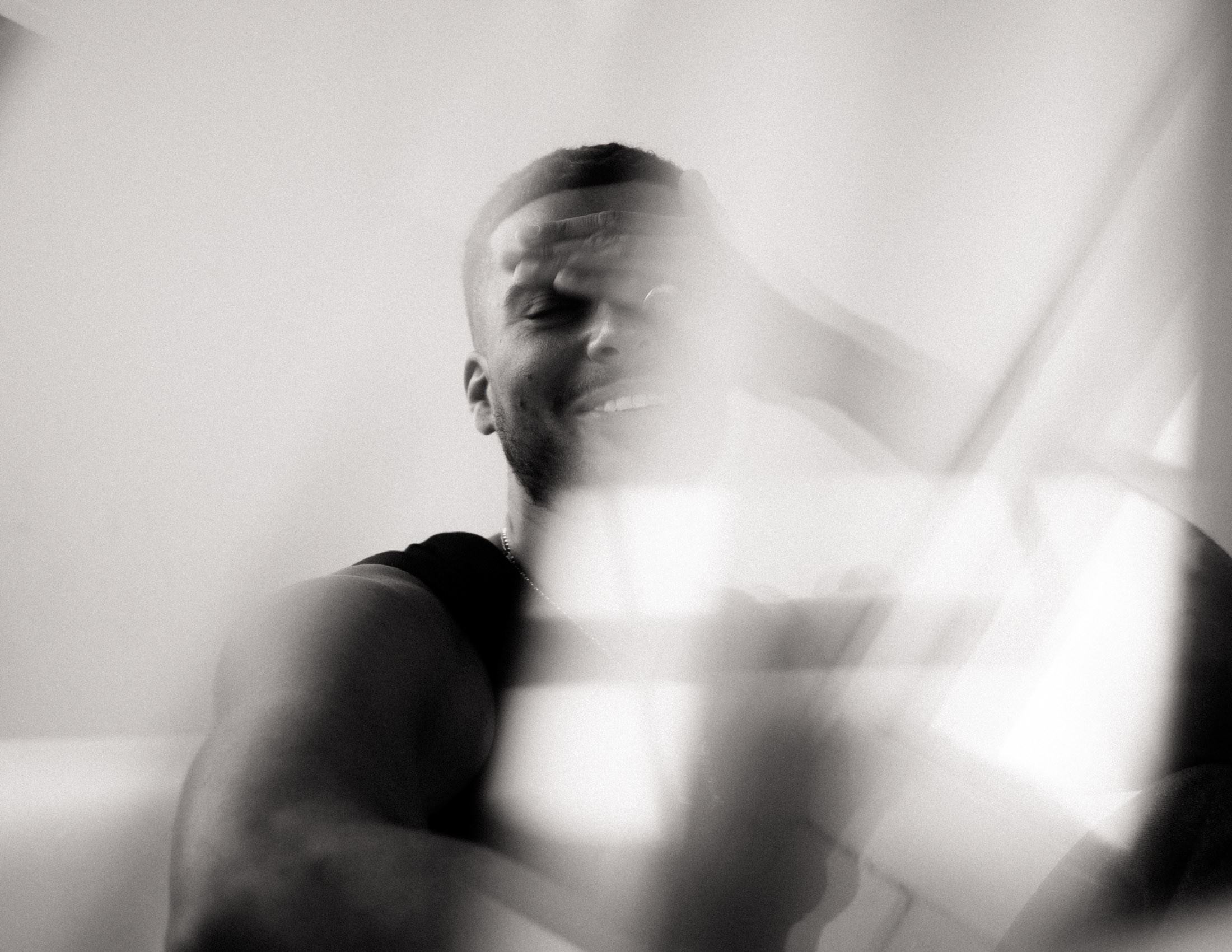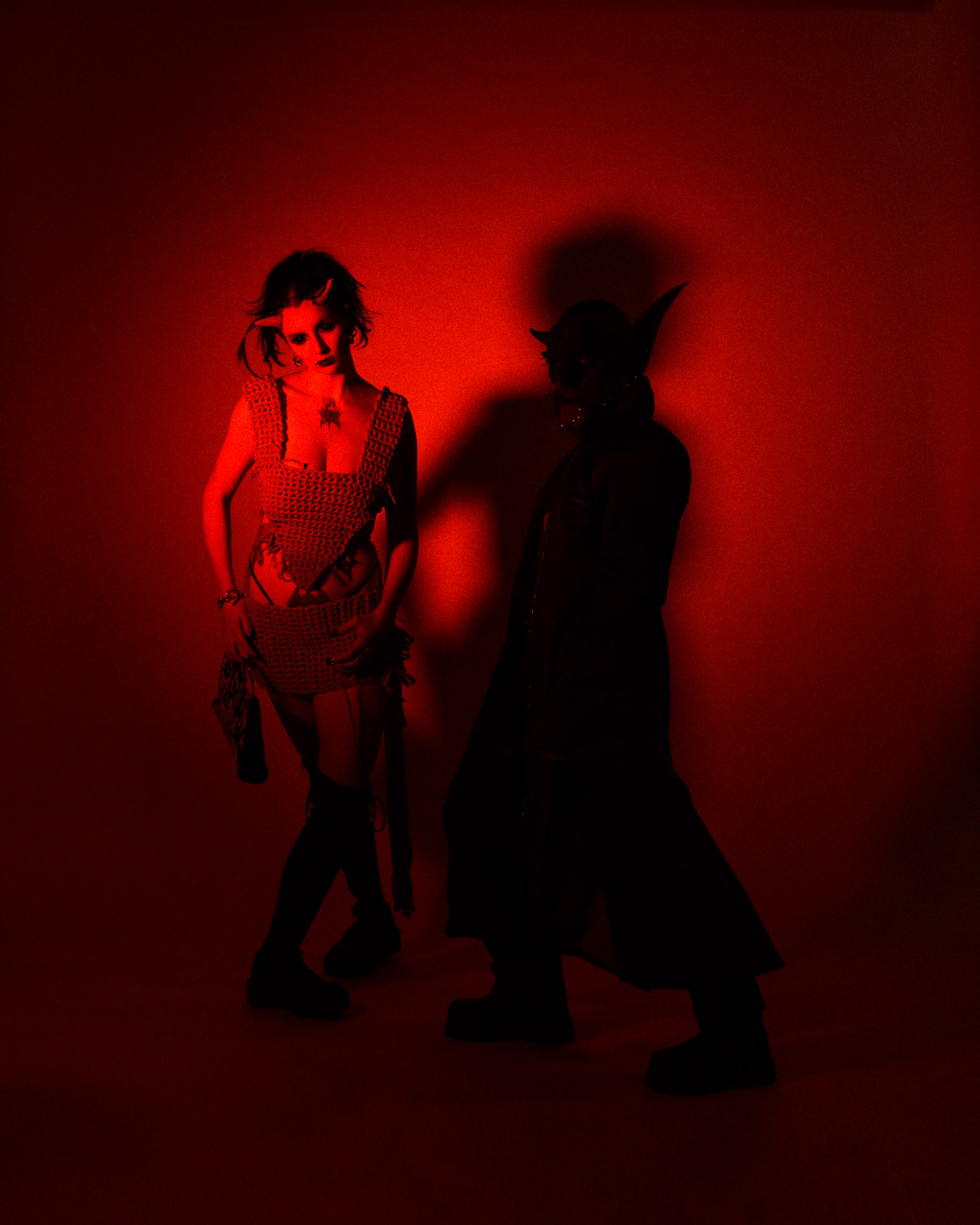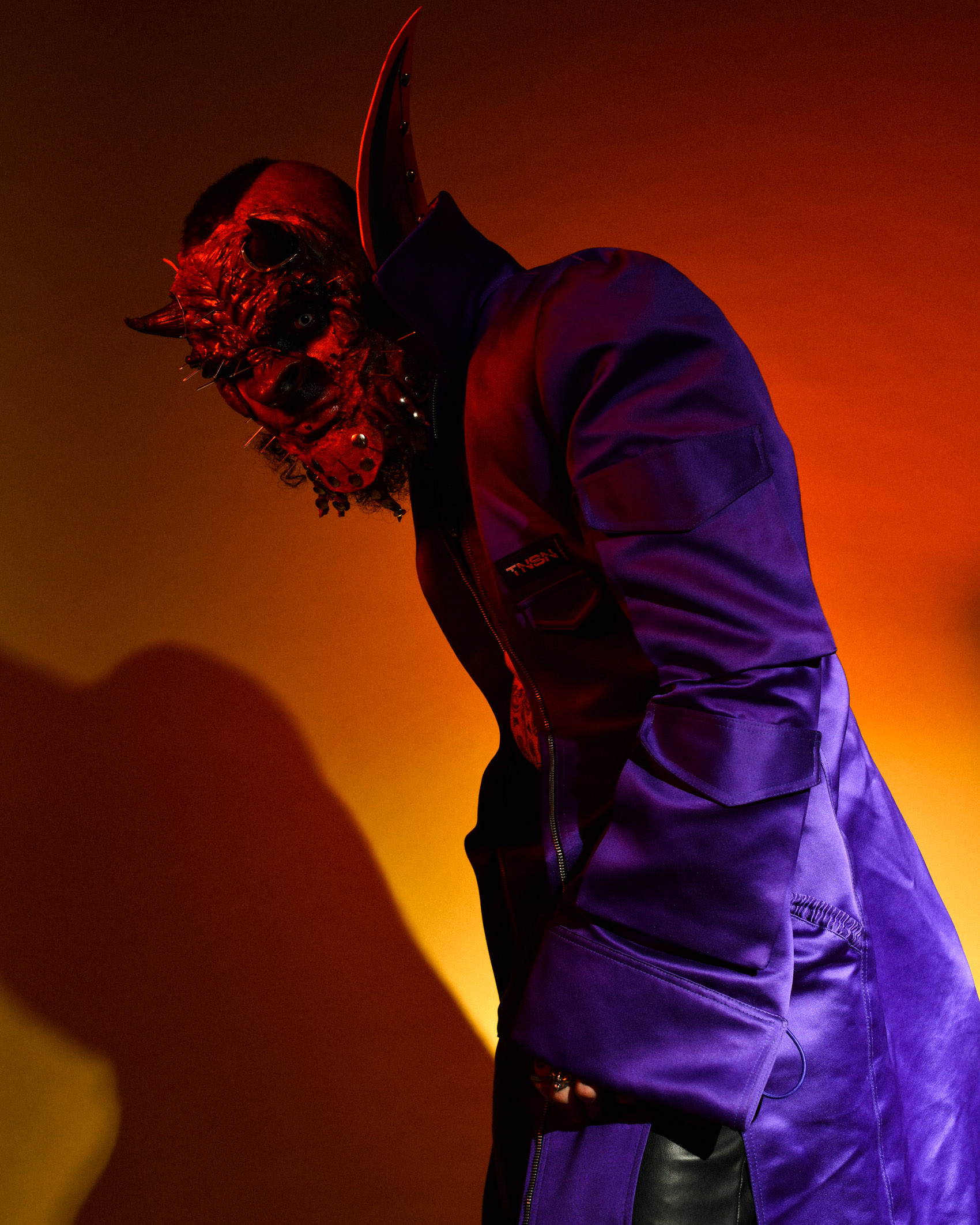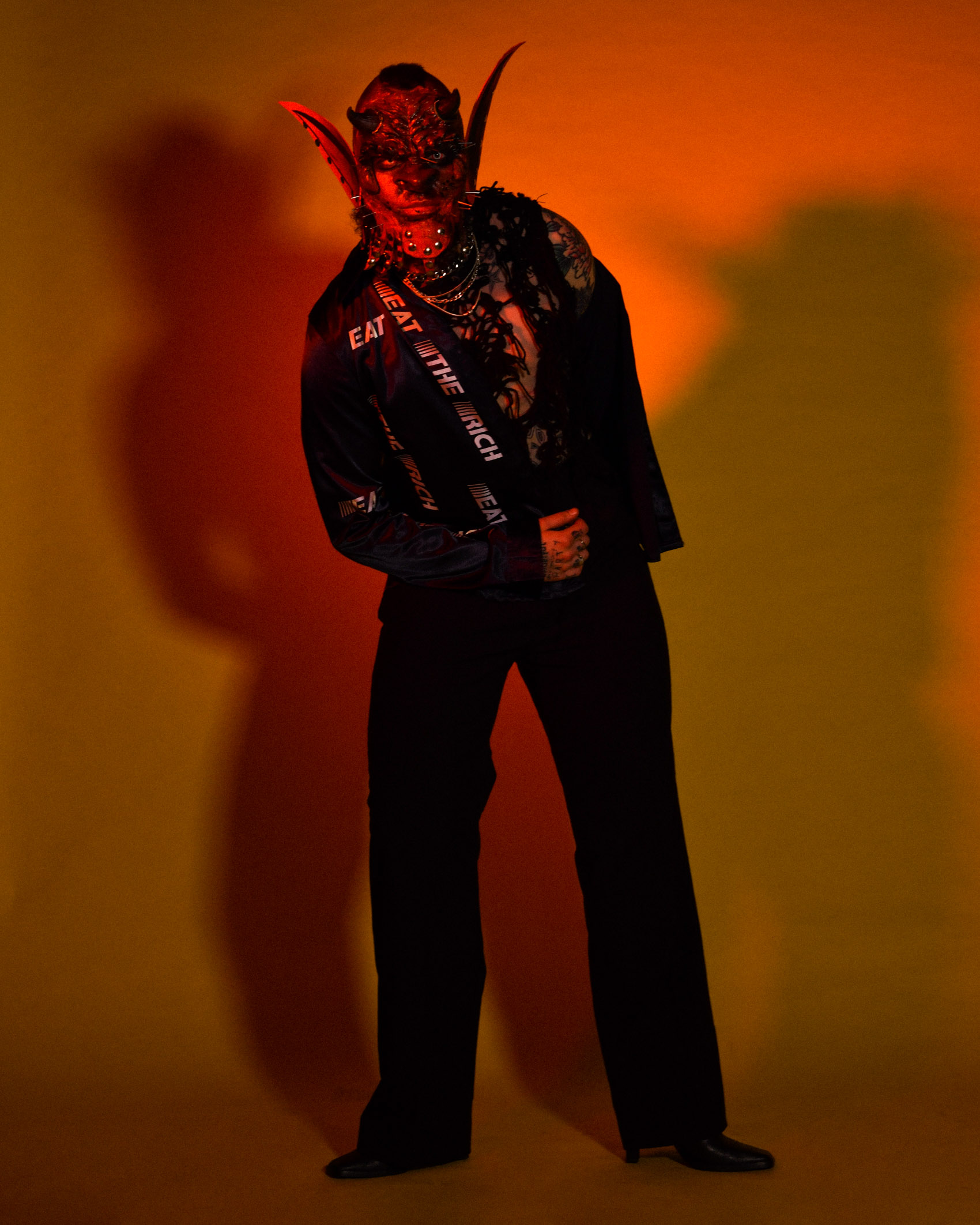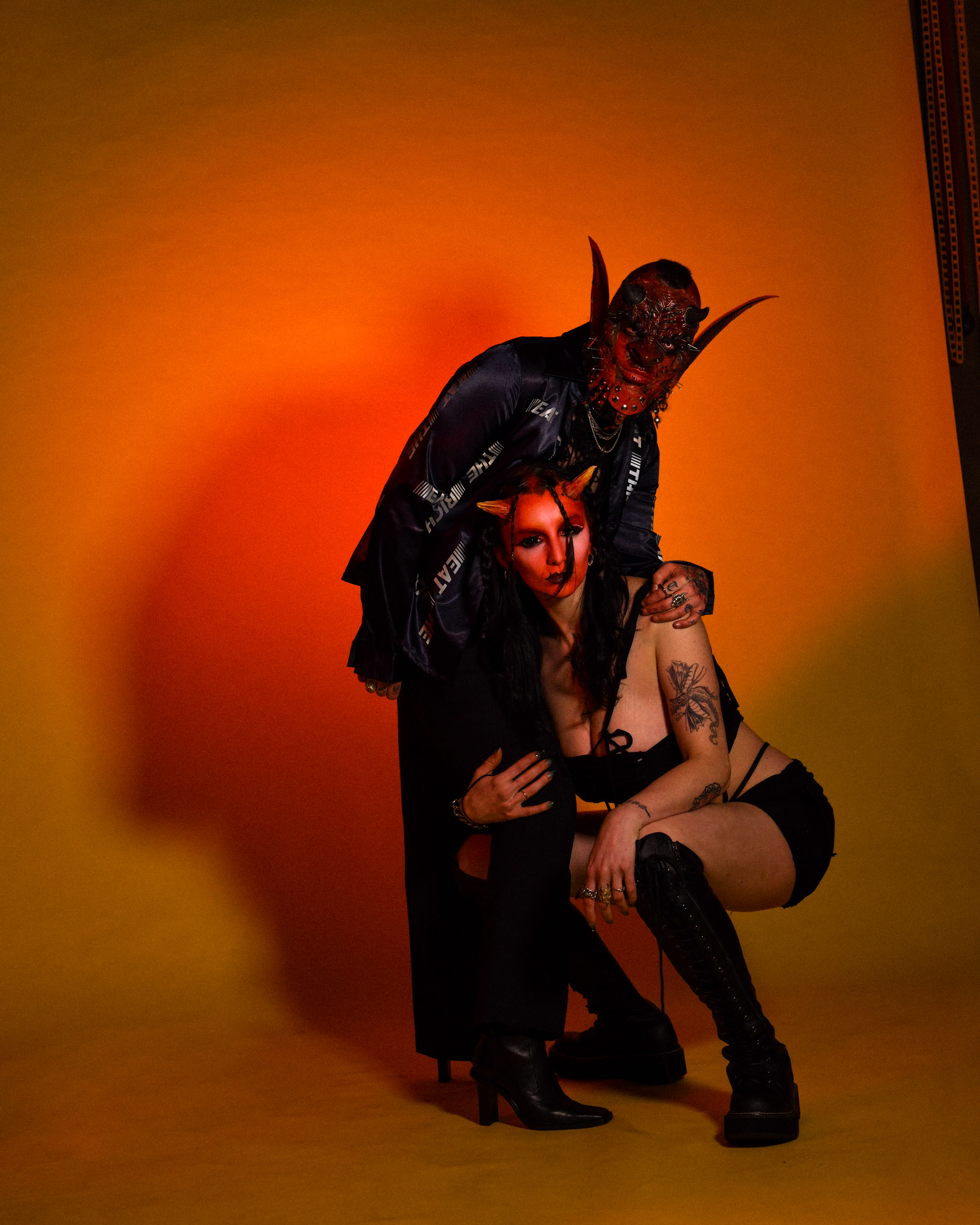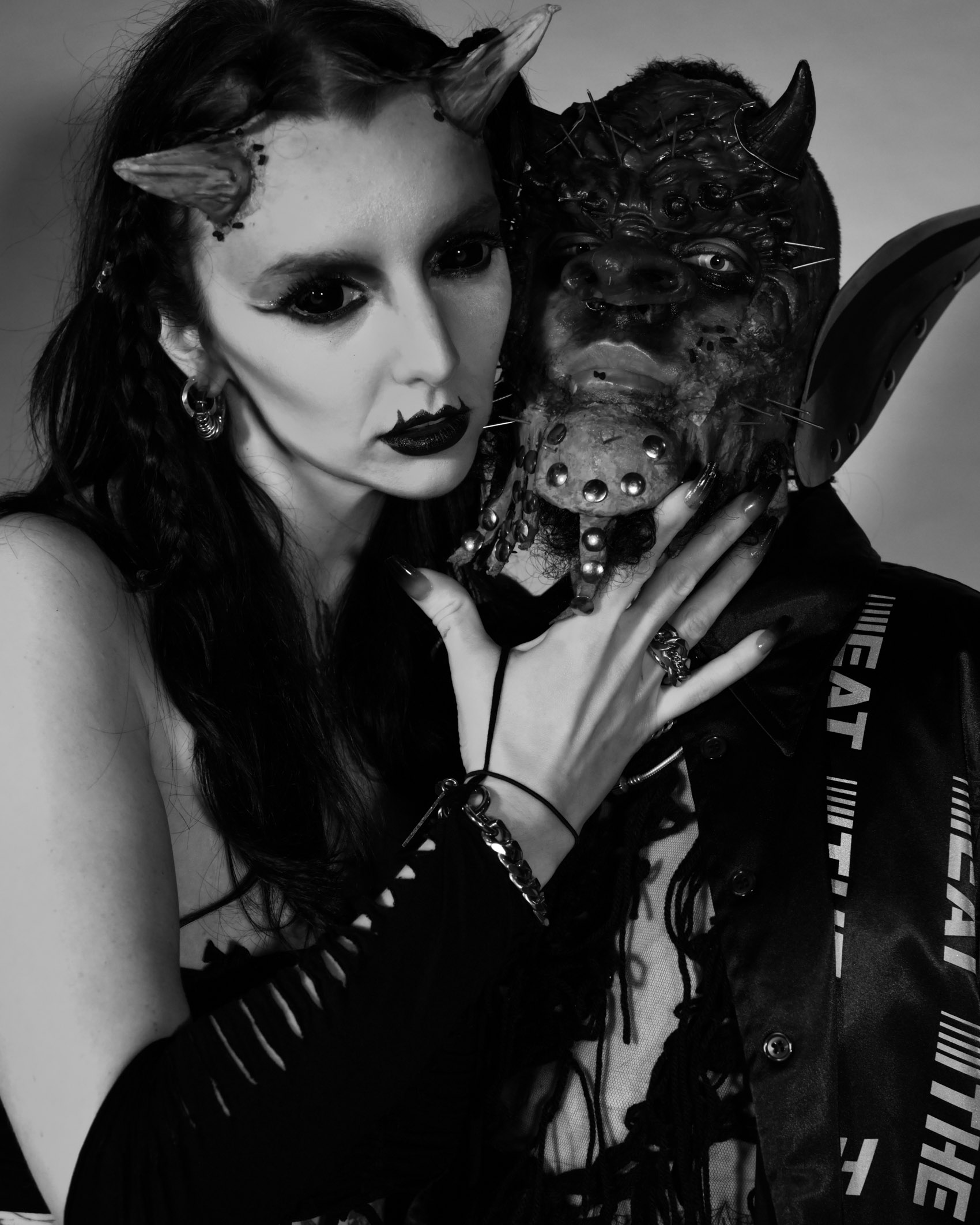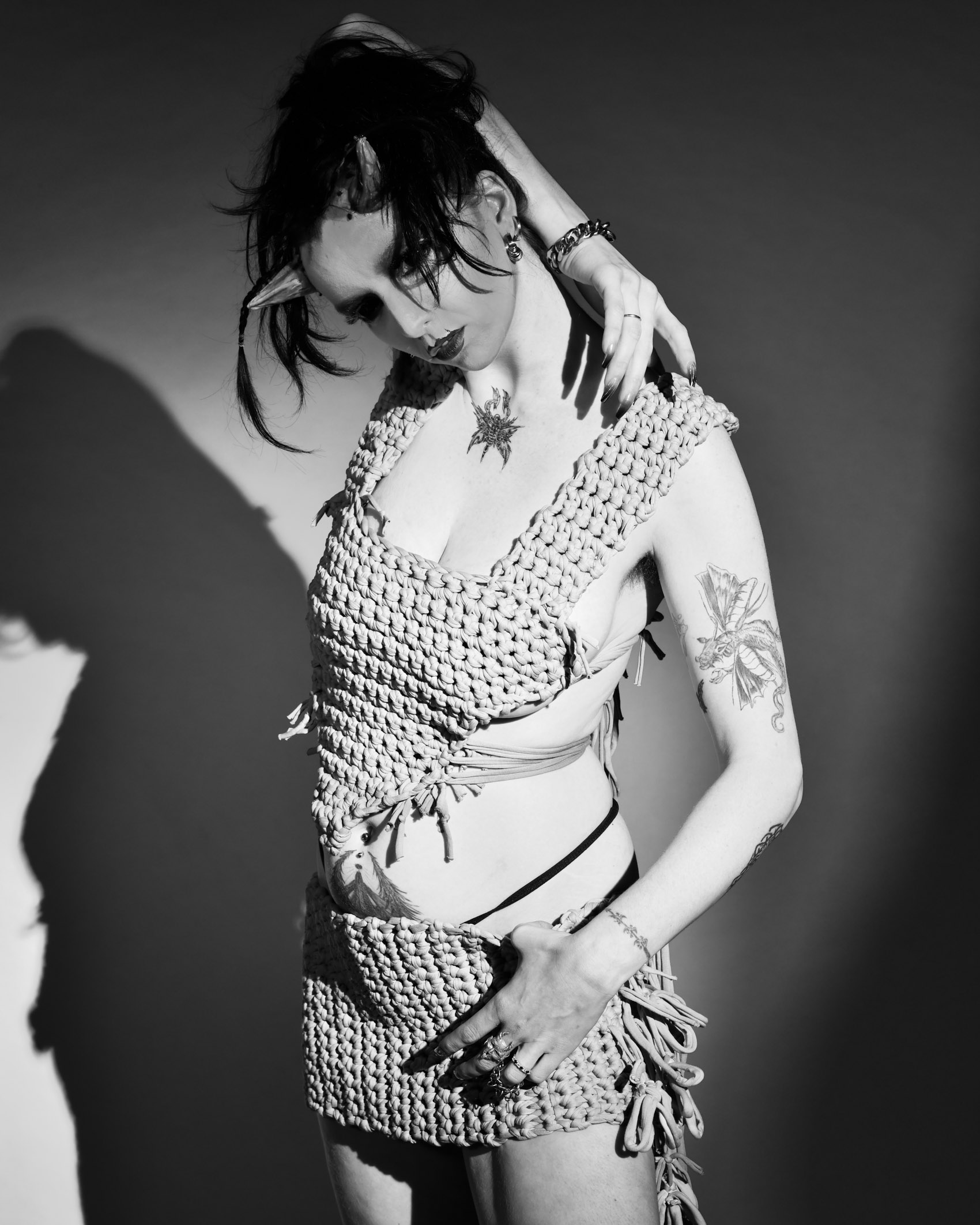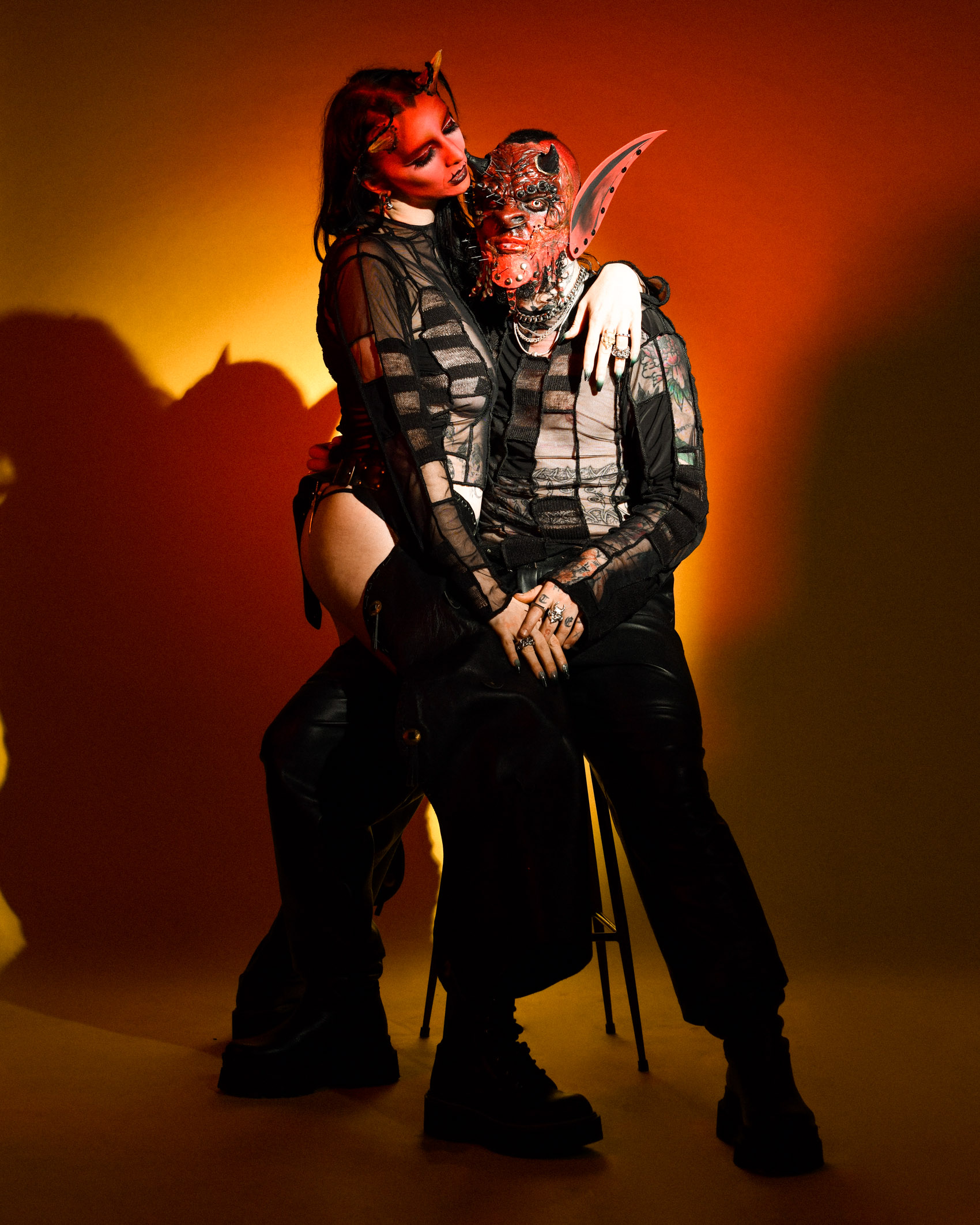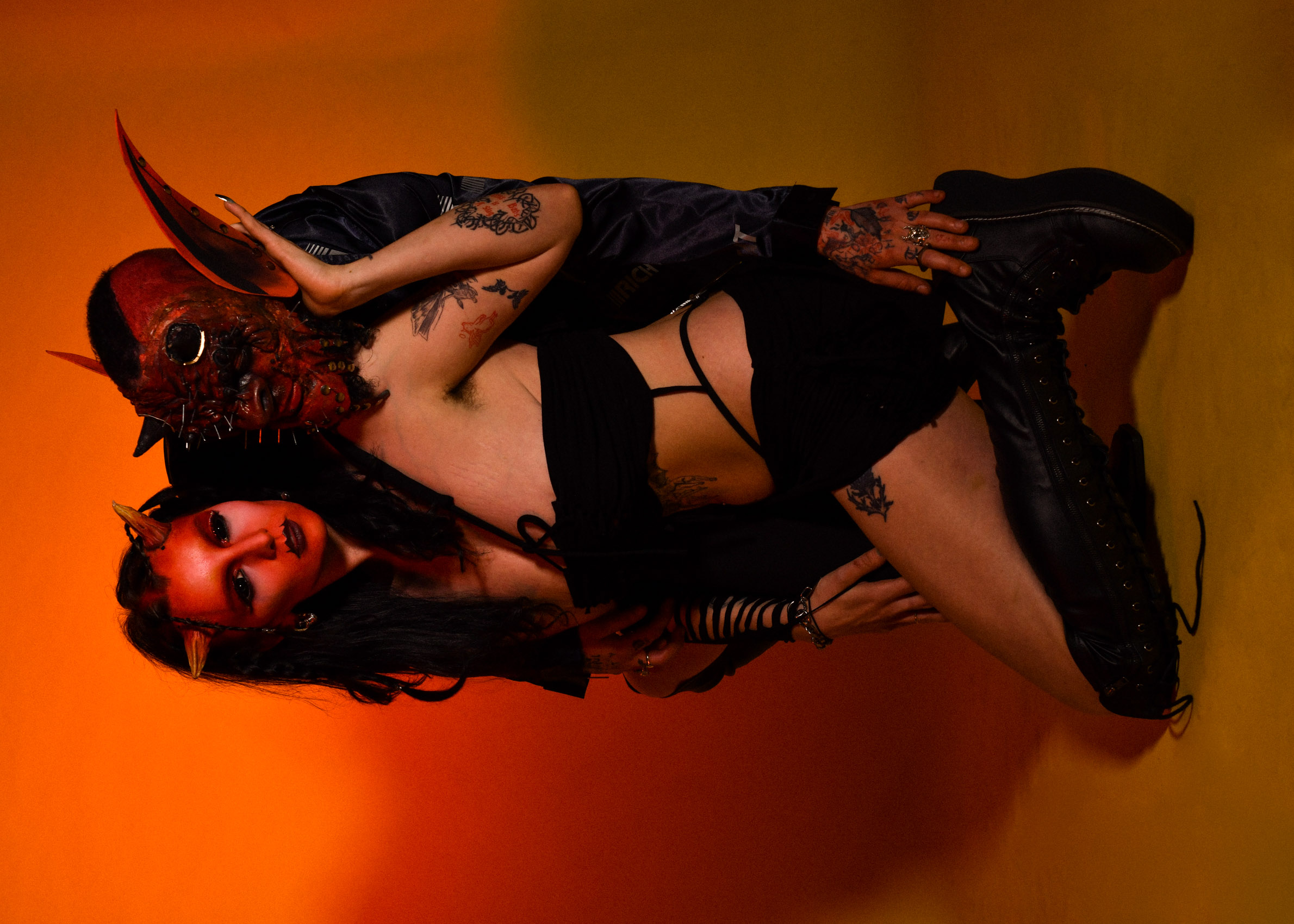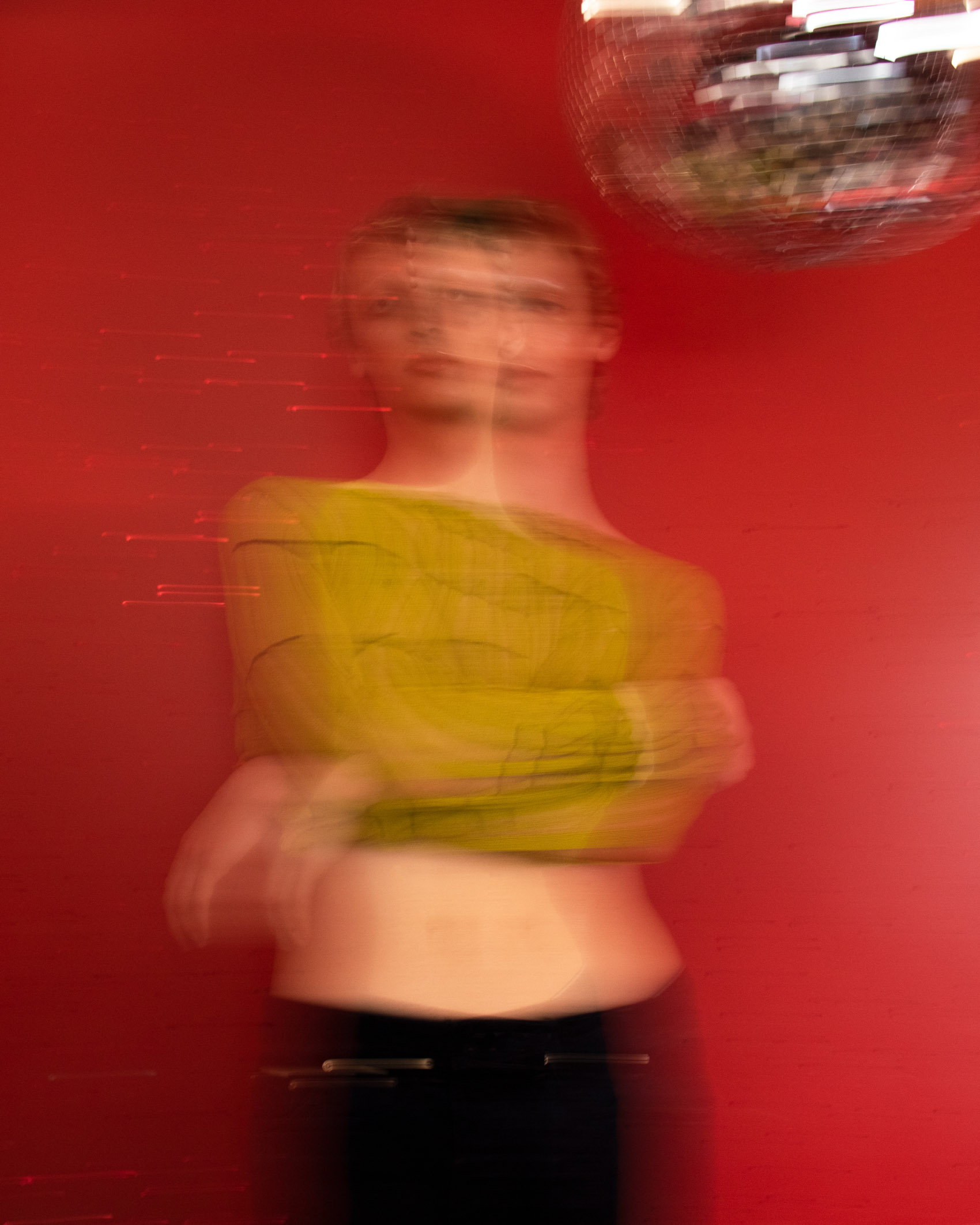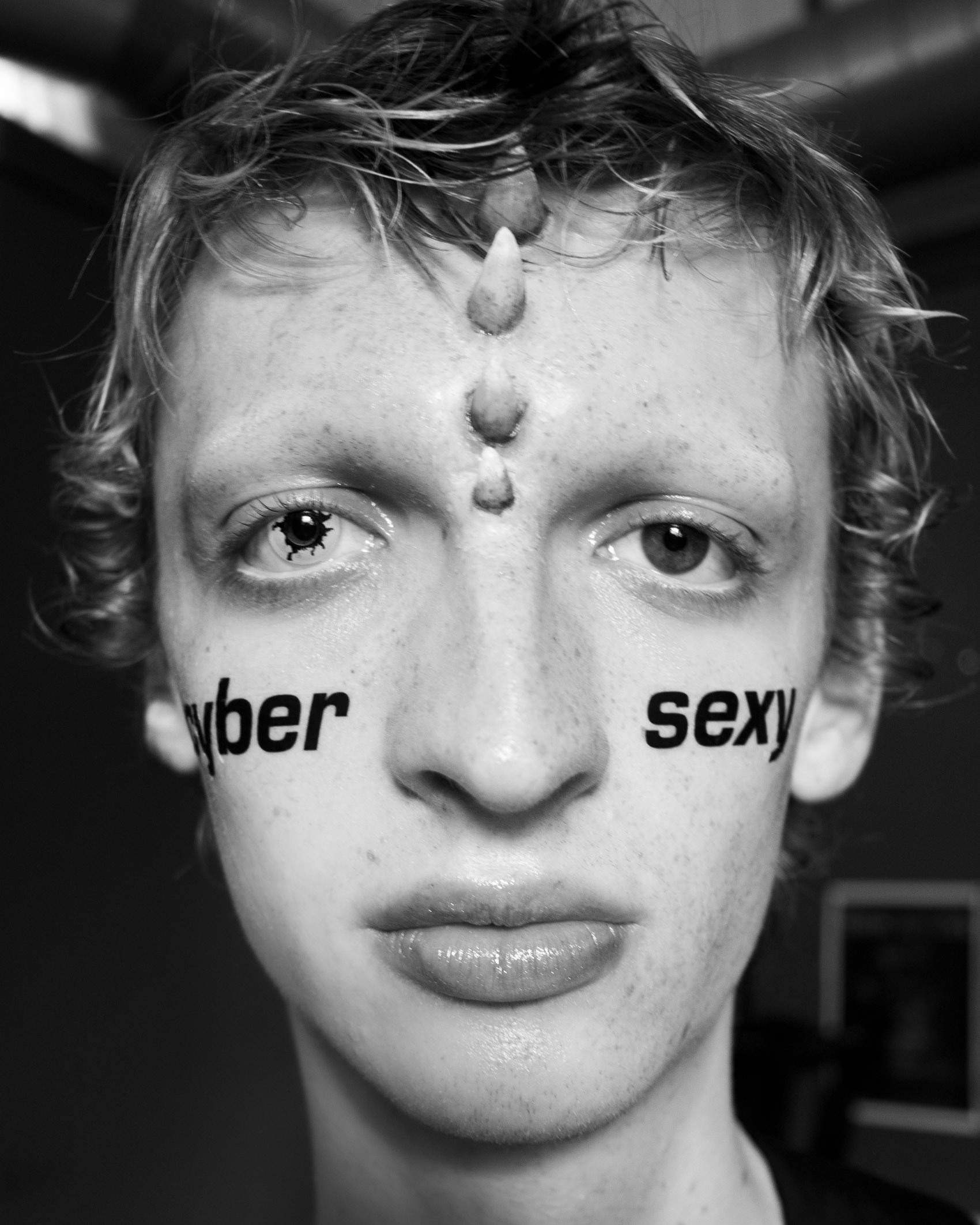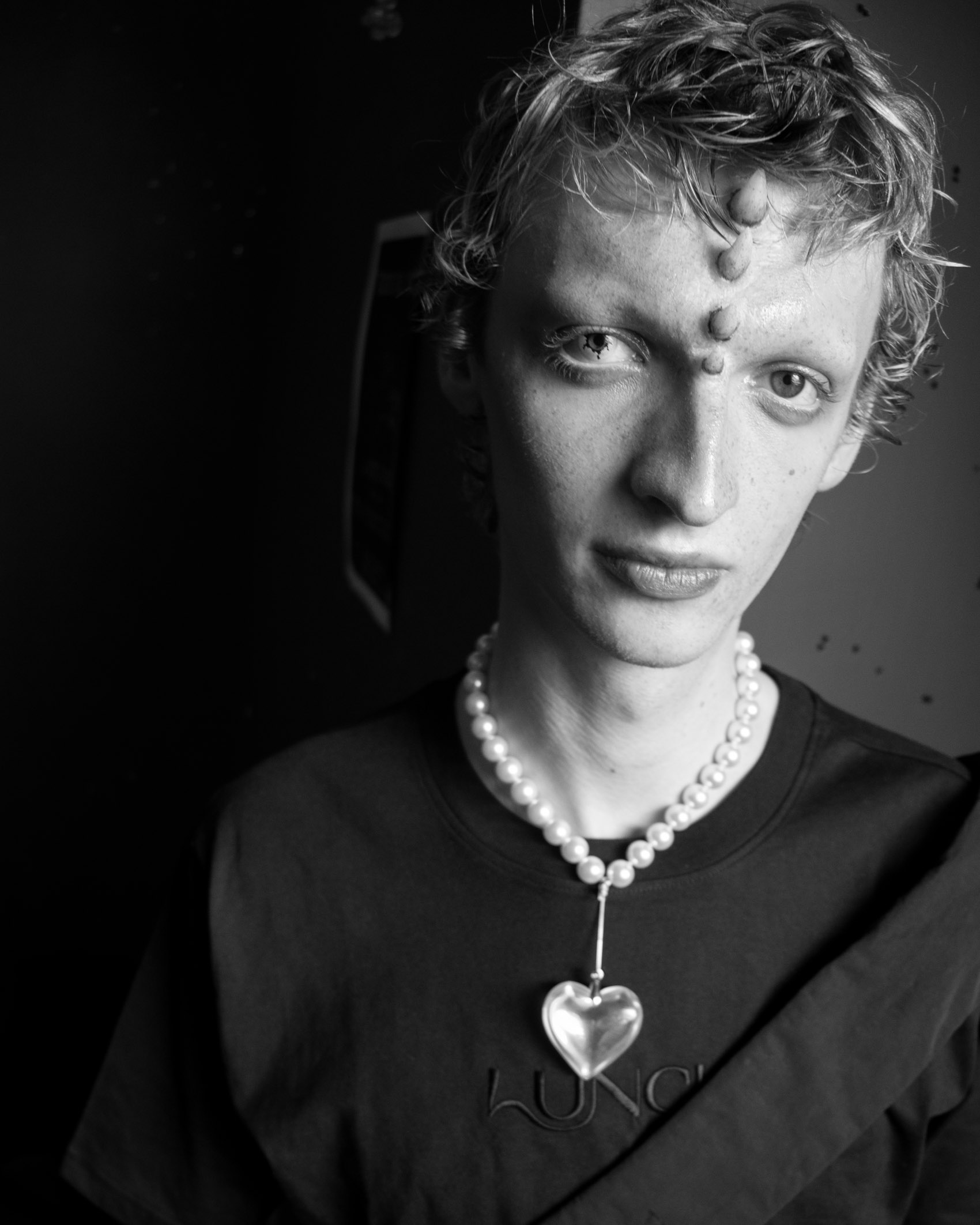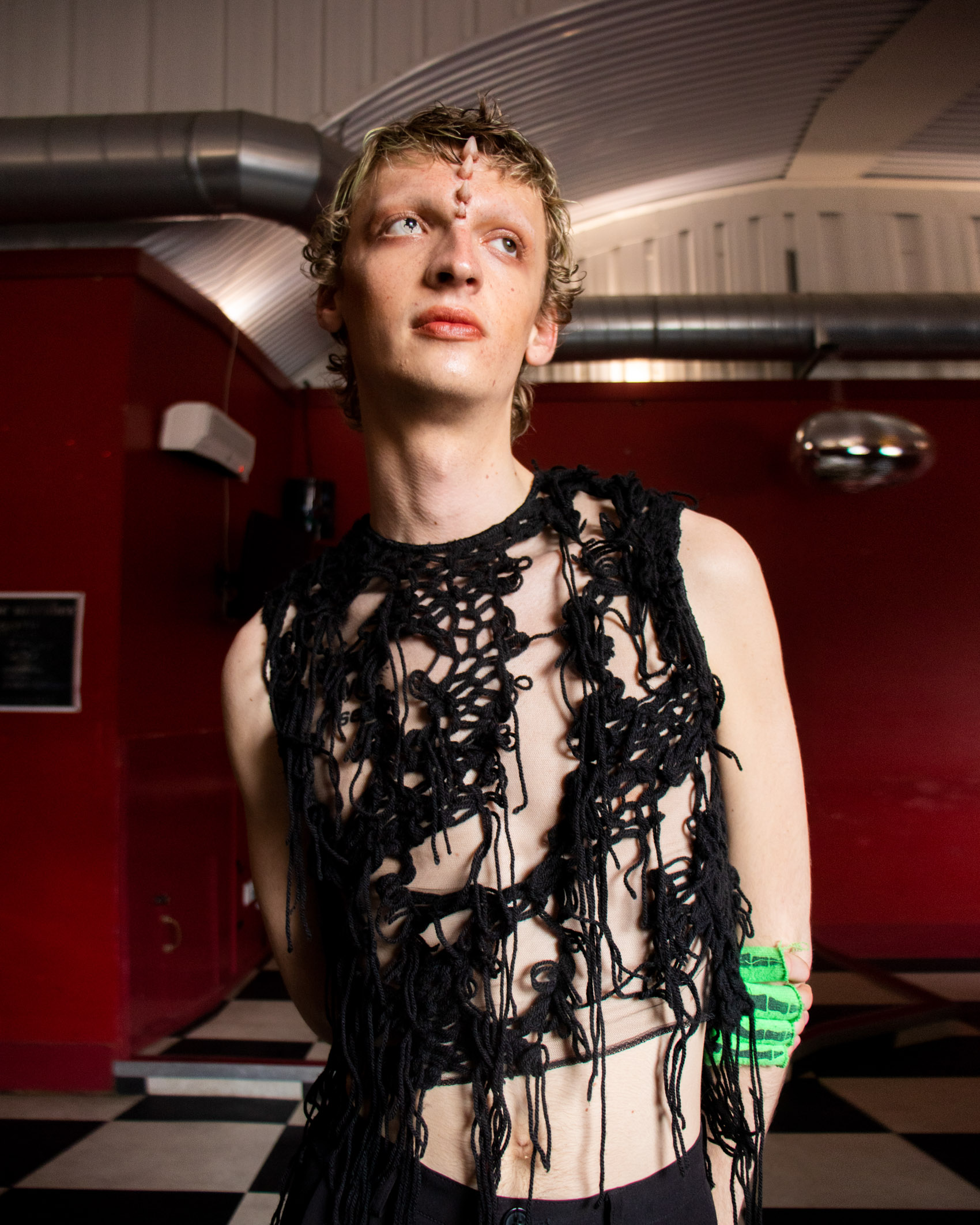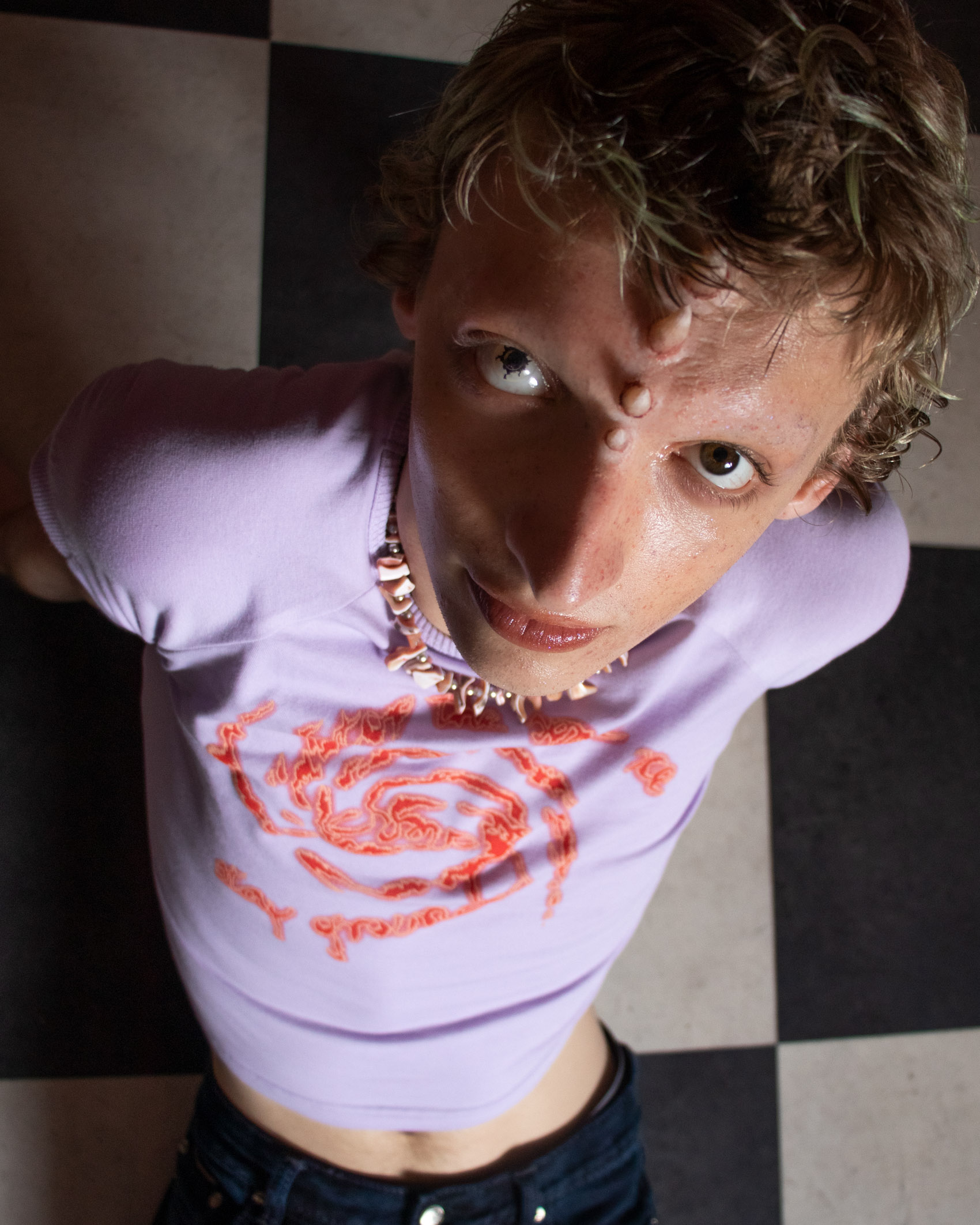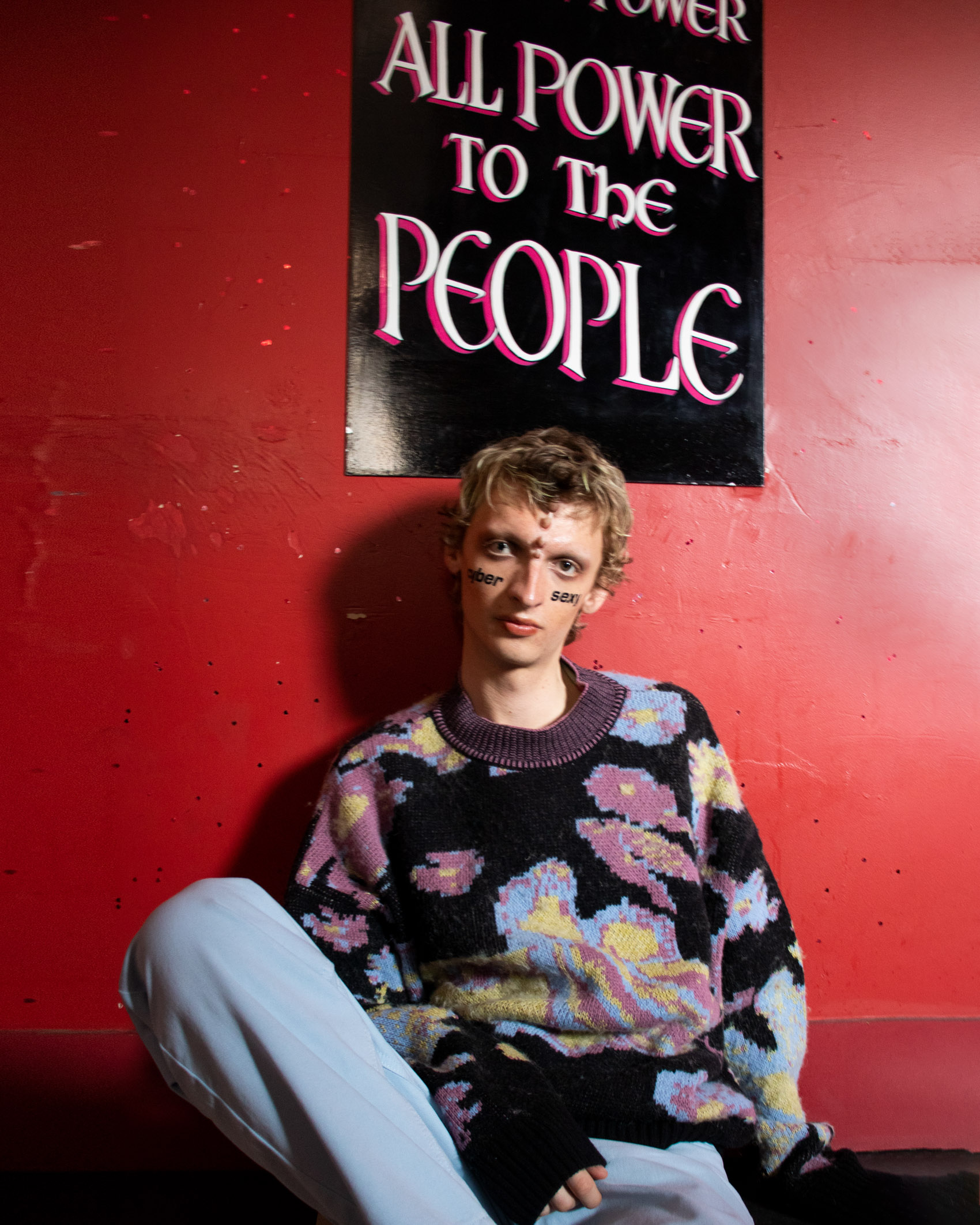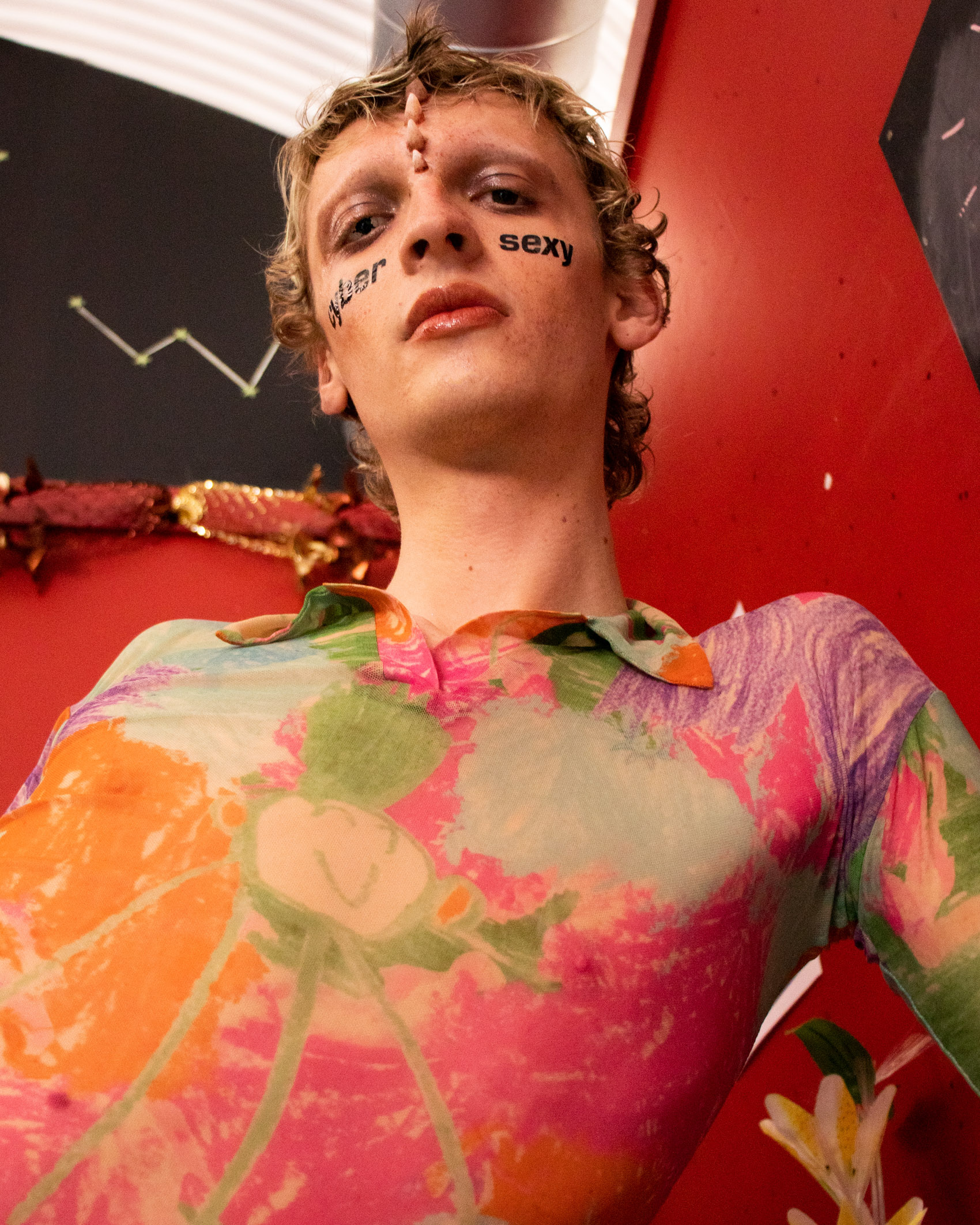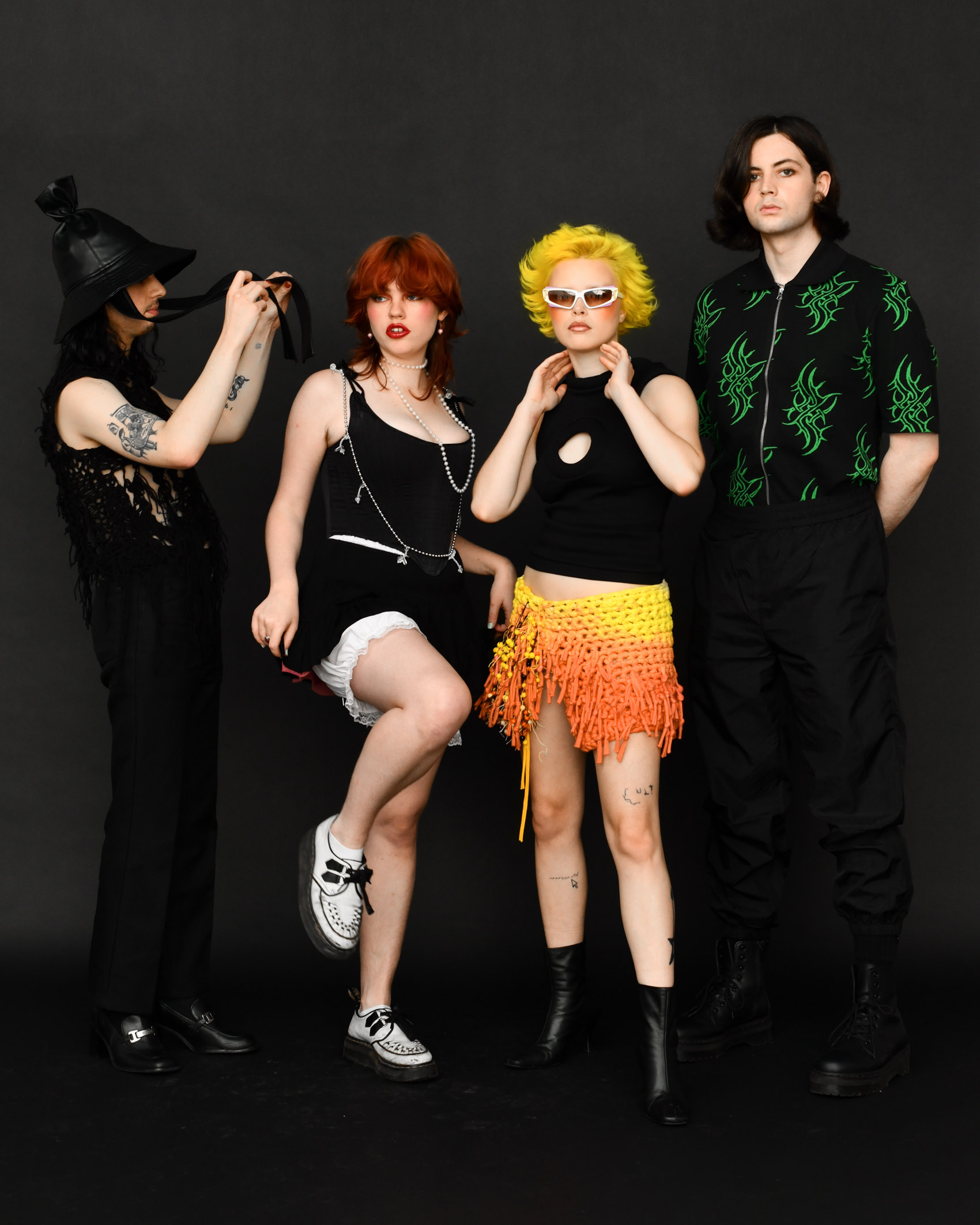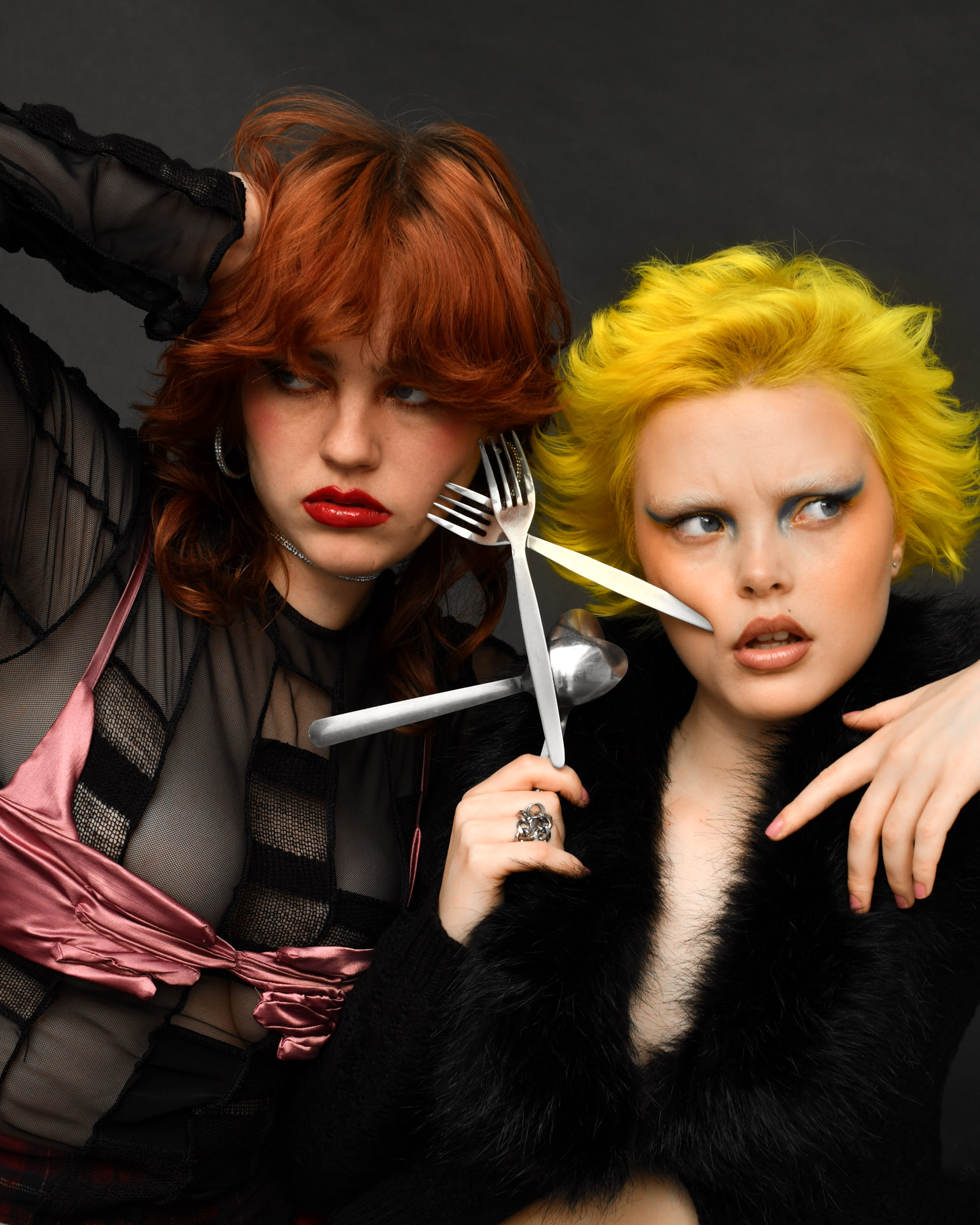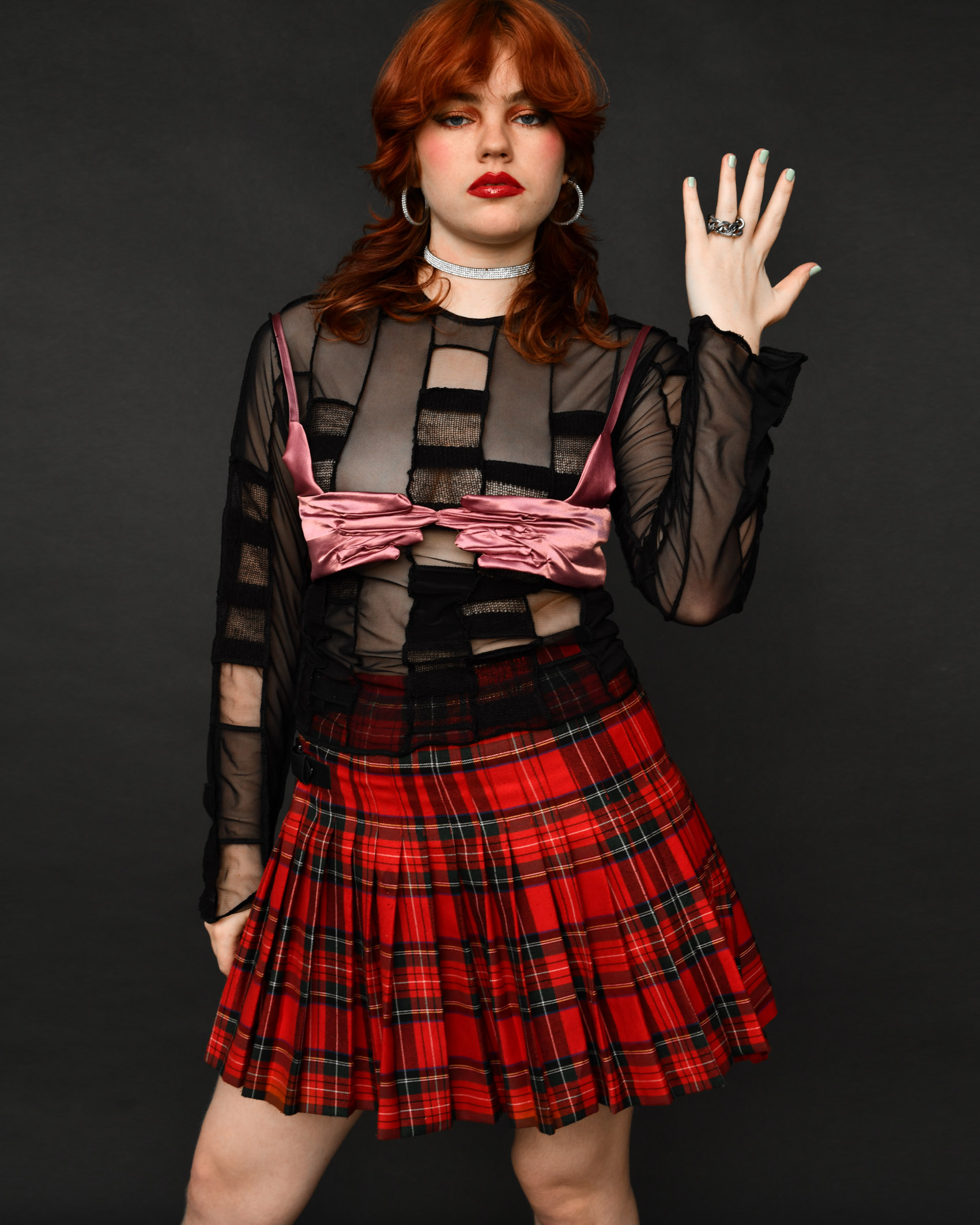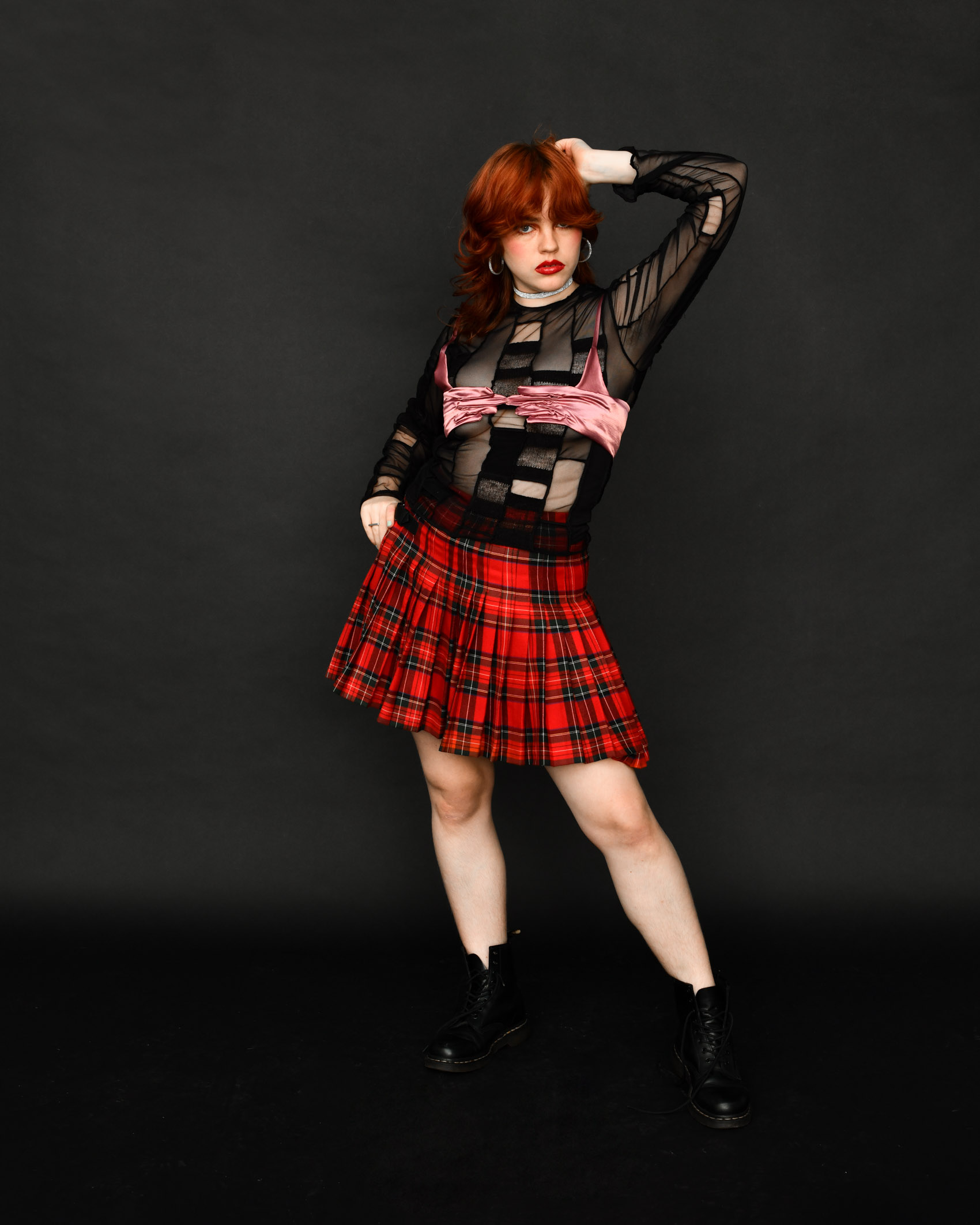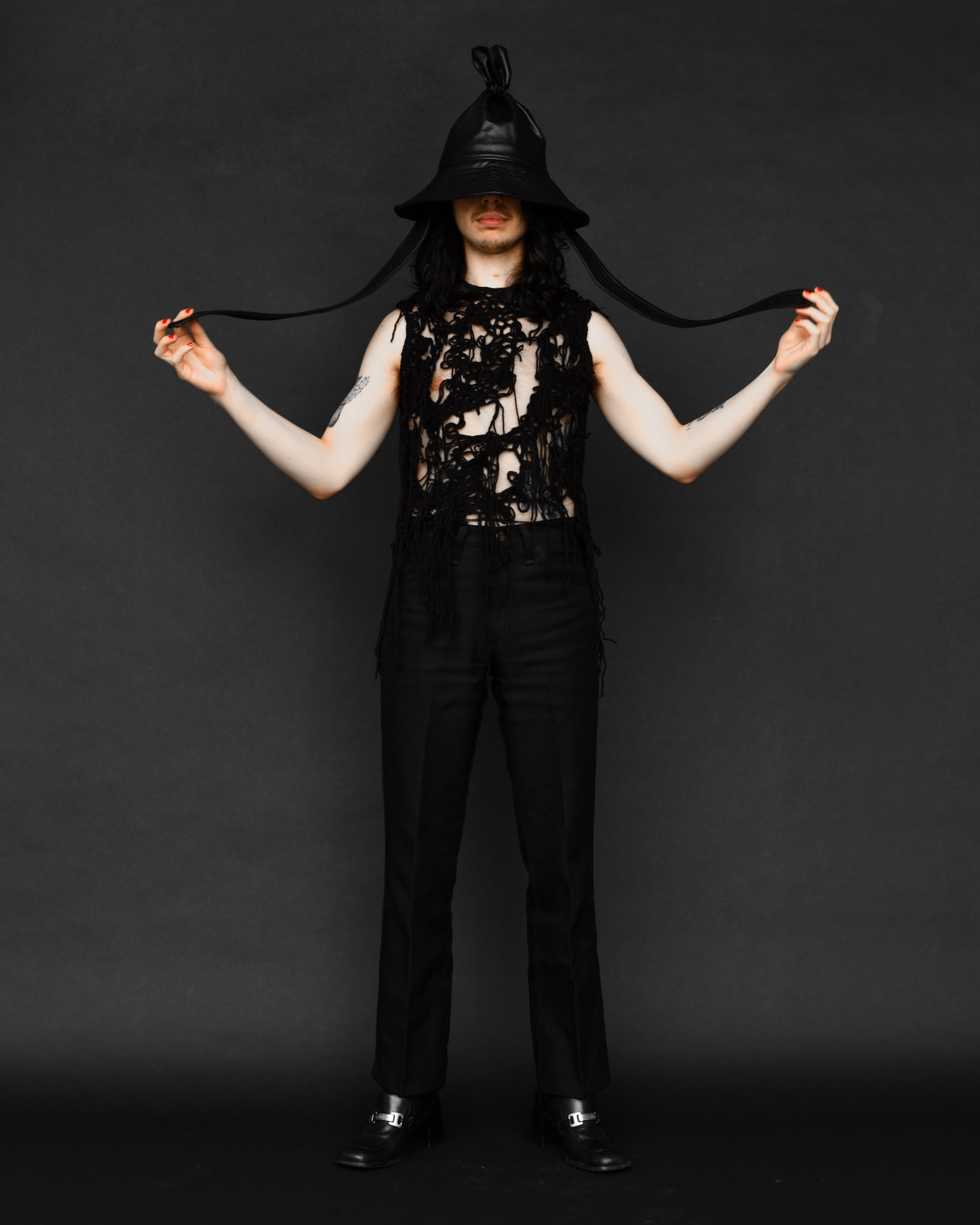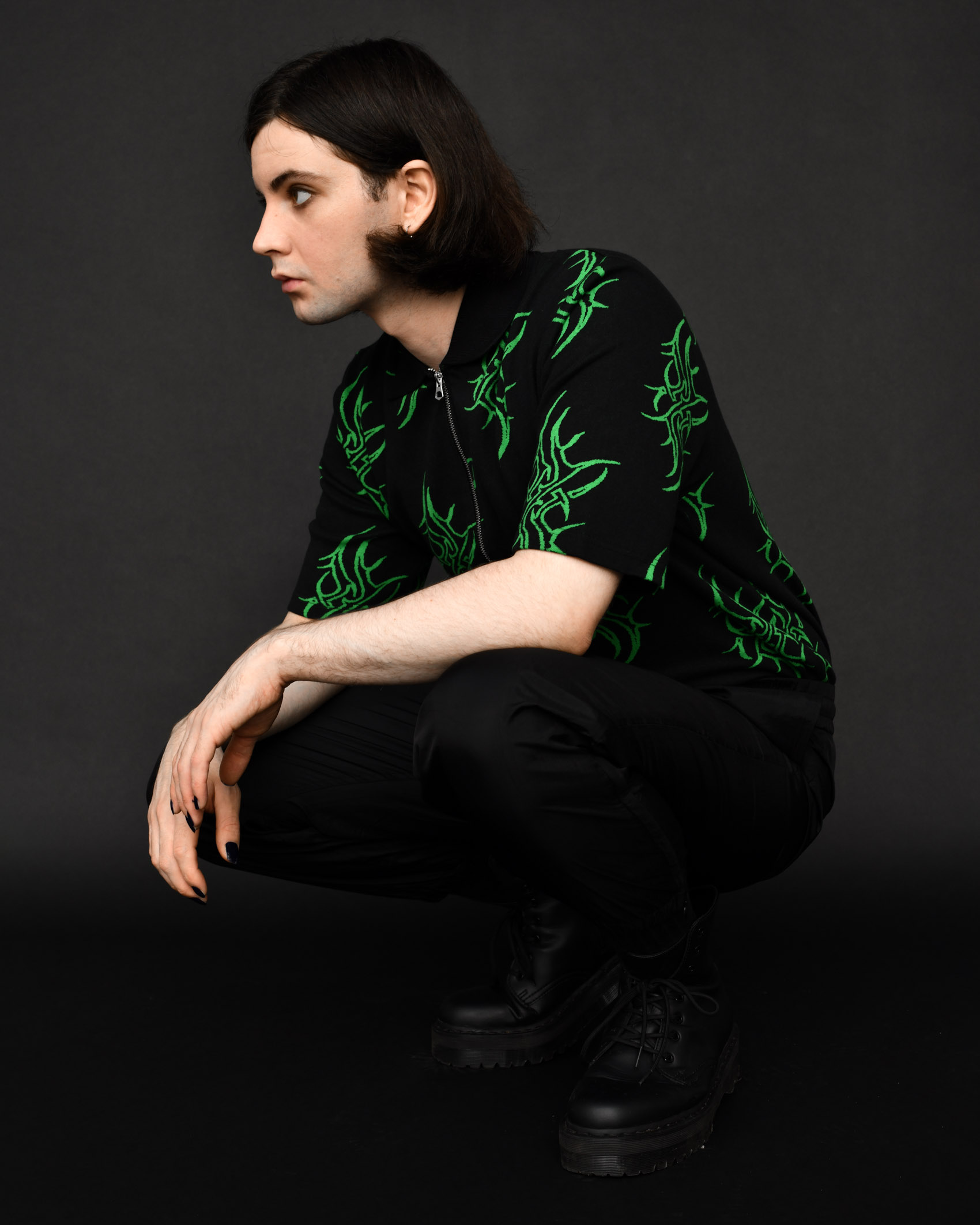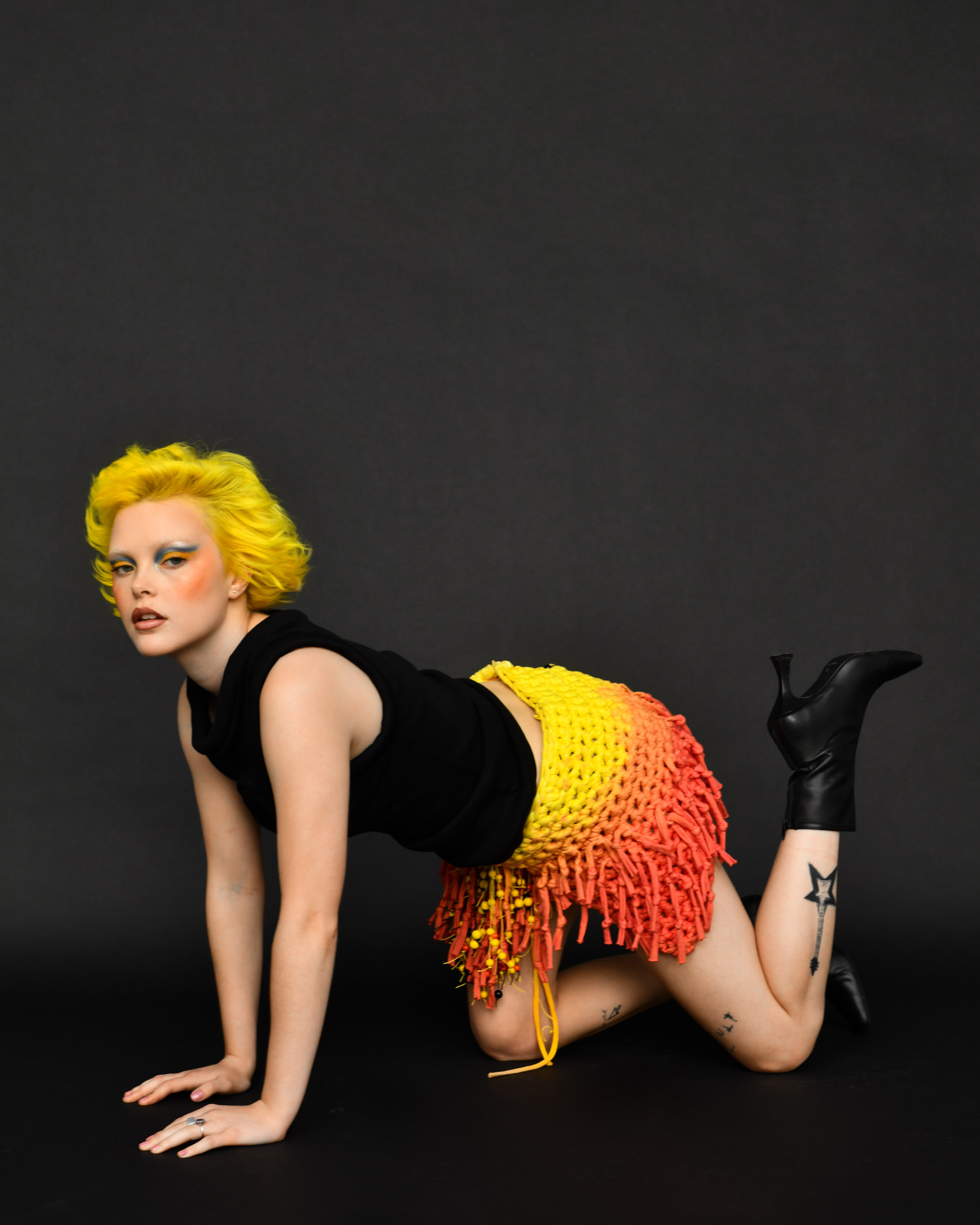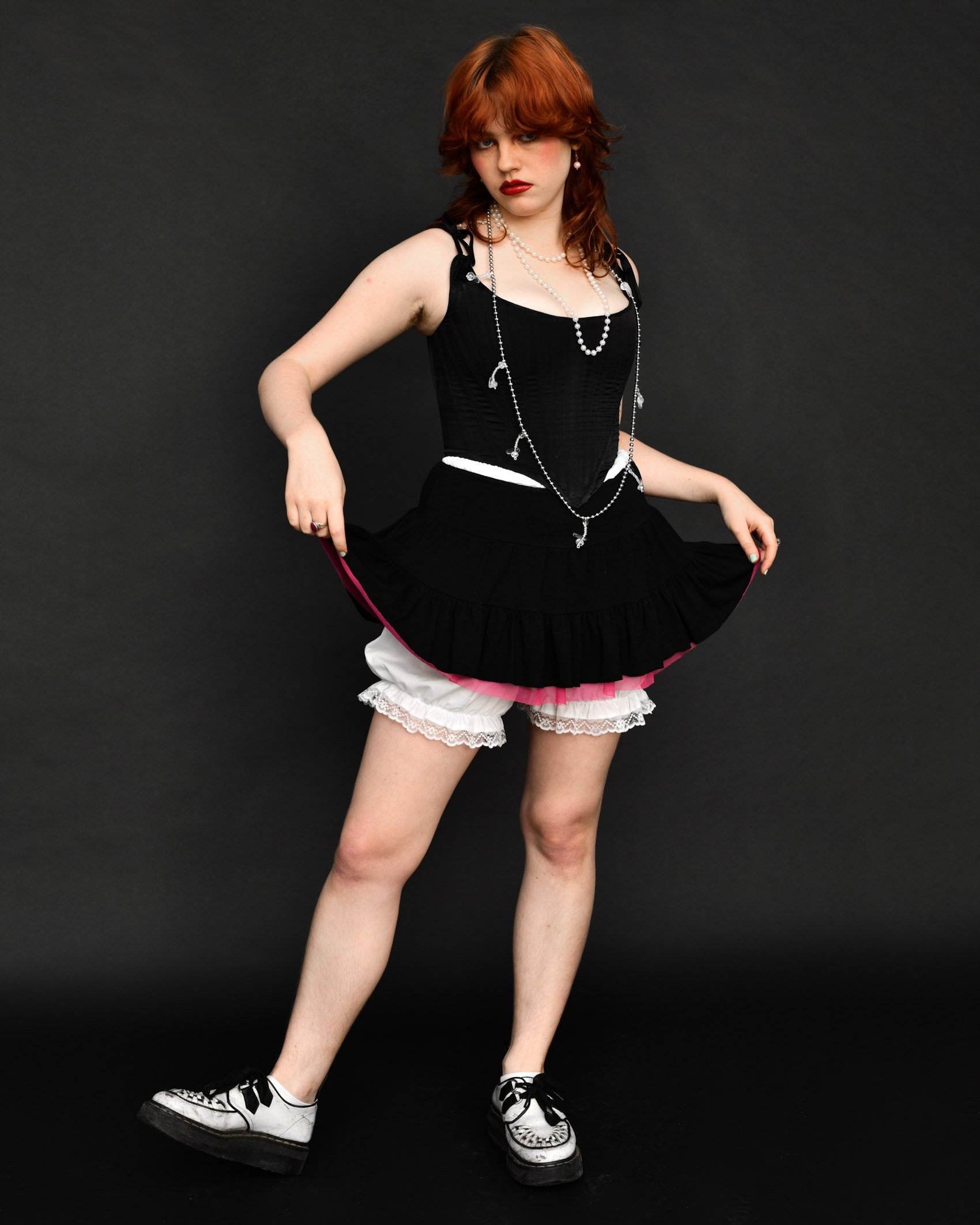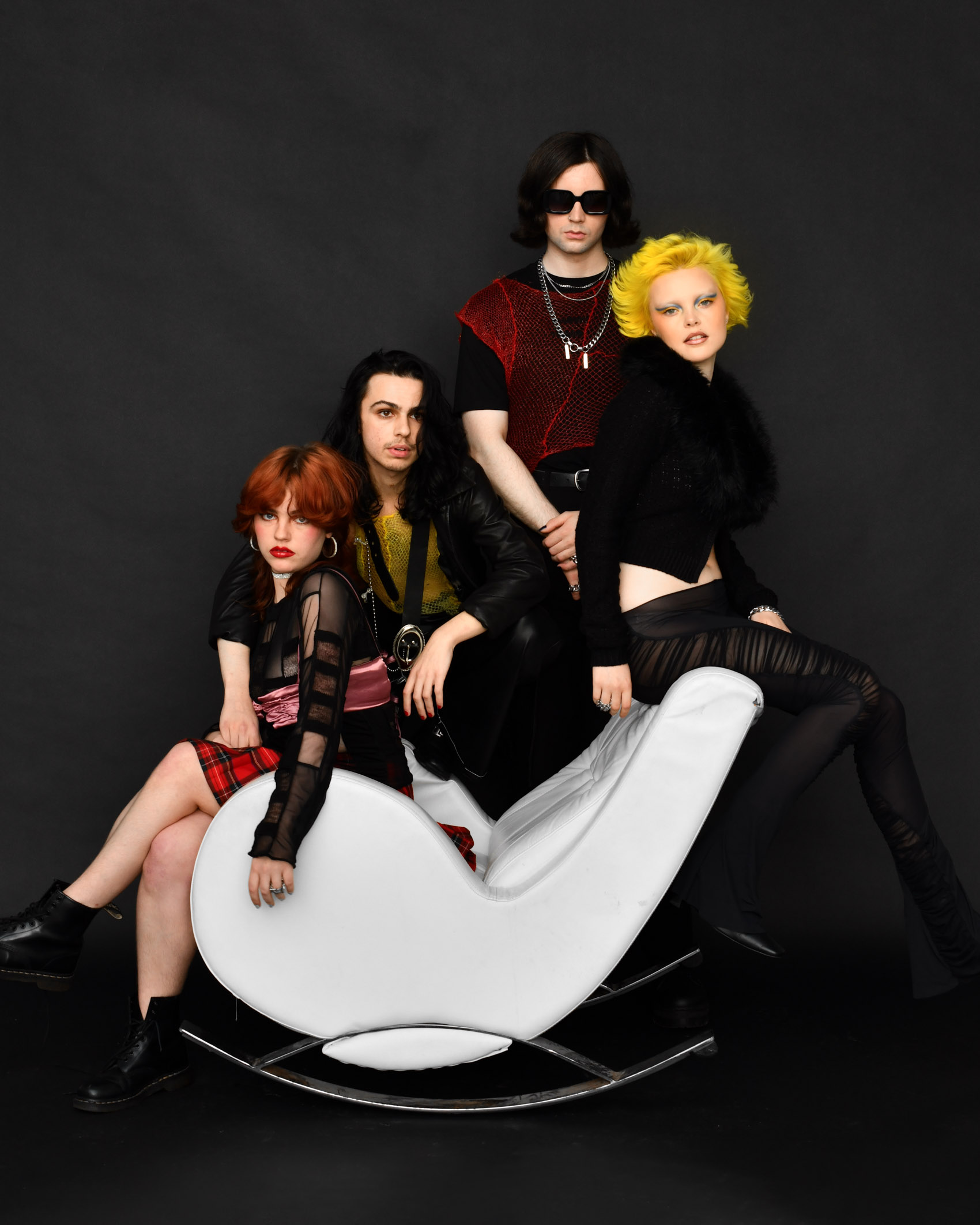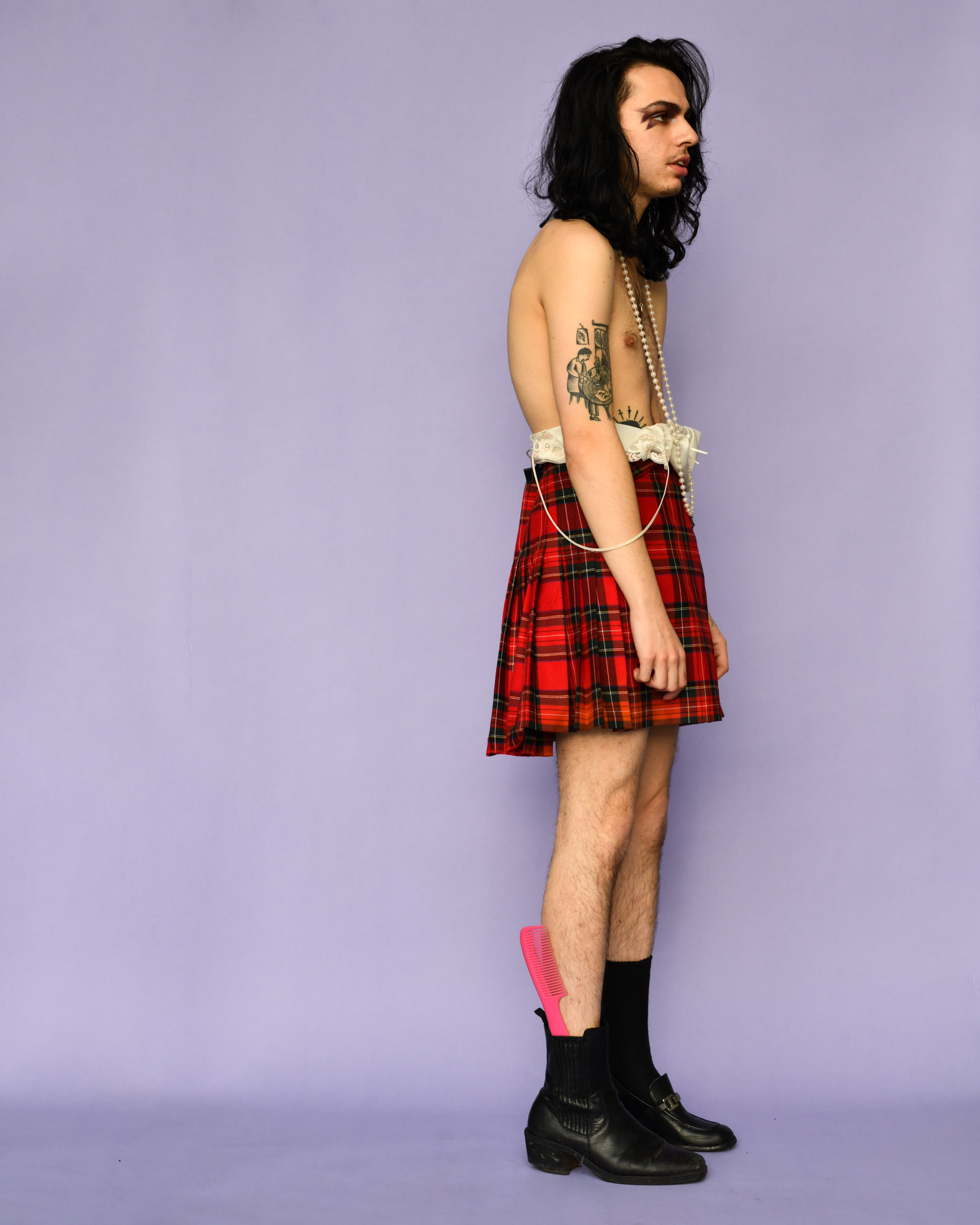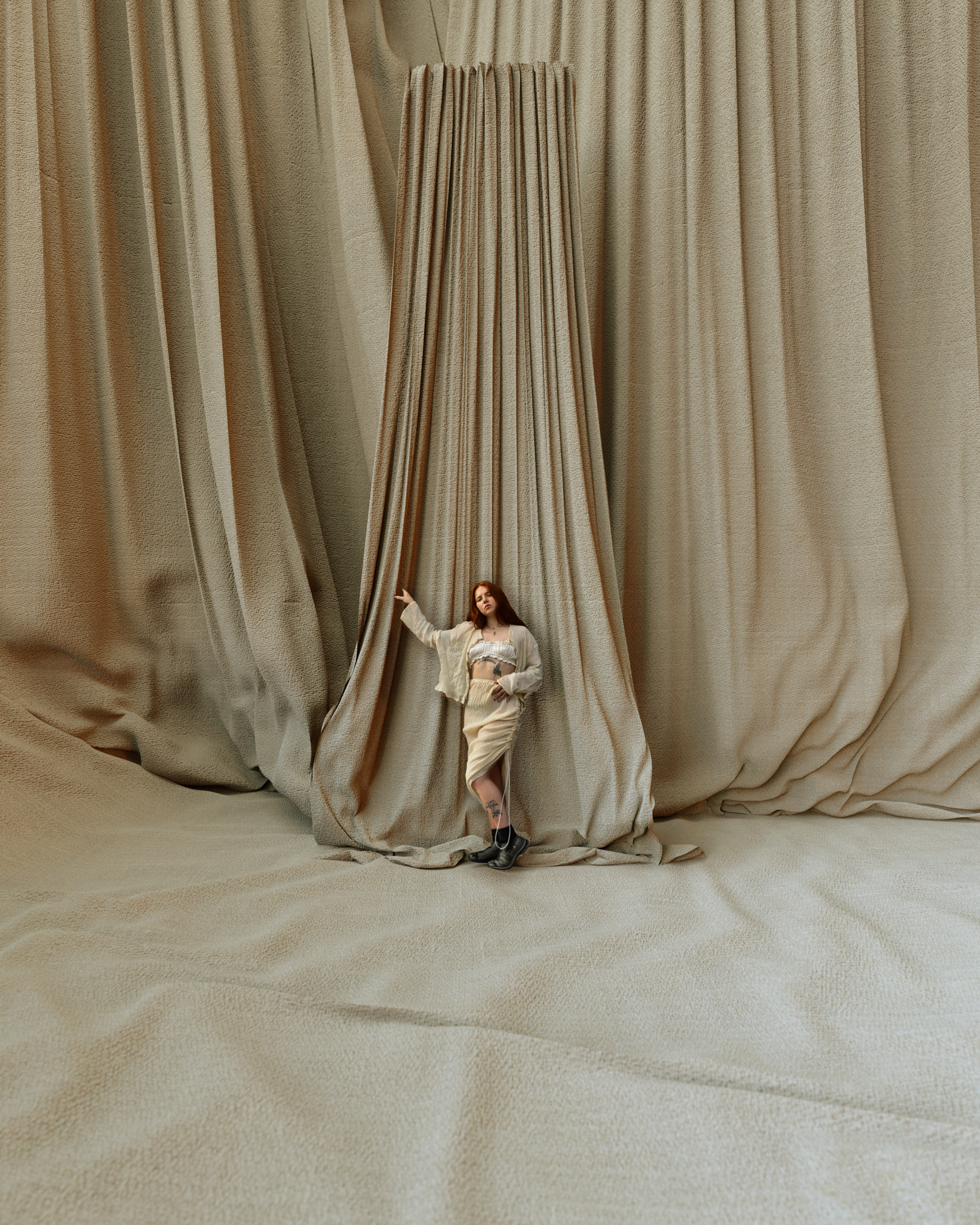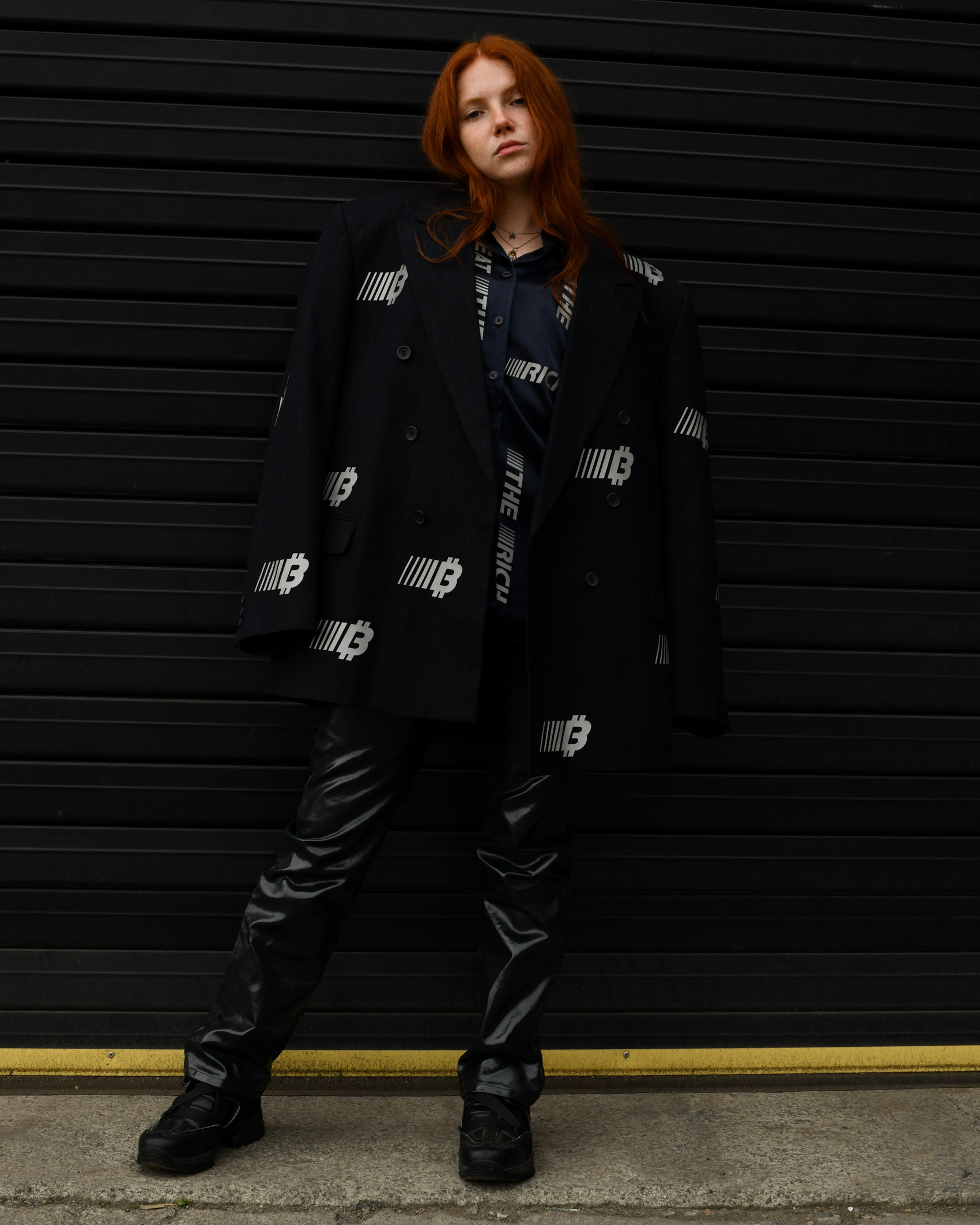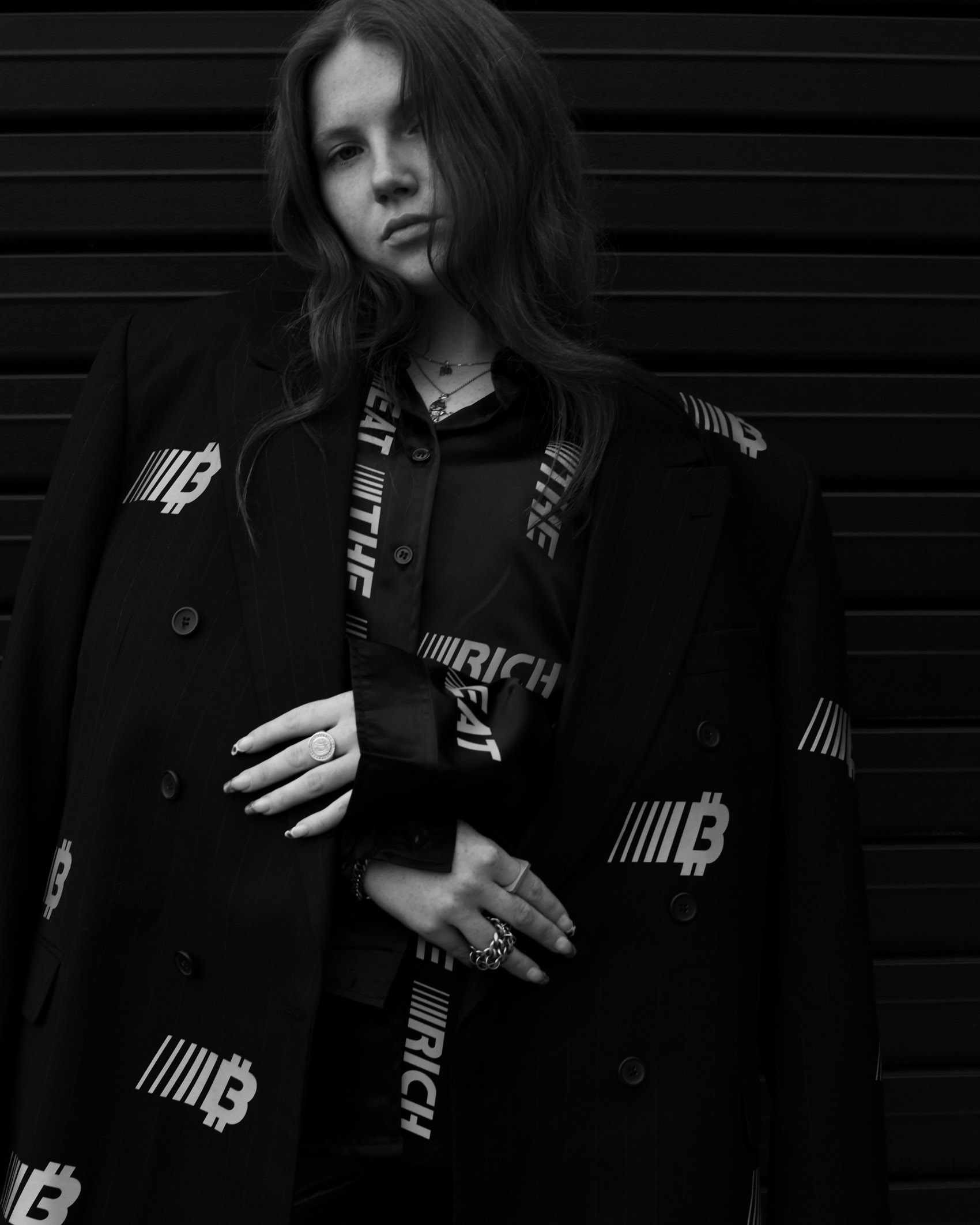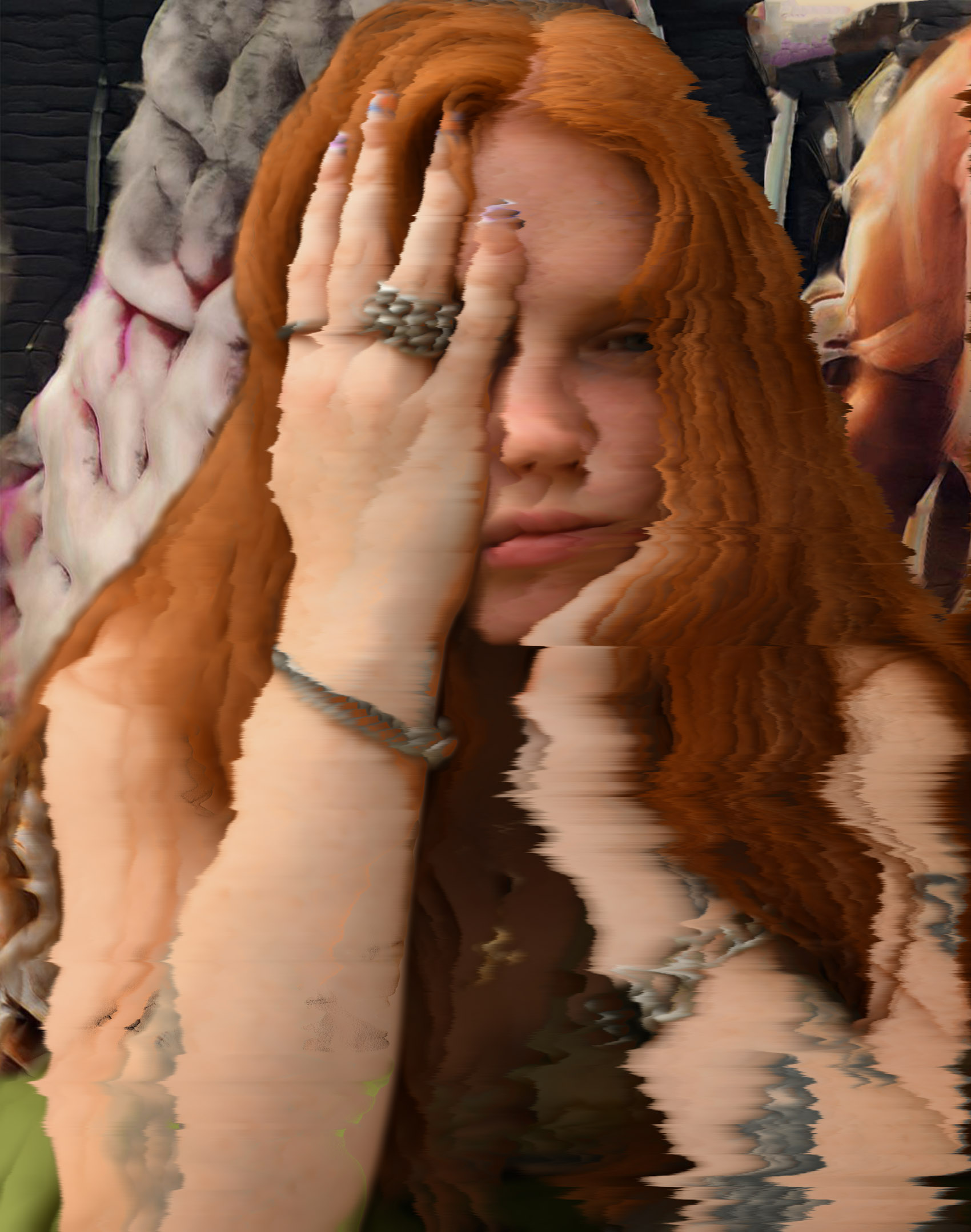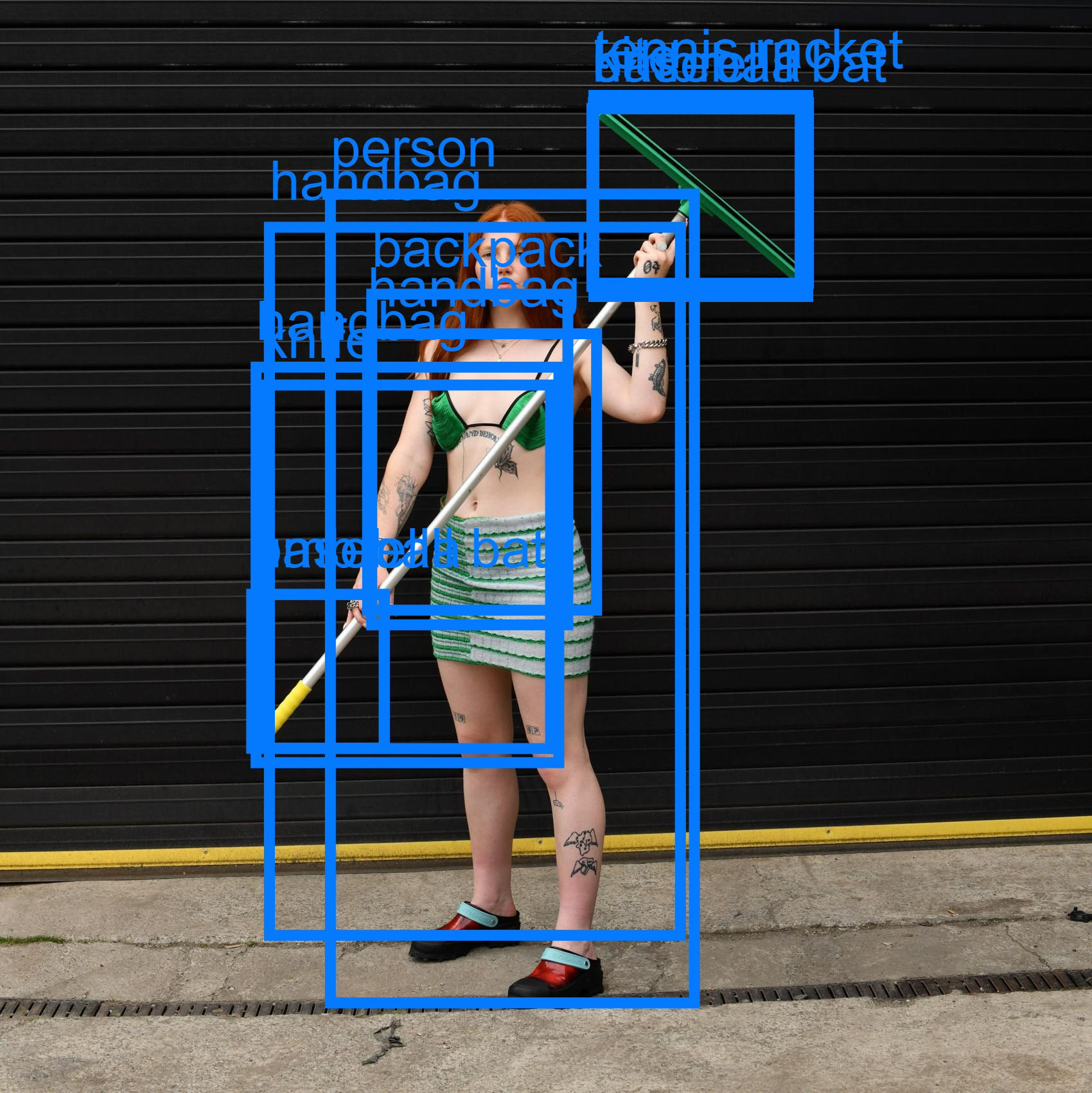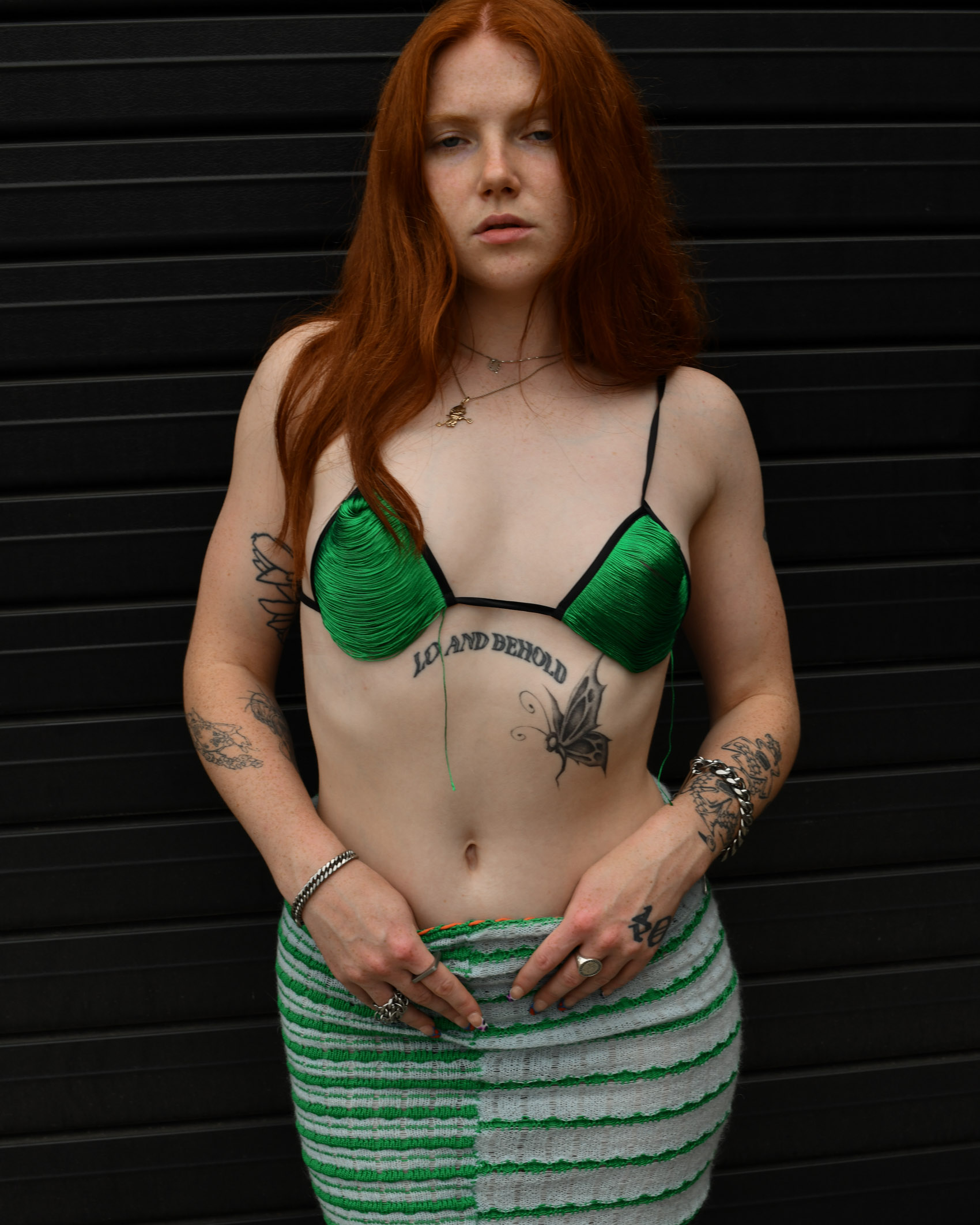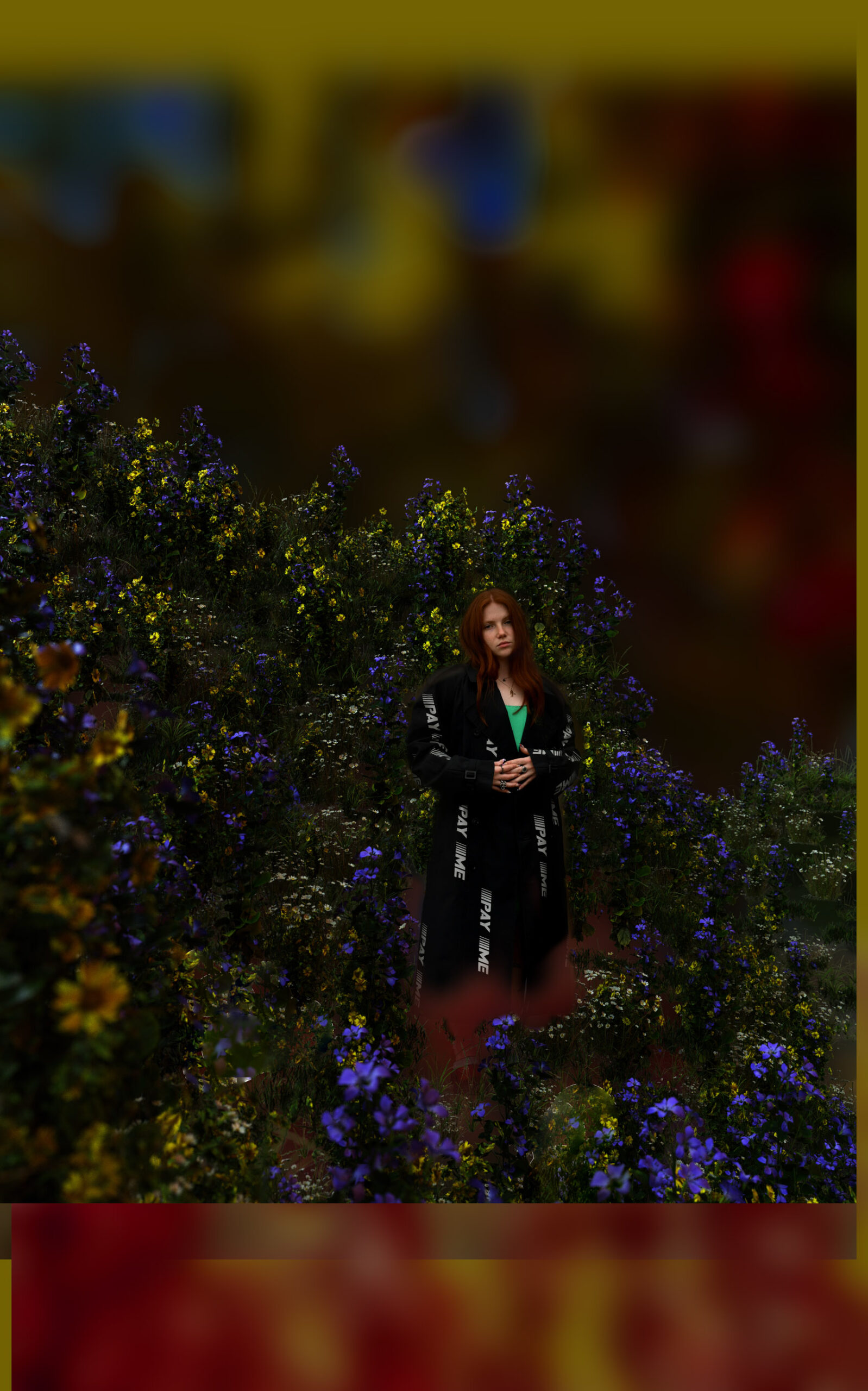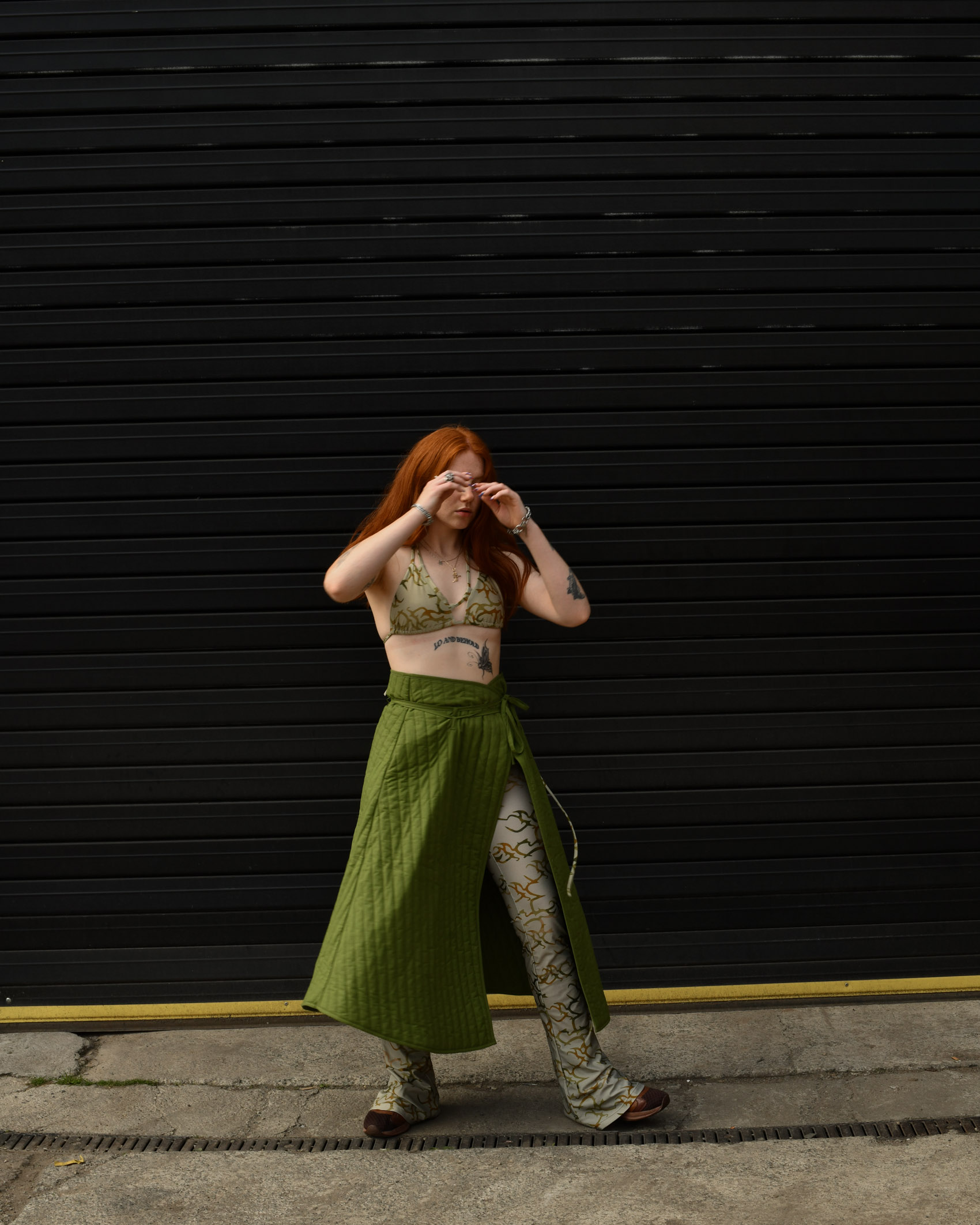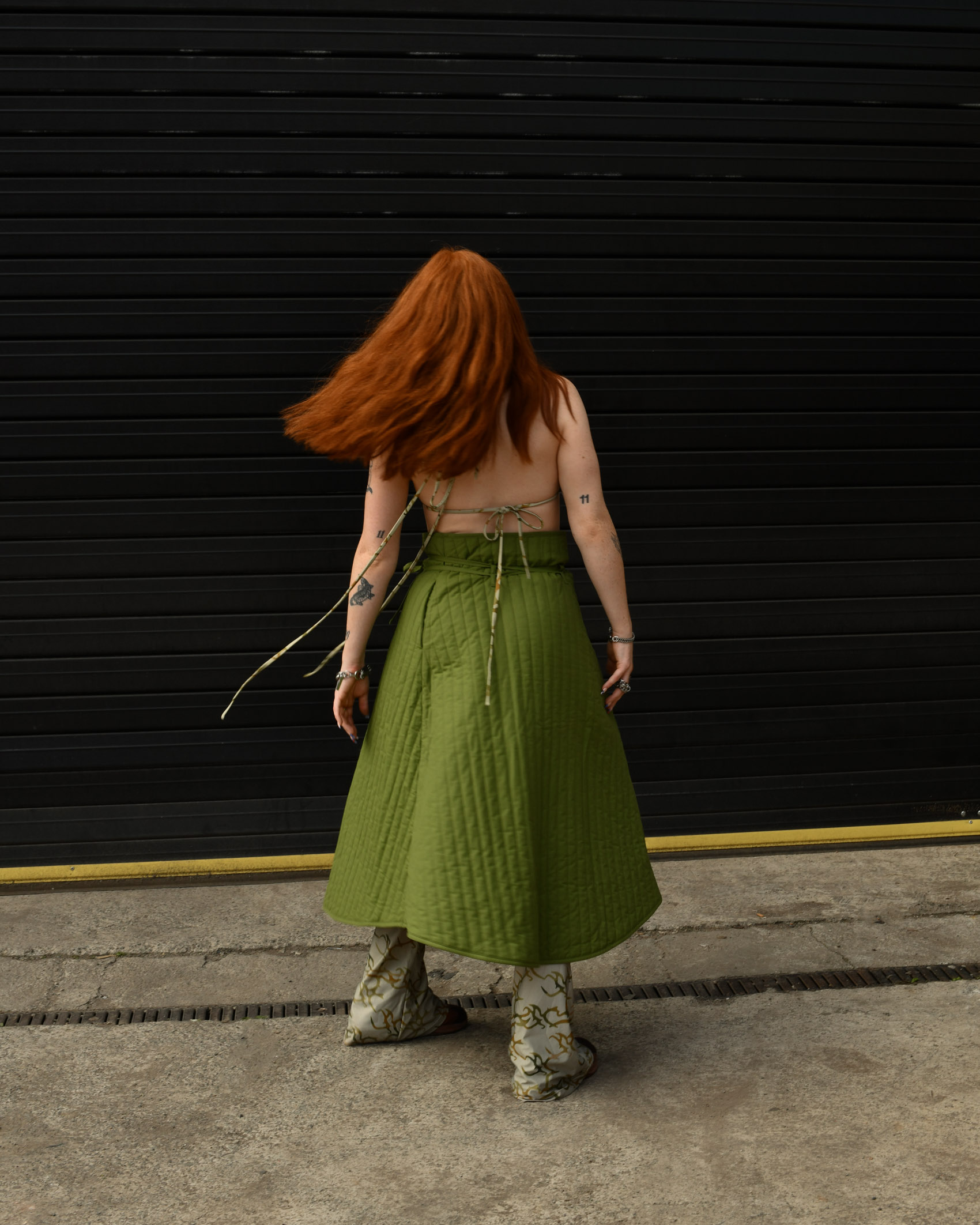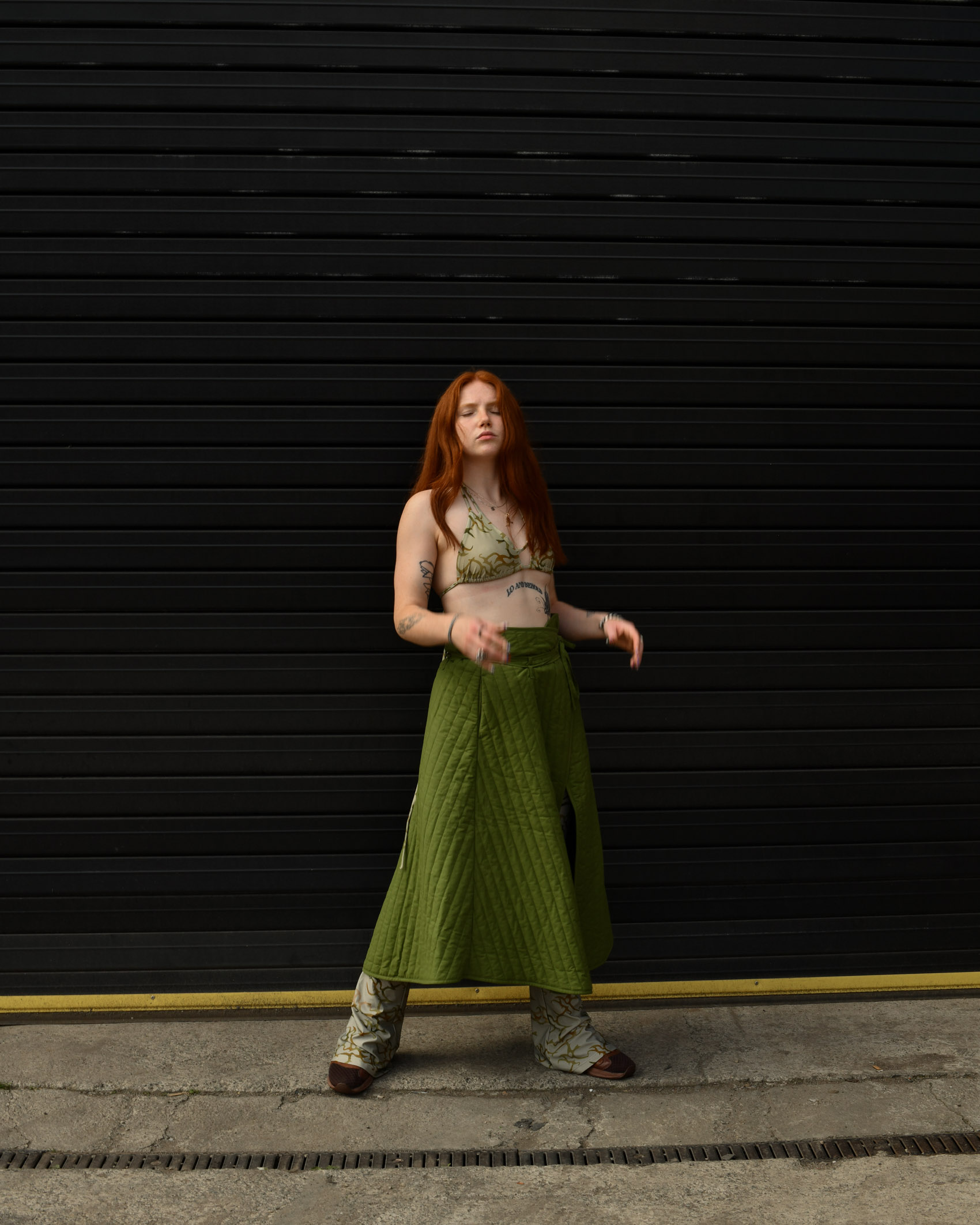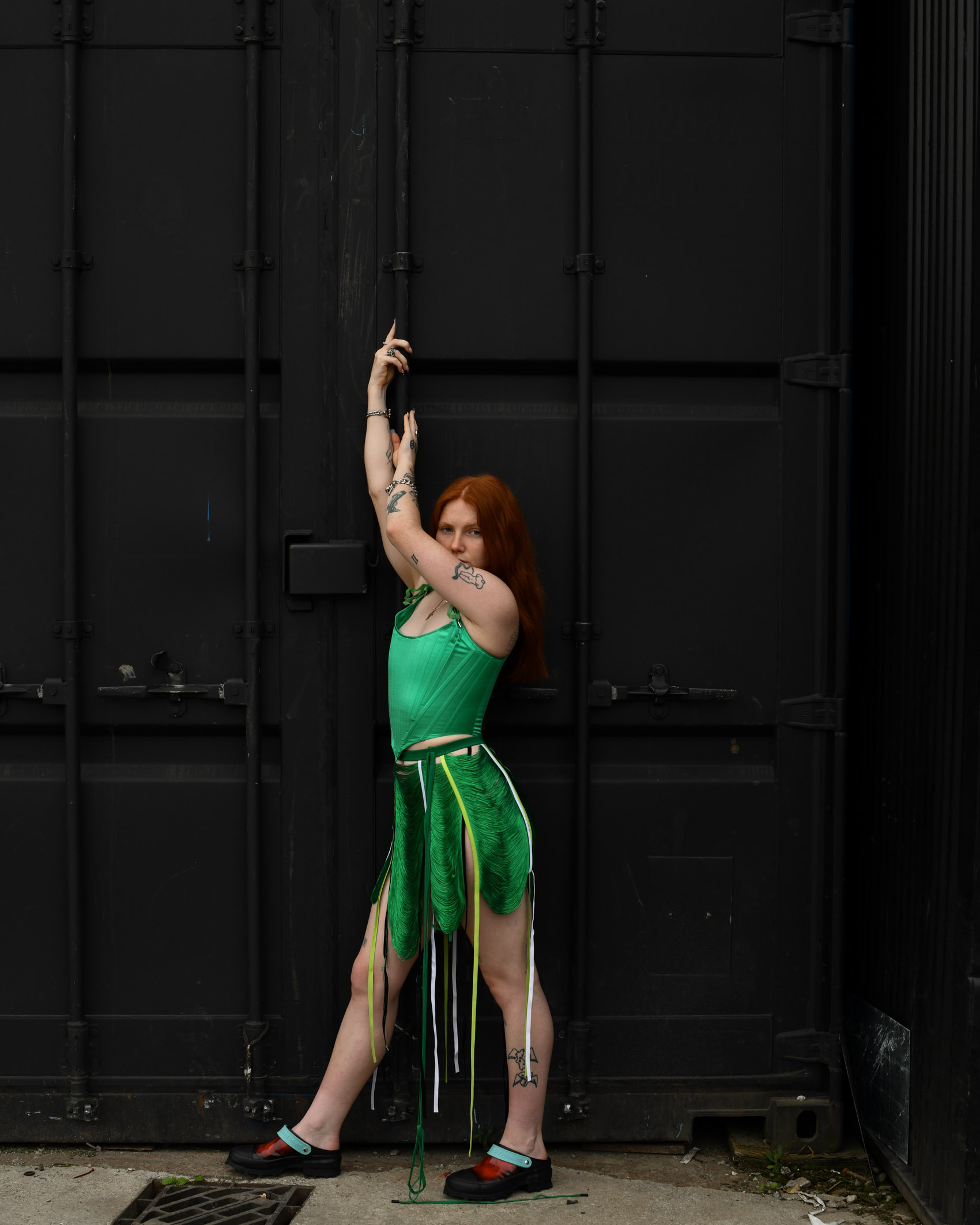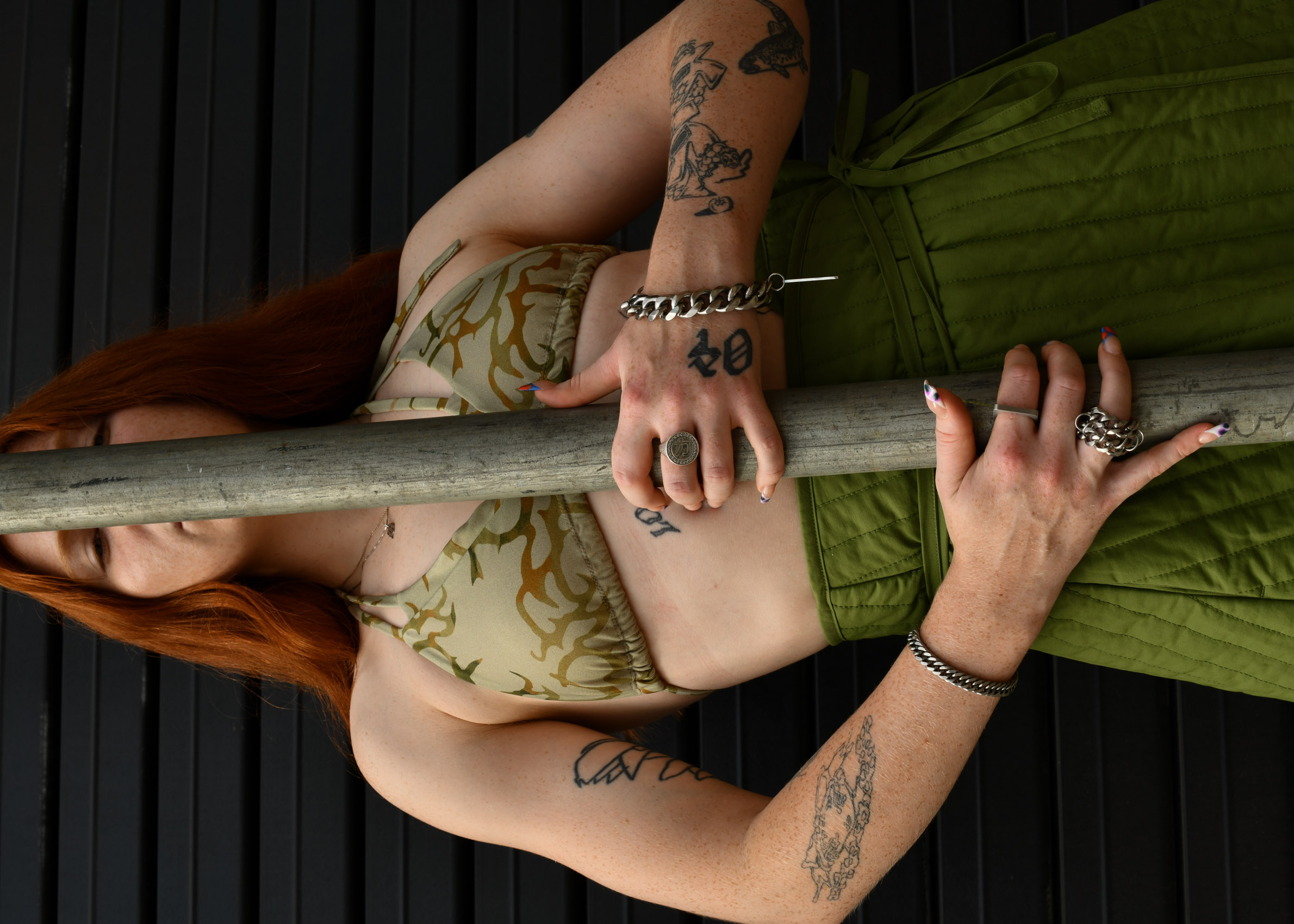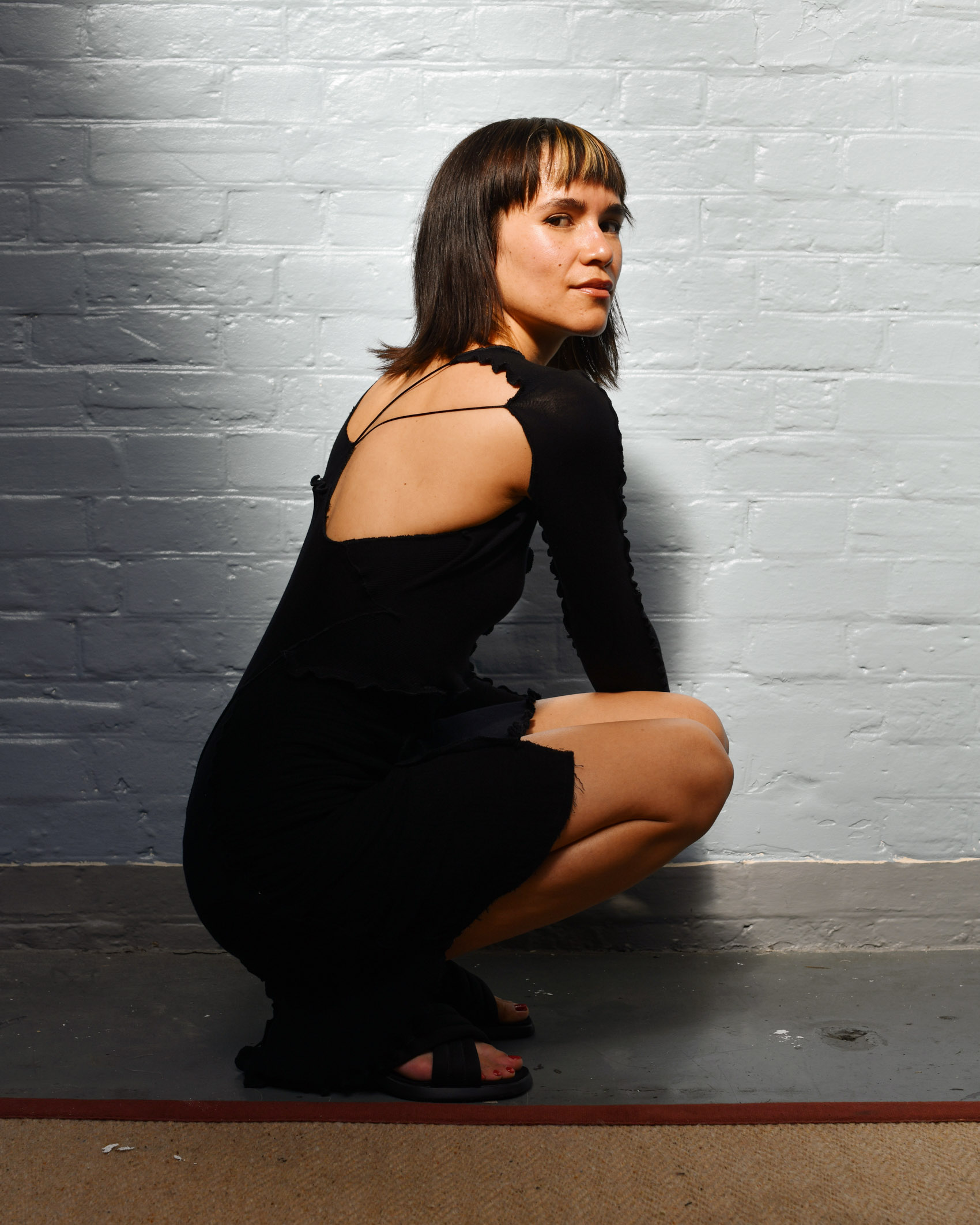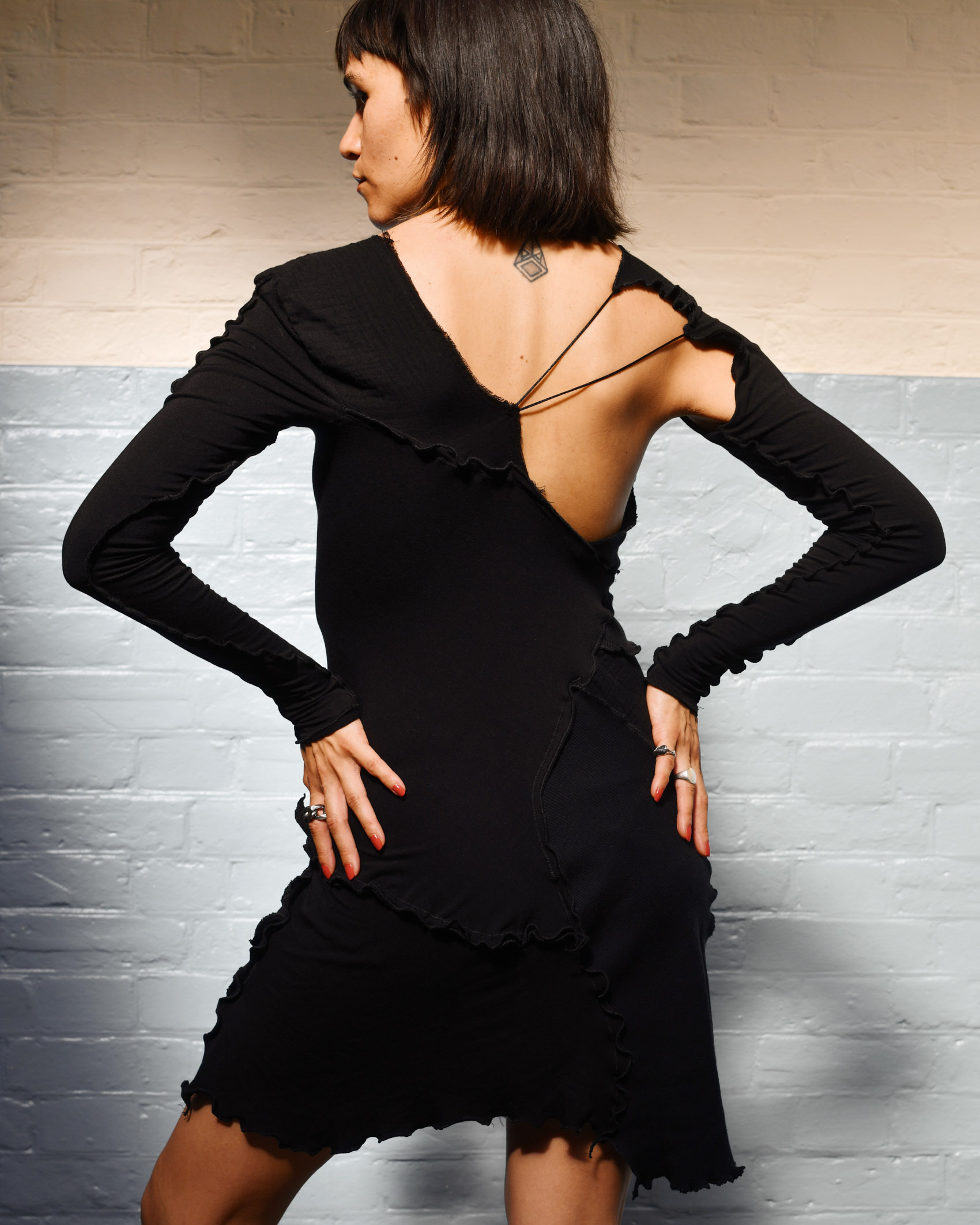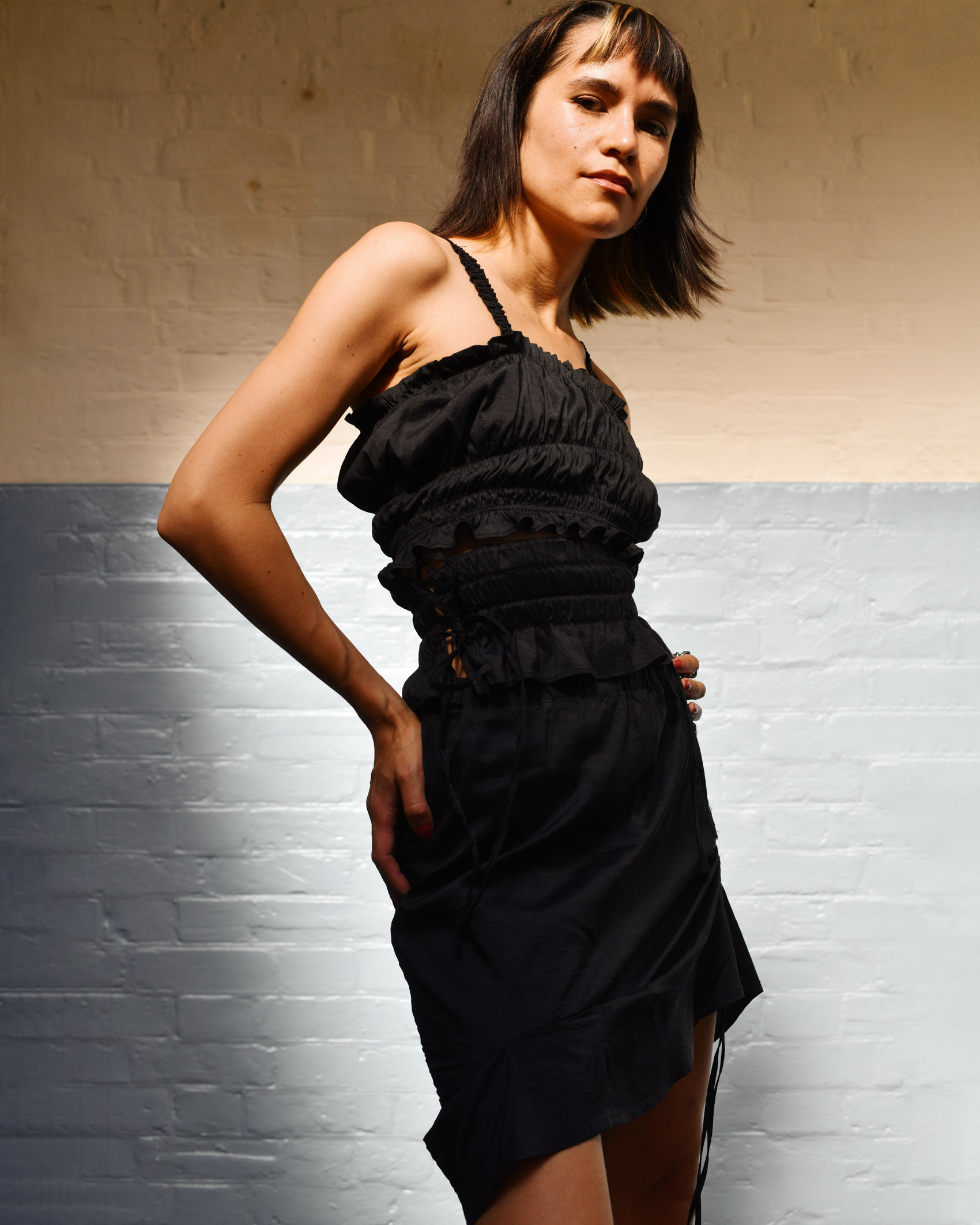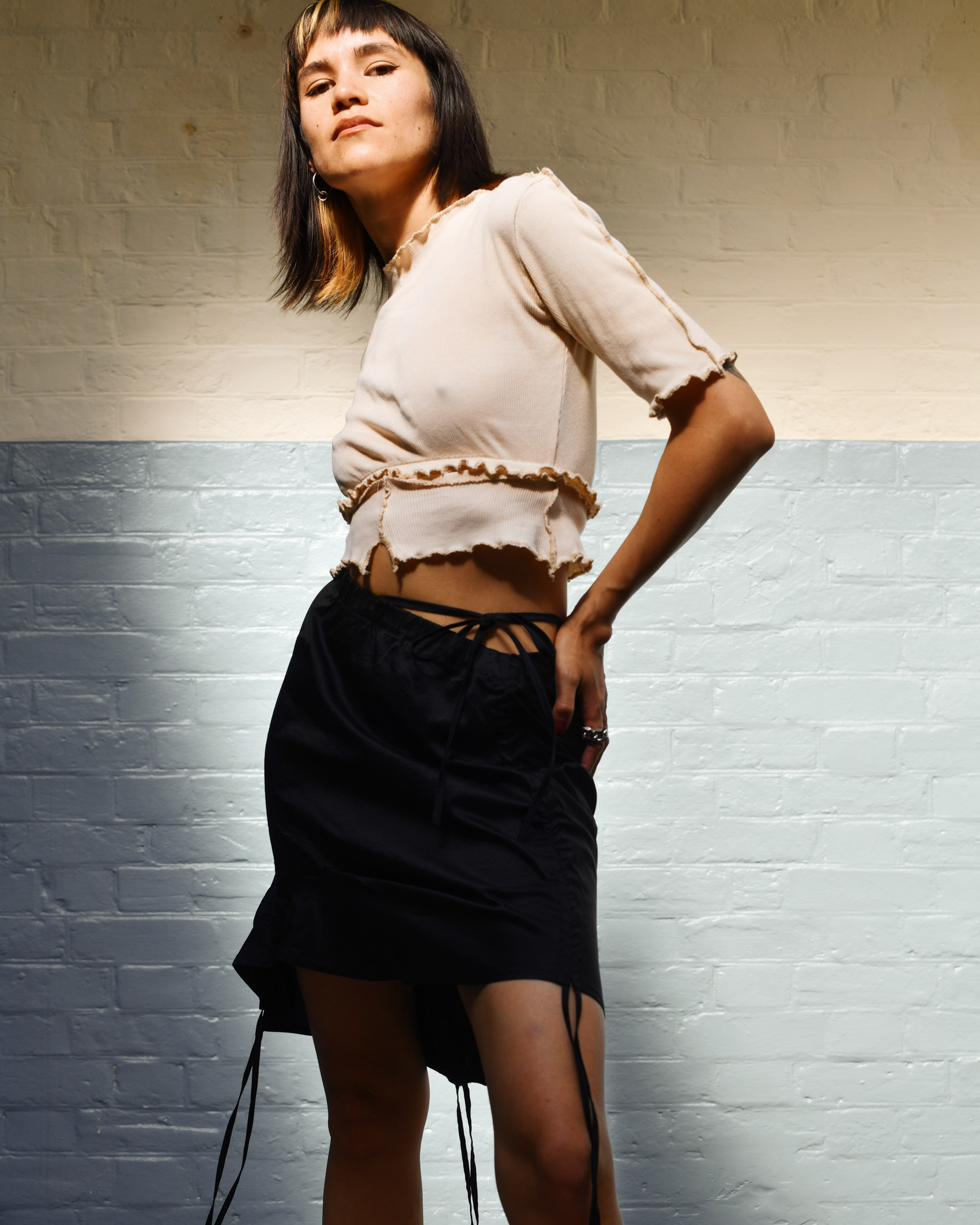IN TALKS with SOLACE
15.09.22
Model/Designer: Flora McGuigan
Photographer: Polly B
Words: Graham Peacock
It’s fitting that our shoot with Flora, designer of Glasgow-based label Solace, takes place in the middle of the woods. With a design style that wears its love for the natural world and the Scottish environment on its sleeve, Solace feels deeply rooted in place.
It’s what makes it so hard to believe that Solace is only in its second year of existence. Already having made a name for herself with two much-loved collections, Flora’s signature ruching, toggles, silver fastenings, and waterproofing have made her designs instantly recognisable – a hard task in a world where originality can feel unattainable. How has she pulled it off? Through 100% authenticity, a genuine love for her craft, and a steadfast ‘release it when it’s ready’ policy.
In this feature, shot by friend and collaborator Polly B, Flora gets lost with us on a journey through the environment that informs her practice, and gets honest about her process. As one of our first collaborators, the catch-up was an absolute dream.
Tell us how Solace started out.
Solace was started last summer, with my first collection being released in June of last year. It was born out of a need to create after quite a long time spent in lockdown.
I had been making and selling work for the year previous under my own name, but it felt like the right time to make the step to become an actual ‘brand’. The lockdown allowed me to slow down and reflect on what I wanted my identity to be.
We’re interested to know how you found studying fashion, how do you find it changed the way you design your collections now?
Honestly I did find it quite challenging. I studied in London which I think definitely comes with its own unique stresses. I can only talk from my own experience, but I do think that to study fashion you are expected to be working literally every hour of the day! University set me up well for the realities of the industry and gave me a really good work ethic.
It totally shaped the way I design and work, as I was taught the importance of designing in a coherent way and ultimately that gave me the confidence to start my own brand.
What we love about Solace is that it has a very unique design. We see one of your pieces and instantly know it’s yours. How did you develop your style, what influences you?
Thank you very much, that is a real compliment! I’ve always been obsessed with making mood boards and truthfully I still spend a lot of my free time going through magazines or researching images online and then curating them together into different folders. Because of this, I think that when I began Solace I already had quite a strong sense of what the ‘image’ would be. I also always design in full looks so I think this allows me to make the collections more coherent.
I’m really inspired by my surroundings and those around me and I think growing up in Glasgow has really informed my design style. Self-reflection and identity are big themes for me too and I definitely use my work to unpack my life experiences.
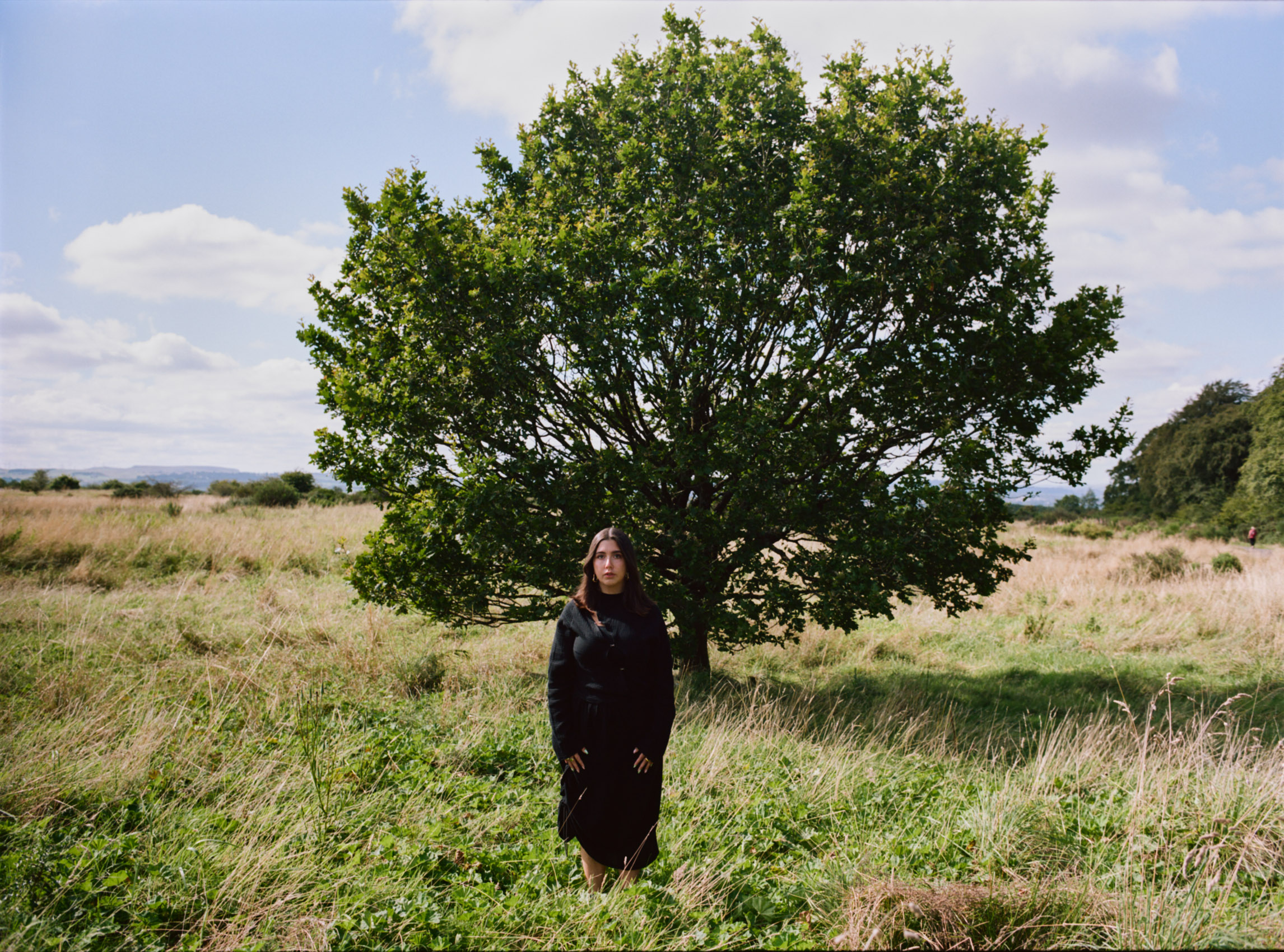
It feels like there’s a big influence from the natural world. A lot of the materials, colours, and designs you use feel really informed by nature. Where does this come from?
I was raised very holistically so perhaps it comes from that, but I’ve always been fascinated by nature and all the things that organically grow around us. I think it also just comes from growing up in Scotland, where we are surrounded by such interesting landscape.
The climate here also really informs my work. When designing I’m always going to put functionality to the forefront as elements such as waterproofing are pretty much imperative all year round!
A lot of your pieces defy gender categorisation as well. Was that intentional?
I wouldn’t say it’s necessarily intentional, I think it just kind of reflects my own personal style. I wear a lot of menswear clothes so I’m always going to be interested in designing to fit that side of my personality. With my menswear pieces, I think that by being a woman designing them there’s going to be a more feminine perspective to the clothing. Overall, I’m really just an advocate for wearing whatever you want!
How do you feel being an independent designer? Is it hard to keep that creative, experimental mindset when your passion also becomes a business.
I absolutely love what I do, but of course like any job it comes with unique challenges. It is an all encompassing job to be self employed in any field, but I’m lucky that I really enjoy being my own boss and I find it easy to motivate myself to work. It can definitely be hard to switch off from it when you aren’t physically clocking out of a workplace. You also can’t help but at times correlate your own self worth to how well your business is performing but I am slowly learning to separate the two!
When you monetise your passion you definitely find less time to create simply for enjoyment. I think that there is this pressure on fashion designers to constantly be bringing out new styles or creating content but I’ve learnt that the most important thing is to slow down and only release things you are 100% happy with.
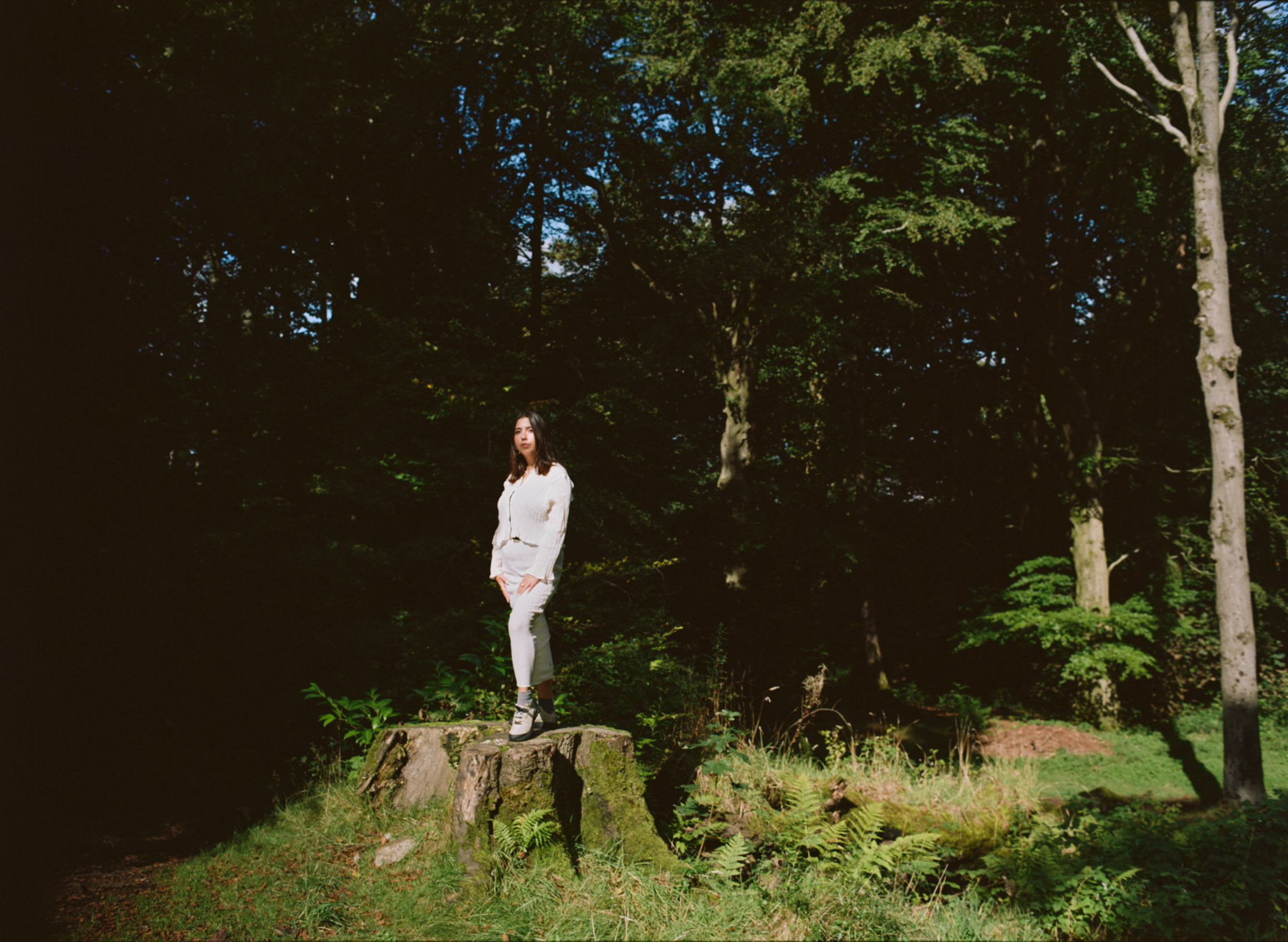
What would your advice be to someone who wanted to get into fashion design?
Find out what your narrative is and what you stand for. I think that when you have a backstory to your clothes or an ethos of sorts it makes the design process so much easier and also makes your brand more relatable. The world is saturated with clothes so find an angle that’s going to set your pieces apart from others!
If you want to start your own brand try to get an internship in a small company where you have a lot of responsibility and are exposed to every aspect of starting a business. I think you need to be prepared for how much work it takes and be willing to put all your energy into making it happen.
Also just try not to worry too much about what people think. I’m such a shy person but I almost use Solace as a kind of alter ego where I feel really able to be expressive and confident. Finally, people are a lot more supportive than you think, so try to share your work as much as possible and you’ll probably be surprised by how much it can resonate with others.
You recently released your second collection, which we’re sure was really exciting. What was the process like designing this collection compared to previous work?
The process was in equal parts easier and harder than before! I found it easier to design as I felt I had already kind of established my style and what I stood for as a designer. However, it’s always really scary to release anything and I was more worried this time about how the collection would perform as it had become my full time job so there was more riding on it being successful.
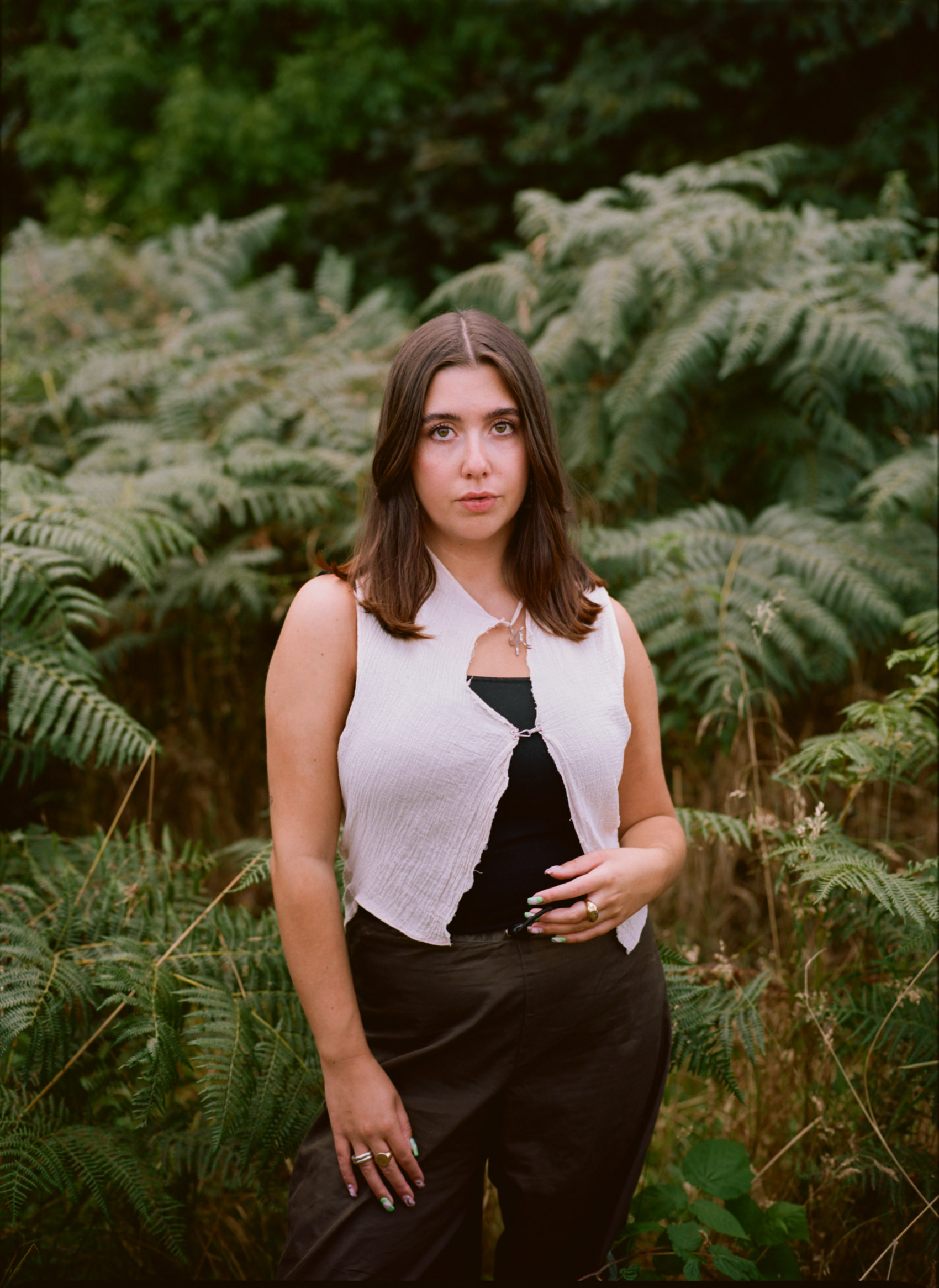
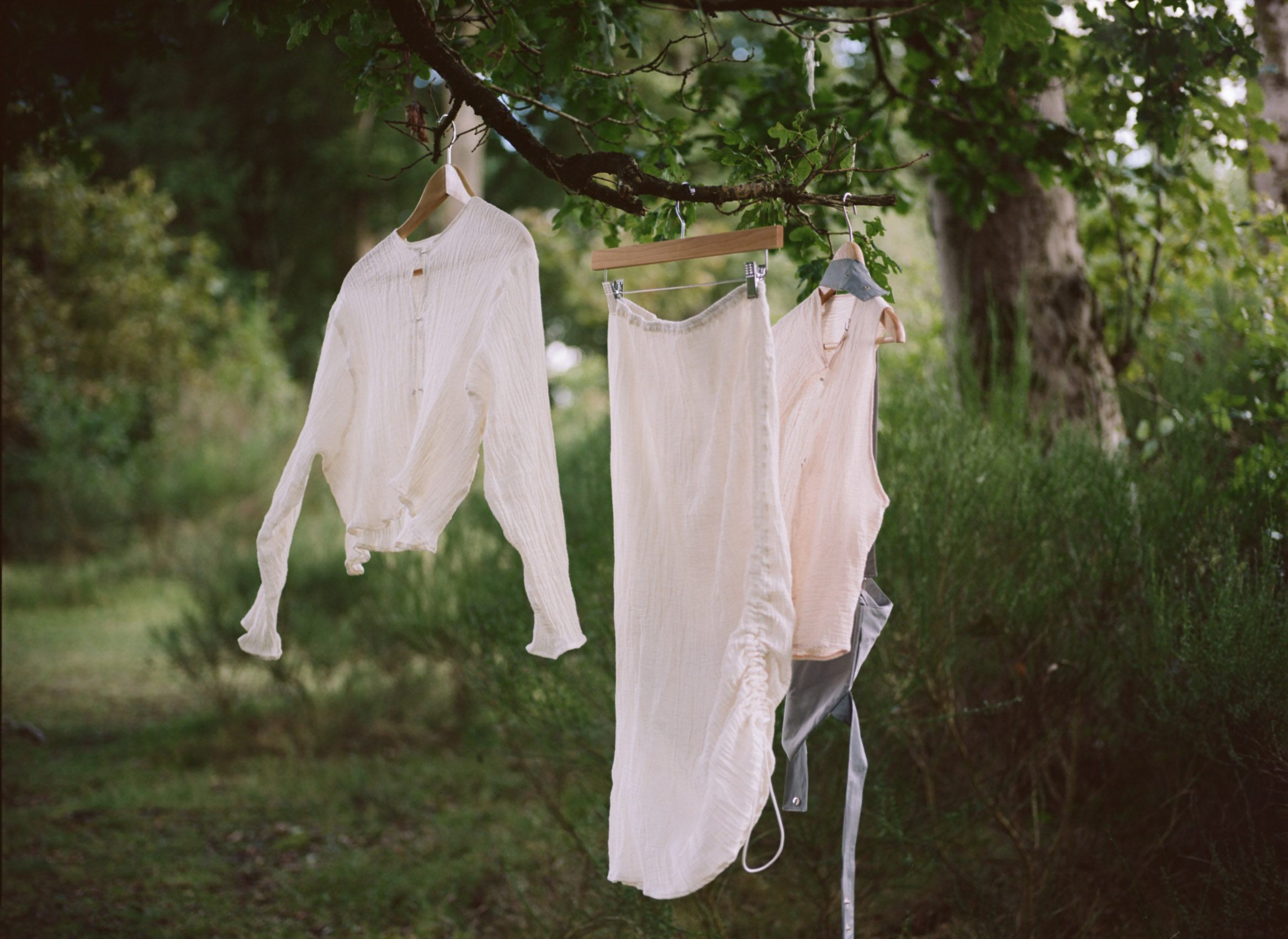
Do you have a favourite Solace piece?
I wouldn’t say that I have a favourite piece but so far I think that I’m most proud of the ‘Carla Set’. It’s definitely my most popular piece and it means a lot to me personally.
Where does the name come from?
Solace means ‘comfort in sorrow’. I started my brand during a really bad period in my life, and I use my creative practice to mentally work through a lot of those situations.
I like to keep the catalyst for my work and the meaning behind my designs quite private to me, but I want Solace to be a reminder that, when you are ready, you can make beautiful things out of the darkest moments.
IN TALKS with NILÜFER YANYA
02.09.22
Featuring Nilüfer Yanya
Photography: Bethany Grace
Styling: Tamara Turnbull
Makeup & hair: Margherita Lascala
Words: Graham Peacock
With thanks to Limitée PR
There’s something refreshing about Nilüfer Yanya. With a voice that moves cooly over dreamy electric guitars and sombre piano chords, her lyrics read like cryptic diary entries. On her latest release, PAINLESS, Yanya moves into a sound that feels more cynical, more honest, and more introspective.
Somehow, Nilufer manages to bear her soul and keep her cool as she processes loss in its many forms, and spending the day with her gave us an insight into how she pulls it off. That raw honesty Nilufer’s fans have come to love in her music seeps into how she talks about the process of creating an album. Following up 2019’s Miss Universe was never going to be easy, but on PAINLESS, Nilufer turns her back on expectations, pigeon-holing, and the high stakes she created for herself – and she’s had a busy summer reaping the rewards. With LUNCH, Nilufer takes a break from touring to get candid about the story behind the music.
Talk to us about the background behind PAINLESS. There’s a sense of mourning in a lot of these songs. What kind of loss are you exploring?
It’s interesting – I think I was talking about a relationship a lot of the time, but the real relationship I was mourning was the one with myself. It was like, going through the relationship as a way to get to the relationship with myself. A lot of my songs turn out to predict what’s gonna happen in my life.
So have you lived through the songs you’ve written on this album after releasing them?
Yeah, that’s exactly what happens. It’s really strange. Maybe part of my subconscious is preempting what could happen. Not for every song, but definitely for some of them I’m like, ‘Wow, that’s kind of eerie how that panned out exactly like that song,’ or ‘That song makes a lot of sense now’ – it’s like I was writing for a future version of myself. Like Chase Me, I really liked the song, but I didn’t necessarily know exactly what I was writing about, and then I walked into a situation where I was like ‘Oh, this is exactly what that song was about’.
Who did you make PAINLESS for?
I guess I always write for myself, but once you know people are gonna listen to it, it does change things a bit. It lets me be more vague sometimes, because I don’t need to necessarily know what [every] line means to me, but it could mean something to somebody else, or I can just appreciate it because I like it and I don’t have to think about if it’s genuine or authentic. I find it interesting to step into other people’s shoes, and write from their perspective. I mean it is still authentic, but it’s your take on what someone else might be thinking.
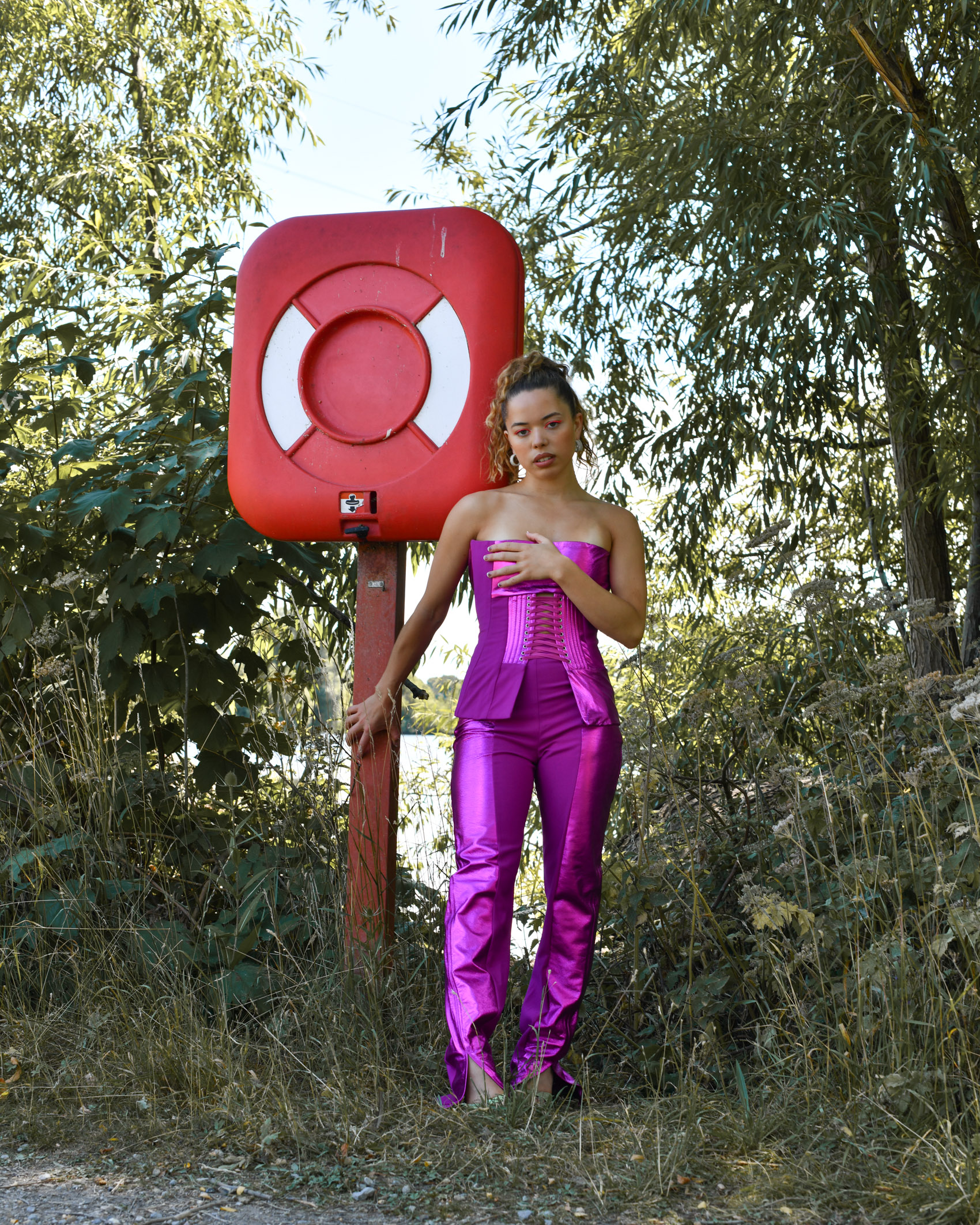
Sonically, you can feel the shift between this album and Miss Universe. Was that a conscious desire to explore a slightly different sound, or was that shift more spontaneous, and informed by you changing yourself?
A bit of both. On Miss Universe I was worried about making something too much of one sound. People would be like ‘Oh, you’re indie’, or ‘Oh, you’re this’, and those tags were so annoying. I don’t really want to fit into one box, so I played around with different styles. Looking back on Miss Universe, I found it a shame because it doesn’t always sit together the way I imagined it. So I was like, with PAINLESS, let me not be afraid. If I want to do this guitar, grungy-rock thing, let me just do it and not worry about whether it’s gonna put me into one group or genre. I just went for it.
Speaking of your debut, it was so well received, which I’m sure must’ve felt great. But how does it feel having to leave each project behind to start a new album? Is it intimidating or freeing?
I was so glad to be free of it. Even before it’s released you’re sitting with it for like three to six months. In a way, once I’d done it I was already over it. But then you’re touring it, playing it, talking about it, and then you’re so done with the record [laughs].
It was weird because I felt like there wasn’t anything left in my reserve. I did an EP, then the pandemic started and I was writing, but wasn’t very creative for a year. So it was hard to get back into the place where I was before Miss Universe came out, and not think about people listening. It infects you, in a way. People call it a difficult second album for a reason, it’s easier when no one’s listening and no one’s watching.
How far ahead do you plan your music? When you were working on PAINLESS, did you already have an idea of how the next project would sound?
In general, when I’m writing I’ve learned to just write instead of writing for something. That way even if something doesn’t fit you don’t have to throw it away, you can keep it. It’s just useful to keep writing and pick what you want for that project. Then there’s always something to go back to. But when I started writing PAINLESS I felt like I’d used it all up.
Which is quite freeing right? Just having a fresh start.
It was! I was working with Will Archer, the main producer on PAINLESS, and we wrote a lot together. Which is something I’m wary of, but we get on so well and it just made sense.
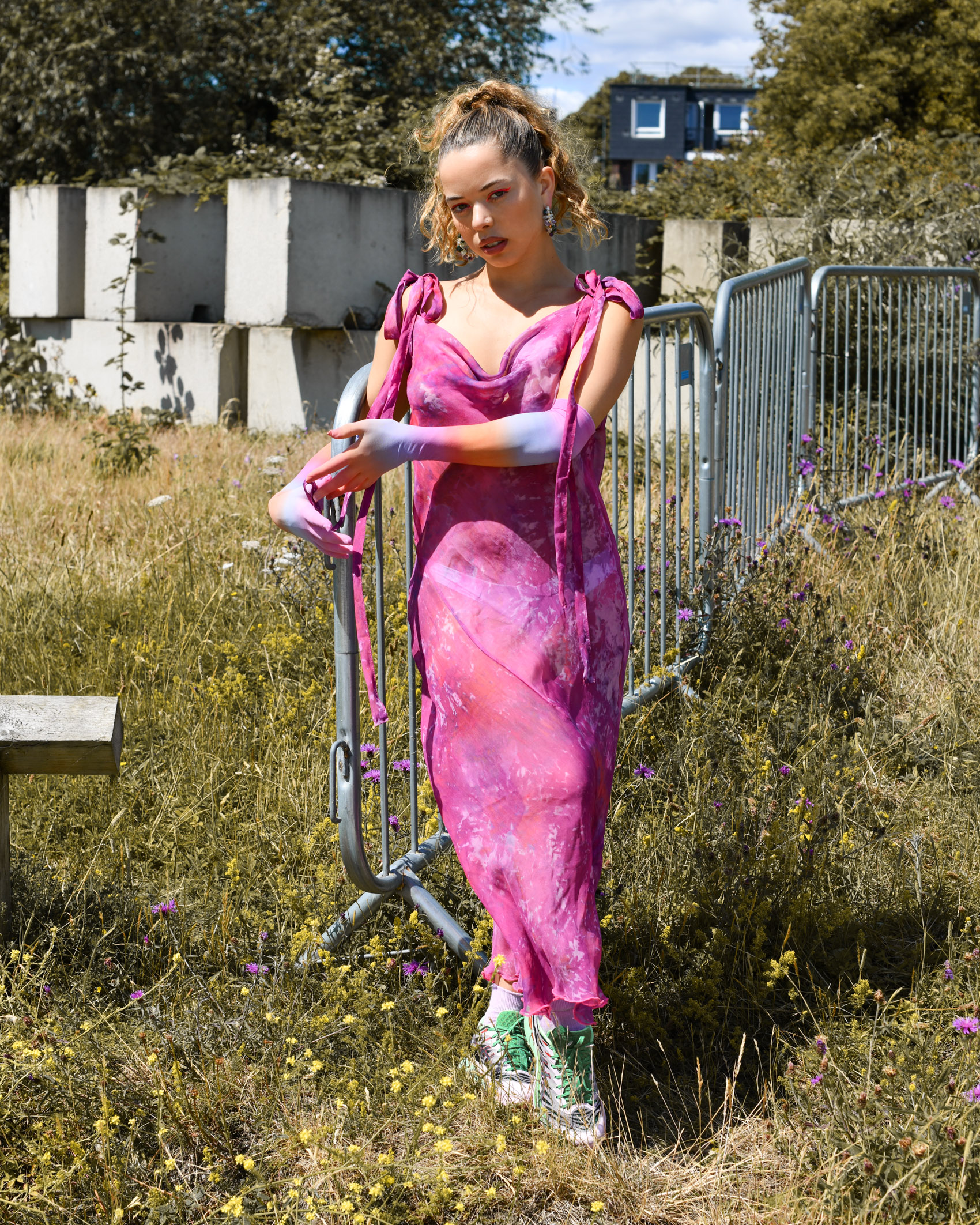
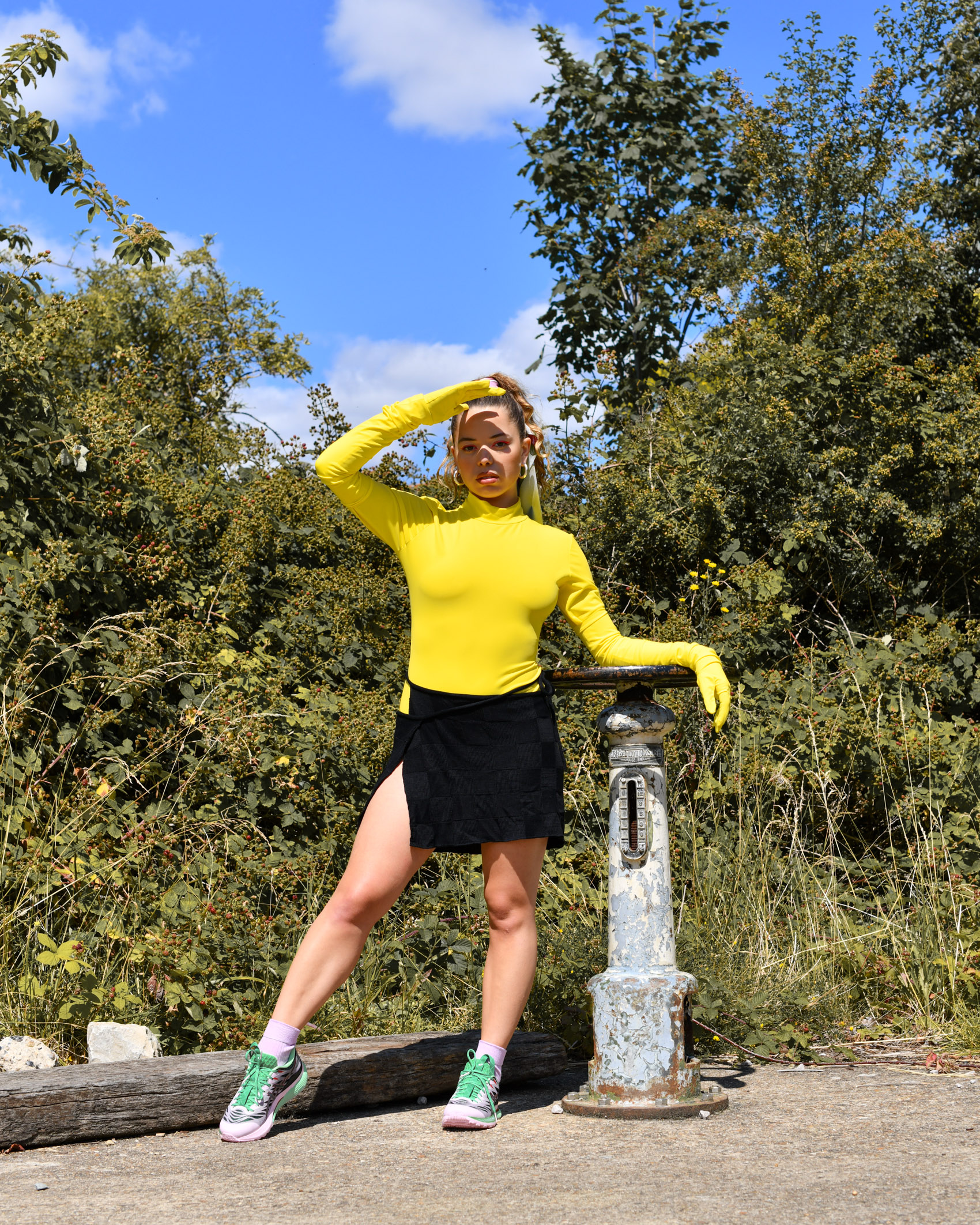
Albums aside, how’s summer been? Between festivals and touring, it looks like you’ve been everywhere.
It’s been great. We’ve been touring since March, and this is one of the rare weekends off in the summer. March to June was just tours. We did six weeks in America which was insane. I’m actually quite…not done with it – but it’s the middle of the year and I haven’t really been around, I’ve just been running around like a crazy person. So I’m definitely feeling it. But when I think about all those experiences it’s been such an amazing thing to get to do.
I’m presuming this is the first time you’ve played a lot of these songs live. Has your relationship with the music changed since playing in front of these huge crowds?
Some crowds surprise you, some songs just go off better in certain crowds or countries. You always think you have it down, what song people like, what people find boring, what’s more upbeat, but you get it wrong. It’s been interesting – sometimes you have really weird experiences on stage. A lot of the Mediterranean festivals put you on at midnight and everyones wasted and it’s like, ‘why are people listening to this type of music now, should they be dancing?’ [laughs]. Every time you play a song is a different experience, but sometimes you zone out. It can be challenging to always stay present.
What do you hope the rest of this year has in store for you?
I’m preparing stripped back versions of some songs on the record. We’re gonna be filming that in September. I’ve got a festival in LA, and some more European touring in October and November. I’ve started writing in the past few days, I’m hoping to make some demos just by myself. I’m thinking about maybe moving somewhere for the next year, for like six months, and just focus on writing. I’m finding it quite hard in London. I’m trying to find a studio space but everythings so expensive, and so I’m like, what if I just moved somewhere not in a city so I can just live and work and really focus. I think it’s gonna echo what I learned in the writing process of PAINLESS, but be a bit closer to some of the songs on Miss Universe.
IN THE STUDIO with PEACH
17.08.22
Photography: Andrea Brodie
Words: Graham Peacock
Featuring: Kacie & Irene of Peach
Day parties, club nights, radio shows, festival sets – Peach are doing a lot right now, but that doesn’t mean they’re in any rush.
A DJ collective founded and fronted by Kacie with her girlfriend Rachel, Peach have made a name for themselves with their collaborative-focus, all femme parties, and experimental sets.
As club line-ups fill with an ever-growing list of residents, Peach don’t make a move unless it feels right. Each performance feels authentic, carefully considered. Building a loyal community isn’t easy, and Peach have put the work in to make their name synonymous with quality.
Chatting to Kacie and Irene, it’s clear the work they do is about more than just themselves, or the future of Peach. It’s about changing the framework of DJ culture in general, making it a more accessible, more expansive, more inclusive environment than it’s been in the past. They know it’s a work in progress, but as Peach’s name continues to grow and the guest lists get longer, we might not be too far away.
Hey Kacie and Irene, where are we right now?
Kacie: We are in 644 Studios, which is a music recording studio and creative hub that myself and Lude have been creating since early 2020.
Irene: By far the most impeccable and clean studio I have ever been in.
How do you describe Peach?
The genres you would hear at Peach are Hiphop, Rap, Trap, RnB, Drill, Dancehall, etcetera etcetera. We would describe it as an events platform that taps into live events, radio, day parties, festivals, merch and recently all femme parties.It’s a family that comes together for the love of music. The energy and vibe it creates is unmatched.
What drew you towards producing and DJing?
Kacie: I’ve just always had a love for music. From a young age. I would say I really found my love when I started going to live shows with my mum when I was young. She took me to a Pink concert and that’s when I realised that women could play the drums and so many other things than just being a ‘popstar’. From then I was obsessed. I started drum lessons in school and started to tap into production and basic music theory. I would sit for hours listening to loads of different radio stations around the world, just hearing all the different sounds and genres.
As I got older it was a natural progression to DJing and producing. I had always messed around. My parents bought me my first set of turntables when I was 12 for Christmas. I really put myself out there as a ‘DJ’ in 2011, then eventually worked up the courage to start dropping some of my productions. It makes me cringe hearing back earlier stuff.
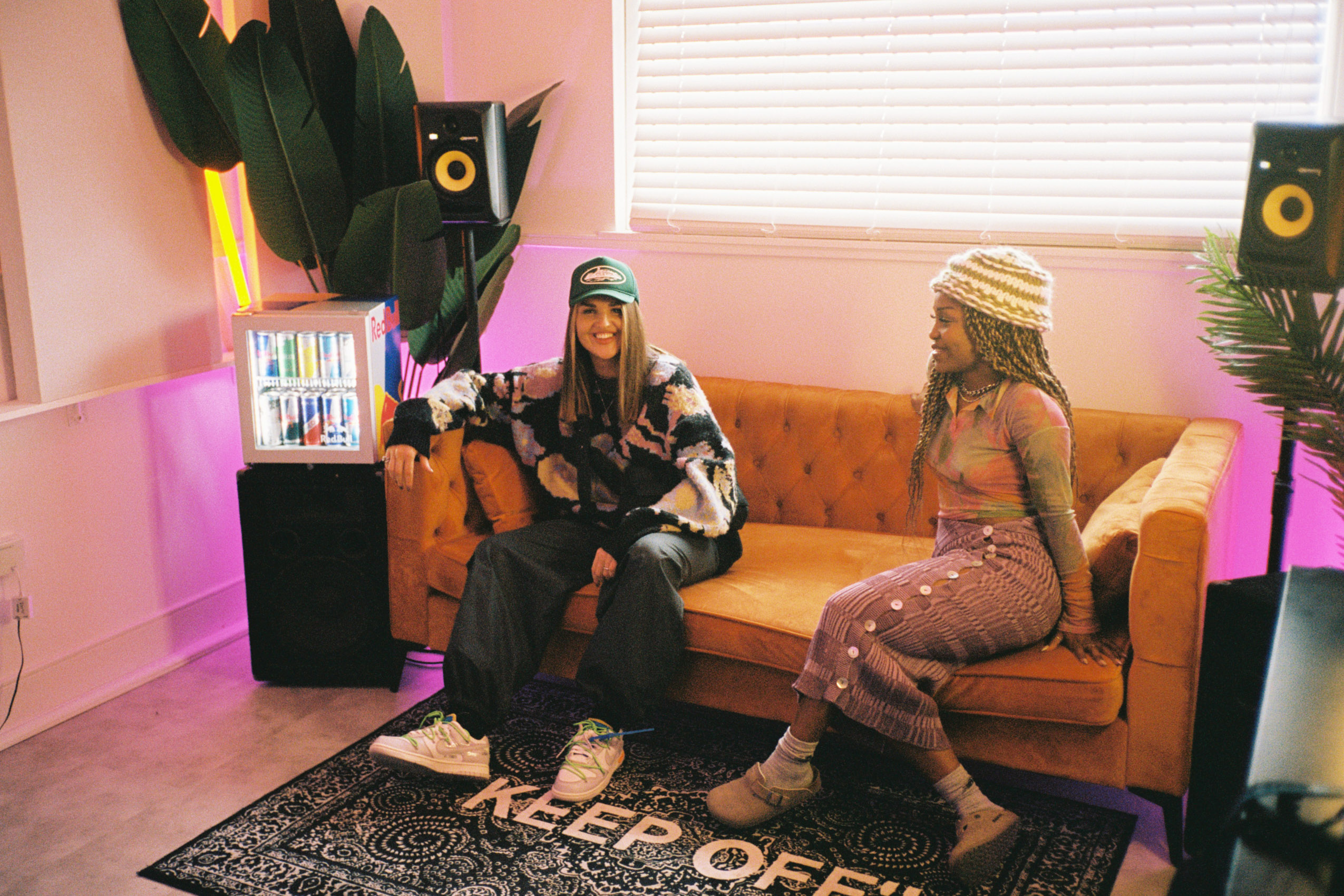
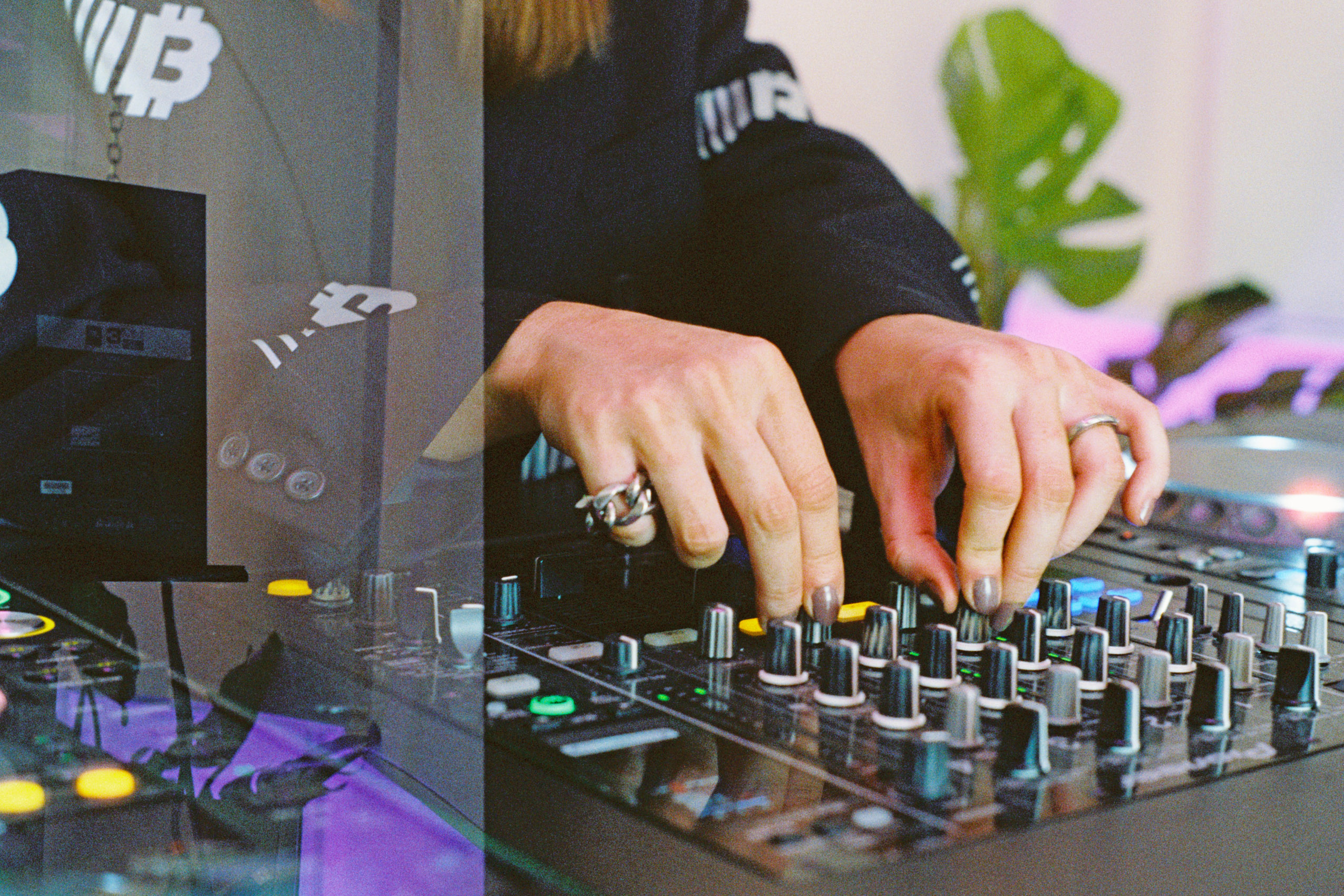
How did you guys get together?
Kacie: It’s authentic: nothing is forced, genuine connections. It was just me and my girlfriend Rachel that started it off. That’s where the name comes from – Rachel’s nickname growing up was Peach because she always scored good goals in football. We felt Peach covers everything woman, even those little tomboys scoring goals.
We wanted to expand it out more and with Rachel being busy with work and other commitments it made sense to make a bigger team. Peach was gathering enough interest and hype that it made sense to start expanding. And we are all friends, we knew Irene, we built a natural connection.
Peach has taken years of time and effort so we wanted to make sure that whoever was coming into Peach knew exactly what we did, shared the same values and goals, and Irene has been since day one. She knows what Peach stands for and she knows us – something that is important to us is to make sure it’s woman-led.
Irene: I don’t shut up about Peach, whether that’s at work or with friends. It was an honour to be asked to come on board on something that I feel is so vital for the scene in Scotland. It really is one of a kind and so well executed and I’m excited for what’s to come.
What kind of space are you hoping to create when you host an event?
A good energy. For everyone to feel comfortable. A space where everyone is welcome. We try to make it feel as welcoming as possible. We talk to a lot of people on Instagram and we try to make it feel personal.
We try to make it as diverse as possible – it is extremely LGBTQ+ friendly, there are no limits at Peach, we welcome EVERYONE.
We are girls girls girls – anyone femme identify. Since day one it’s been created for women and we make it clear it’s women at the front – women have priority in the line-up and crowd. We love our Peach boys of course and they have always respected our values.
We actually created an all femme party called BBO and had our first night late last year which went down great. Everyone could let loose and the messages and feedback we received as a result of the event shows us this is something that is wanted in Glasgow. We can’t wait to see BBO grow!
Where are you guys pulling your influences from? When you go about making a new set, what does that process look like?
Kacie: It’s a broad range – Soulection; what’s going on in America; what parties are going on in Paris; what’s popping in Berlin, Amsterdam, Lisbon, and of course London. Nine out of ten times when we book DJs or artists we have already made a connection with them. Whether it be through me doing shows in London or going to parties, we do make friendships and relationships from it all. Which again I think makes it feel more like a family and welcoming vibe.
We take a lot of time and effort to listen to loads of new people and their sets. Even if it means taking a trip to attend an event to see how the DJ creates a vibe with the crowd, we will! It’s all about making connections.
Peach is always trying to bring new music to the events – it’s important we represent that. Even in my own sets I always try to introduce new music. I feel like it creates memories for people, they remember where they heard it first, they remember how it felt, and I also love to see how a crowd reacts.
What’s your dream event: who’s there, who else is playing, where is it?
Oh wow, where do we start! What’s the dream budget? Haha. Progress to a bigger audience: bigger names, more artists, more collabs, more music, more events, more everything. Same with BBO – bigger audience and all the top women on the line up. Wow, imagine…
But overall a Scenic backdrop in Scotland: suns out, good drinks, good food, amazing line up. People like Joe Kay, Shaybo, Skii Fall, Drake, Pusha T, Knucks, M Huncho, Ms Banks, Bia, RhiRhi – the list goes on. We have so many ideas with a few things in planning. We are keeping them under wraps. We don’t want to give anything away, hehehehe.
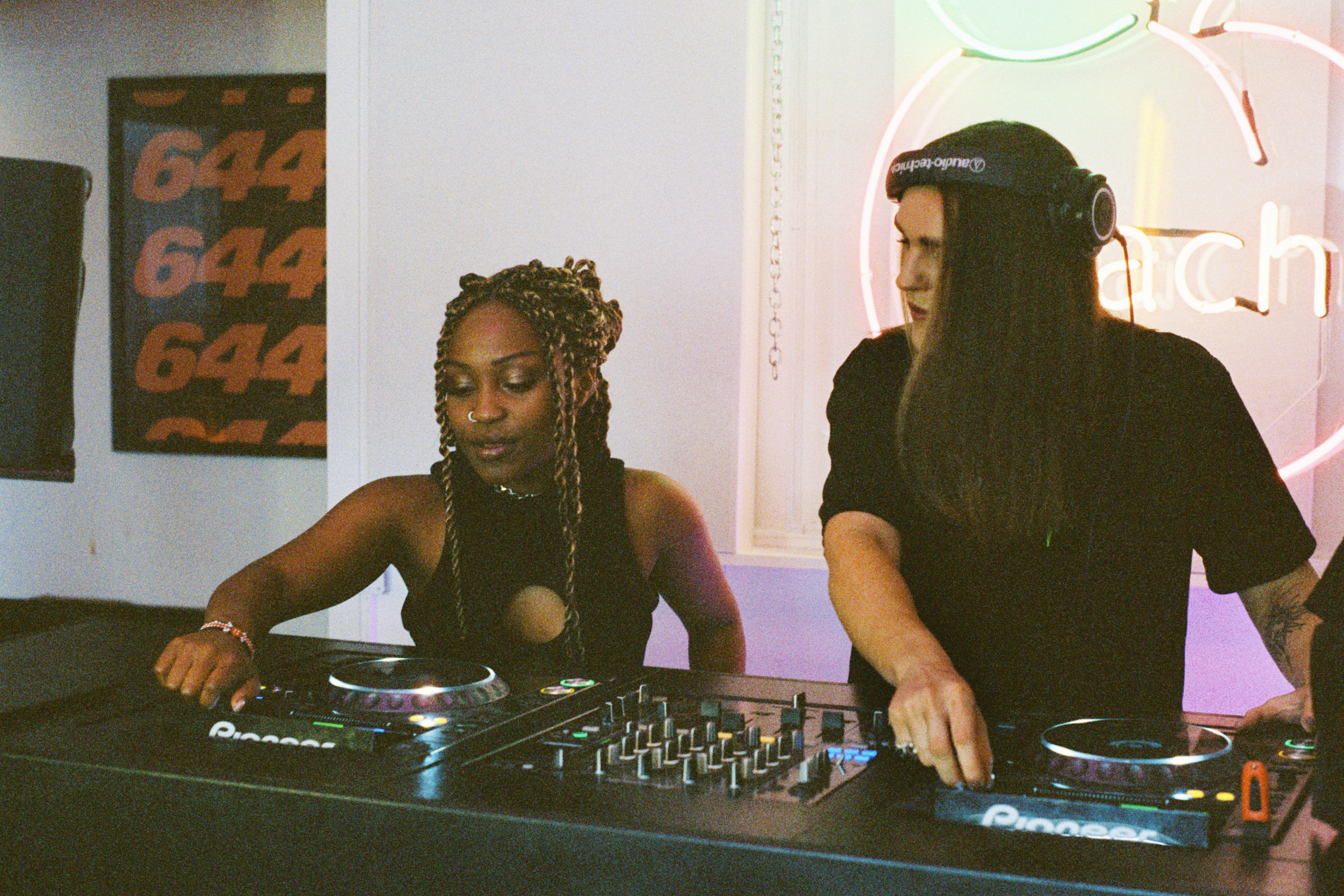
If I want to start DJing, where do I start? How does someone stand out today?
Kacie: Be your authentic self – what you really love always. Have your idea and run with it.
Start by looking at DJ tutorials on YouTube. There are also classes you can do, DJ academy is a good one. I know it costs a good fair amount so YouTube is a great place to start and head to pirate studios to practice on some decks. They have a DJ room for you to just spend hours and hours practicing. Practice is the main key. Even today I’m still spending hours practicing. You’ve got to stick at it and keep working on it.
Gather loads of songs. Invest in small pieces of equipment if you can. Maybe a little controller and some speakers, and go for it!
Utilise all the social media platforms, local radio stations, networking at parties. Make yourself known – send your mixes to promoters you want to take notice for future bookings.
Take what you can and most importantly don’t jump in with crazy fees and demands when you’re starting to get bookings. Be friendly and most importantly enjoy yourself.
What’s something you think needs to change about the music industry in Glasgow?
Lots, I’ve been actively working on this for years now. More women, more diversity on the line ups. There is a great group of people working towards this to help make change and doing amazing things in Glasgow.
I would say if you feel there is something missing or if you don’t think people are doing it right then let’s create more parties – be your own promoter, there’s a lack of nights in Glasgow, and if you feel like there is something missing, or someone isn’t doing it right, then start it yourself! Start small and grow. That’s how to actually make change.
Although we can sit and criticise the Glasgow scene I feel like there’s only so much you can do without support from the rest of the UK. People from around the UK and globally need to show a bit more respect to Glasgow and the people doing things: the creators, the promoters, the musicians, the artists.
The lack of interest and respect is a huge divide – they need to include us more. That includes magazines writing about Glasgow, brands wanting to collaborate, promoters, artists, etcetera. One thing I’ve noticed over the years is that when a promoter from down south decides to hit Glasgow with an event they never include anyone from up here, or even chat to a local promoter to see how it goes down here. Their night always ends up dead and everyone at the event leaves thinking Glasgow is shit which is so far from reality. Glasgow is amazing, but it takes a bit more work to put on an event here and YOU NEED to include the local community.
Where’s the future of Peach heading?
It’s all a natural progression, We won’t ever throw a party that doesn’t feel right for the sake of it or for just the bag. That’s why we don’t throw a party every month.
We’re working on more merch, different types of parties, different types of events, and opening more doors to more opportunities. We’re collabing a lot more with brands and promoters.
More DJs, More promoters, More brands, More music, More space, UK pop ups and Bigger parties.
IN TALKS WITH PURINA
04.08.22
Photographers: Greta Kalva and Alexander Cameron
Model: Purina Alpha
Words and Styling: Graham Peacock
MUA: Nikole M
Set Design and Nails: Greta Kalva
Studio: Basement 49
If you want to understand how the culture of performance art, club culture and Drag is changing in Scotland, look to Purina Alpha.
Whether she’s on stage at Glastonbury, Edinburgh Fringe, or a Glasgow queer bar, her refusal to be confined to one type of performance style, look, or Drag Circuit makes her as refreshing as she is unpredictable.
It feels like she’s in a world of her own – climbing to the top of Drag competitions and club billings rapidly over the last couple years, but she doesn’t necessarily want it that way. Purina’s performances are about joy – a celebration of her community and her art form, and this love for collectivism extends beyond her work on the stage. She doesn’t want it all to herself – she wants to lift up as many other people who feel like outsiders in the world she’s trailblazing through.
Chatting about her changing relationship with femininity and Drag, and the influence she hopes to have on other performers, Purina represents a shift in how we understand what community-centred creative circles can do. Purina Alpha was borne out of encouragement and guidance from a friend, and this reassurance is what she seeks to give to other people through her work. If you ask us, it’s going well.
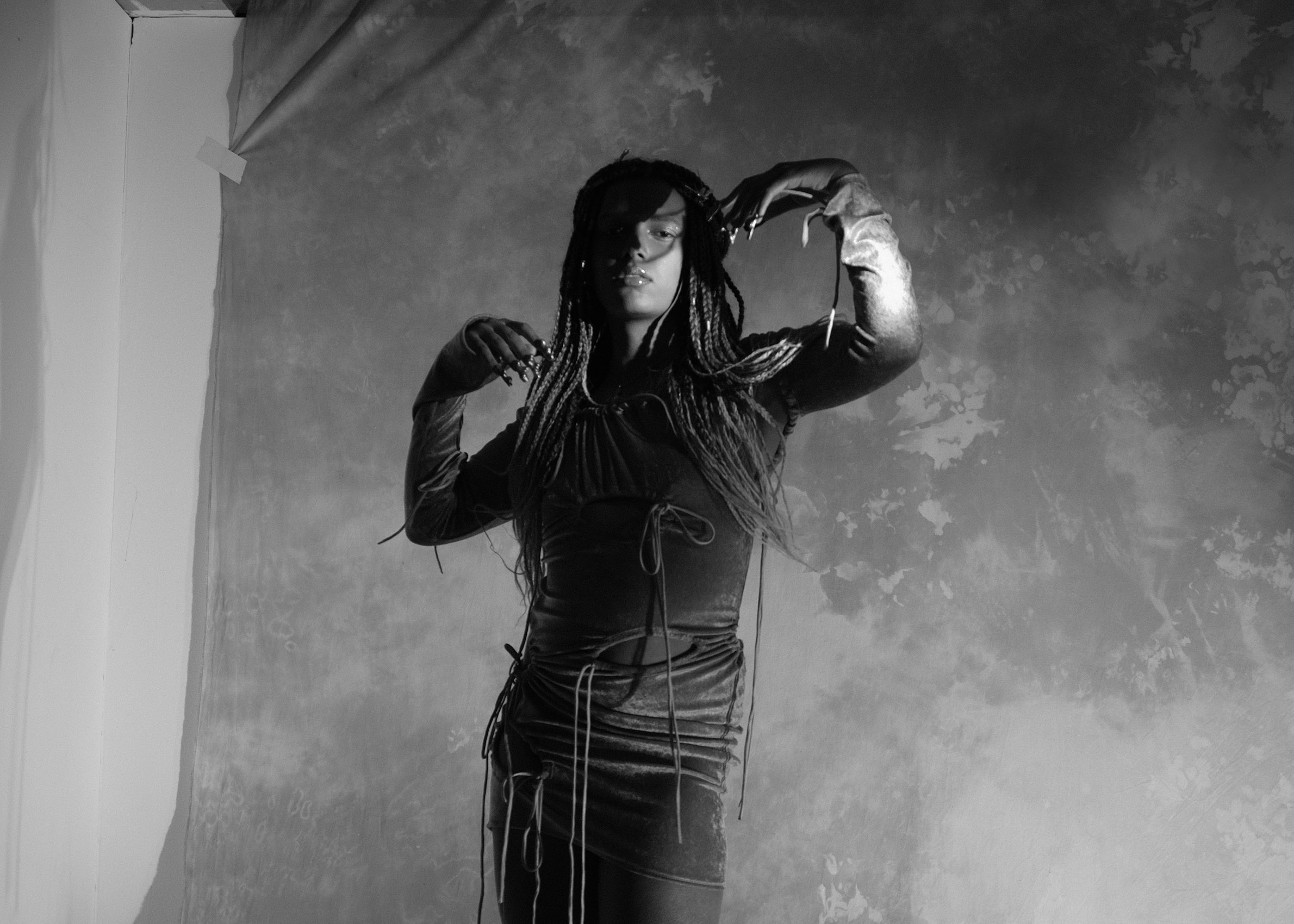
Hey Purina, how are you feeling today?
I’m feeling really good today. It’s been a really fun shoot. I’m really happy with how it went.
Tell us about how you got started in Drag.
I started by working at a bar. I’d just moved to Glasgow about six months before and was working with someone who was a resident at Delmonicas and I mentioned that I was interested in Drag but wasn’t sure if I could do it being a woman and be accepted, and they told me I would be. So that’s how me and my drag sibling got started. We started off at amateur competitions. A couple months later I did the Edinburgh Fringe. We both just went from there, and now me and my Drag sibling have crowns in Scottish Drag competitions.
Drag culture seems to be in a constant state of evolution. What’s the biggest difference you’ve noticed since you started out compared to now?
Just this Wednesday, I went to see the same competition I debuted in. It was so different. The level has really improved. People at the beginning are top tier – when I did mine nobody was at that level. It’s changed a lot in that sense. I feel like that’s come with the progression of Drag Race; it’s caused people to hold themselves to a higher standard and things are more competitive now. People are coming out the womb fully ready.
Competitive in a bad way?
Not necessarily. People are holding themselves to a higher standard and have more people around them. It’s nice to see the new generation coming up. There’s more POC people. When I started, Ann Phetamine and I were the only POC Drag Queens in Scotland, and I’m still the only Black Drag Queen. So we’re hoping that’ll change.
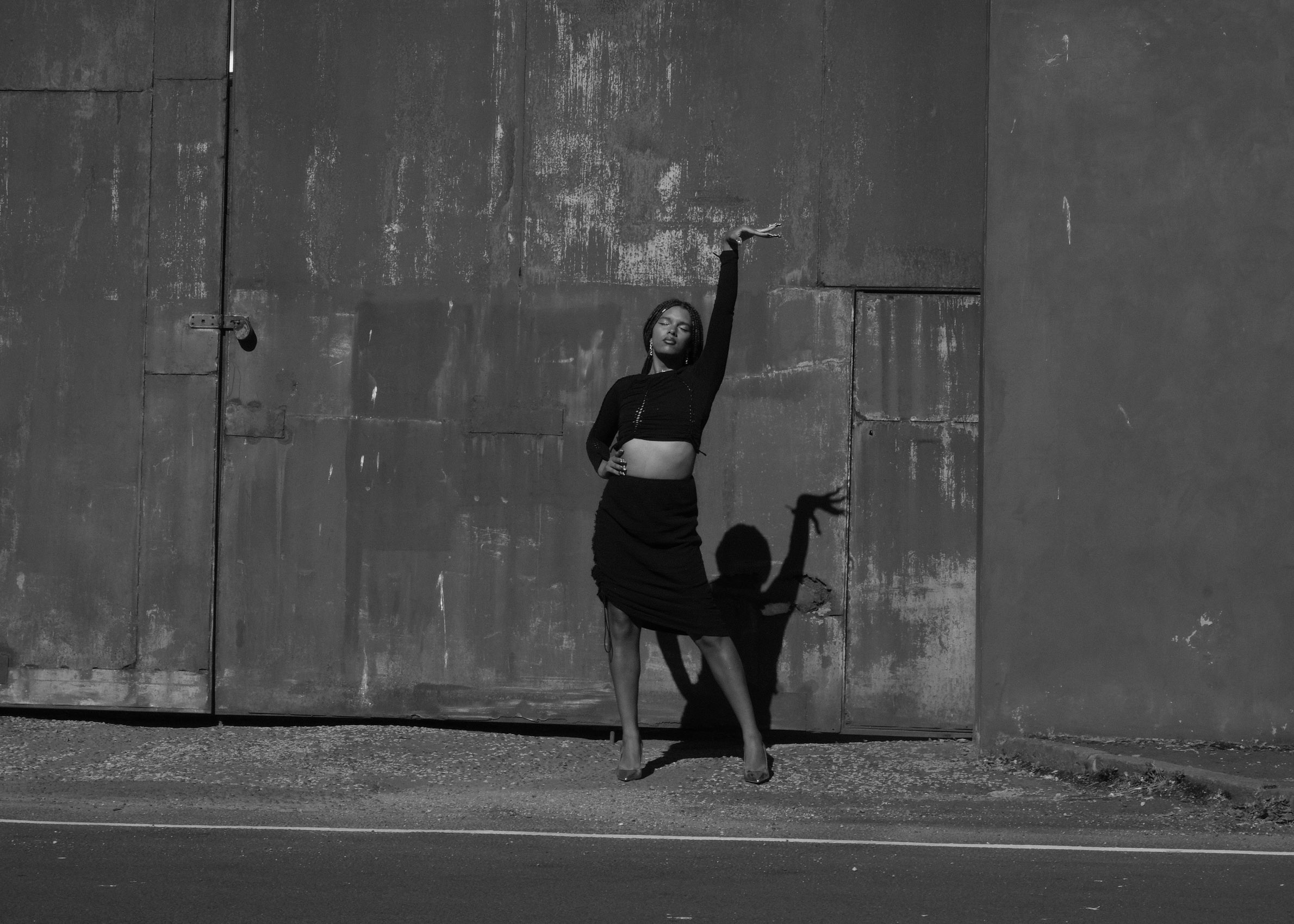
And where do you see the future heading?
In Scotland I’m seeing more people of colour picking up the brush and starting Drag which is nice to see, because that wasn’t something I had. When I was starting out there was no one I could ask about makeup advice specific to my skin tone. There’s now people with similar skin tones to me starting Drag, and it’s nice to hear from them that I’ve been a good influence.
I see the future being more diverse. In Scotland and in the wider worldwide Drag world things are going in a new direction, and we’re gonna see more progression and more firsts.
Is Purina Alpha a character?
Umm. The way I’ve viewed that question has changed. I suppose originally it felt more like a character in that I still had it in the back of my mind that as someone who is a woman outside of Drag I needed to give some big transformation when I got into drag. I’d have very bold features, spirally paper lashes and a dark purple lip – it was my average beat. It was a bit Disney villain, not in a bad way – it was just the thing I’d do. Earlier this year when I started my competition I started off with that look and as I went on I started to change to something more natural. At first that was due to me being in a not great headspace so I wasn’t able to do the whole blocking brows thing. But I kind of went with that. I felt that being a trans woman is enough and I don’t have to have this big mask. I’ll still do those big looks on the right occasion. Now I find that Purina Alpha has blended with me more than before. It’s just a heightened version of me.
That’s interesting that you felt that pressure of having to do the most extreme feminine version of drag. Did you feel like that was an expectation on you?
Yeah I did. It wasn’t necessarily because anyone put that pressure on me. I did like to do those major looks at the time, I enjoyed it. Obviously outside of drag trans women are held to a certain level of femininity, and that’s even higher for black women. Drag has been a way for me to escape that and not worry if a movement looks androgynous or masculine. When I’m in Drag I shouldn’t have to worry about gender, that’s kind of the point of it. I’m reaching the stage where I don’t need a big mask, but I do still love big lashes from time to time.
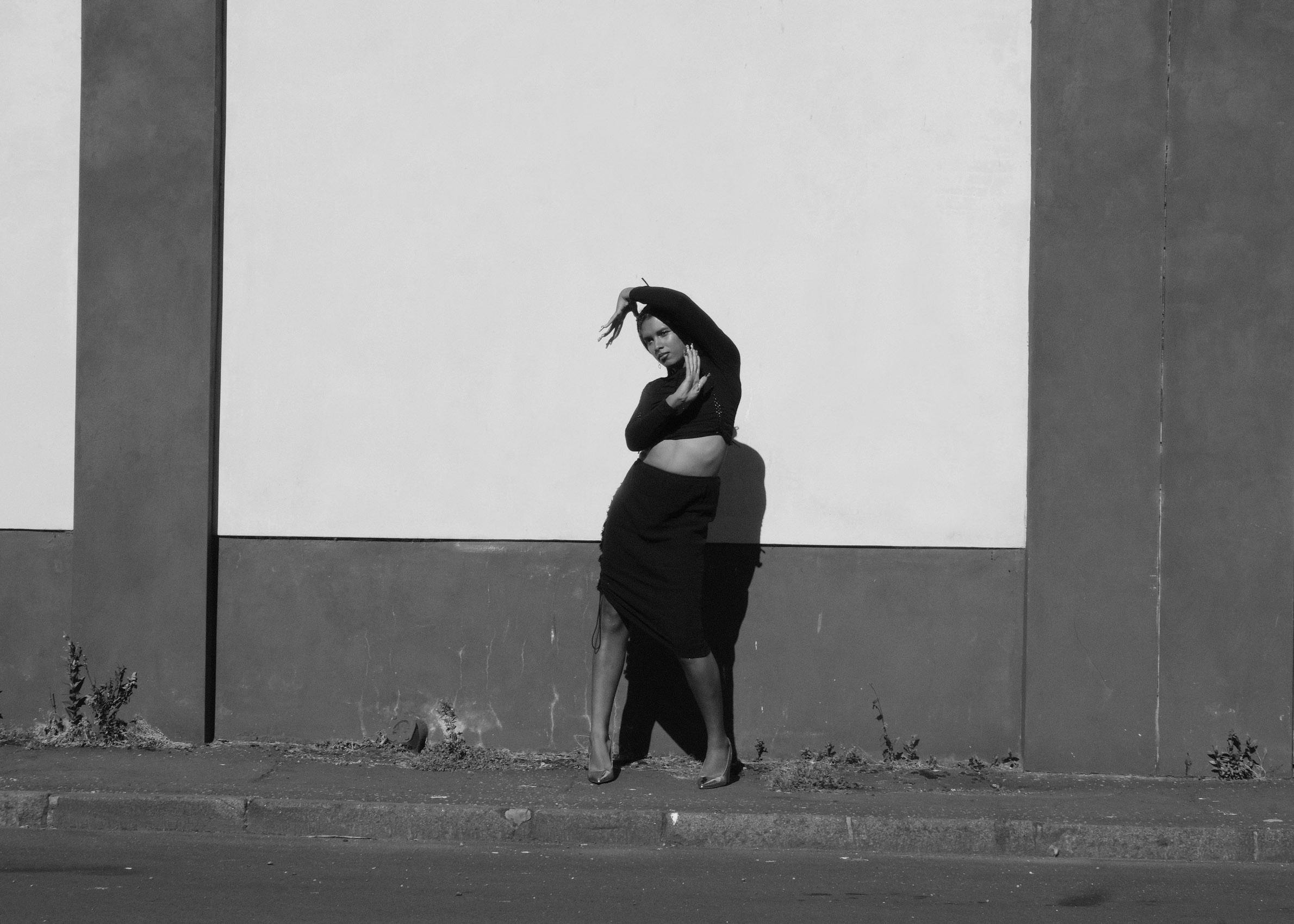
I imagine it could be difficult when your vehicle for self-expression is tied up in your work. How do you stay energised and motivated?
I think I’m reaching a point now where i’m still looking for the answer to that honestly. I love what I do, I have a passion for it. It’s rewarding. I performed twice last week and both times people came up to me telling me how much seeing me has helped other people, seeing me represent people of colour. People have thanked me, which has been really nice to hear. I think that’s my answer, that’s what motivates me – seeing my art influence other people for the better.
Your performances are always filled with joy. What pisses you off?
Working in the industry? There’s definitely some things that are unfair. Some people in the Scottish scene’s behaviour goes unchecked because of positions of power. That frustrates me. Some people who are well connected but not very original get more bookings than people who are original but don’t have friends in high places. That annoys me and other people in the scene. That’s not how all the Scottish circuit is, just certain corners.
It feels as though you’re always working with new upcoming talents, whether they be DJs or designers. Do you feel a responsibility to bring other people up with you? And what is it that makes you decide you want to work with someone?
The people that I work with that are creative and my friends isn’t necessarily because i’m friends with them, it’s because I like their art, and I like what happens when it comes together with my artistic practice. It’s not that I feel a responsibility, I’d do it anyway. I’ll always enjoy working with my friends. I’ve gotten more into performing for DJ sets recently, I love doing that with my DJ friends because it’s a nice marrying of my dance and their music, and same with my friends who make clothes.
It’s been fun spending the day with you. Favourite look from the shoot?
It’s hard to decide. For me, I think the all black look was my favourite. The passersby seemed to agree.
SCULPTING with PJ HARPER
20.07.22
Featuring PJ Harper
Photography by Alex James Aylin
Styling by Tamara Turnbull & Graham Peacock
Words by Graham Peacock
PJ’s sculptures arrive at the studio in a brown cardboard box, filled high with styrofoam and bubble wrap. Whether contained in layers of packaging, laid out across the dressing room table, or placed around PJ himself, they centre the morning’s conversation. There’s a presence to them.
There’s a self awareness as well – as much a celebration of femininity as they are an eye-roll to the expectations put on the female pop culture icons Harper has been inspired by. They’re tangible manifestations of the sculptor’s own influences – his family heritage, his cultural fascinations. The women appear calm, indifferent, playful, effortlessly cool. Some of them sit in neon two-pieces, others lounge stretched out with mermaid tails. Some are nude. Some are busts that stop at the neckline. They’re all carefully handmade by PJ in his studio.
With a soaring online presence, the sculptor, who also goes by @pig.malion, creates sculptures that feels equally at home on a bedroom table as they do in a gallery for a global exhibition. Talking us through his process, his plans, and future ambitions, PJ sheds light on the mystery behind his work.
Hey PJ, nice to meet you. It’s nice to be around your sculptures this morning. How does it feel being so close to your work?
It’s nice to meet you too. I’m doing good, thank you for having me. It feels good, actually. It’s always interesting to see my work in different locations as opposed to just sitting around in my flat or studio space.
Why sculpture? How would you compare sculpture to other art forms, and have you explored any of them?
It’s got to be sculpture for me. Ever since being very young I’ve always had a fascination with small figures and dolls which has led me to where I am today, creating my own. I’ve dabbled in a bit of everything, whether that be painting, printing or video work, but nothing has my heart like hand sculpting.
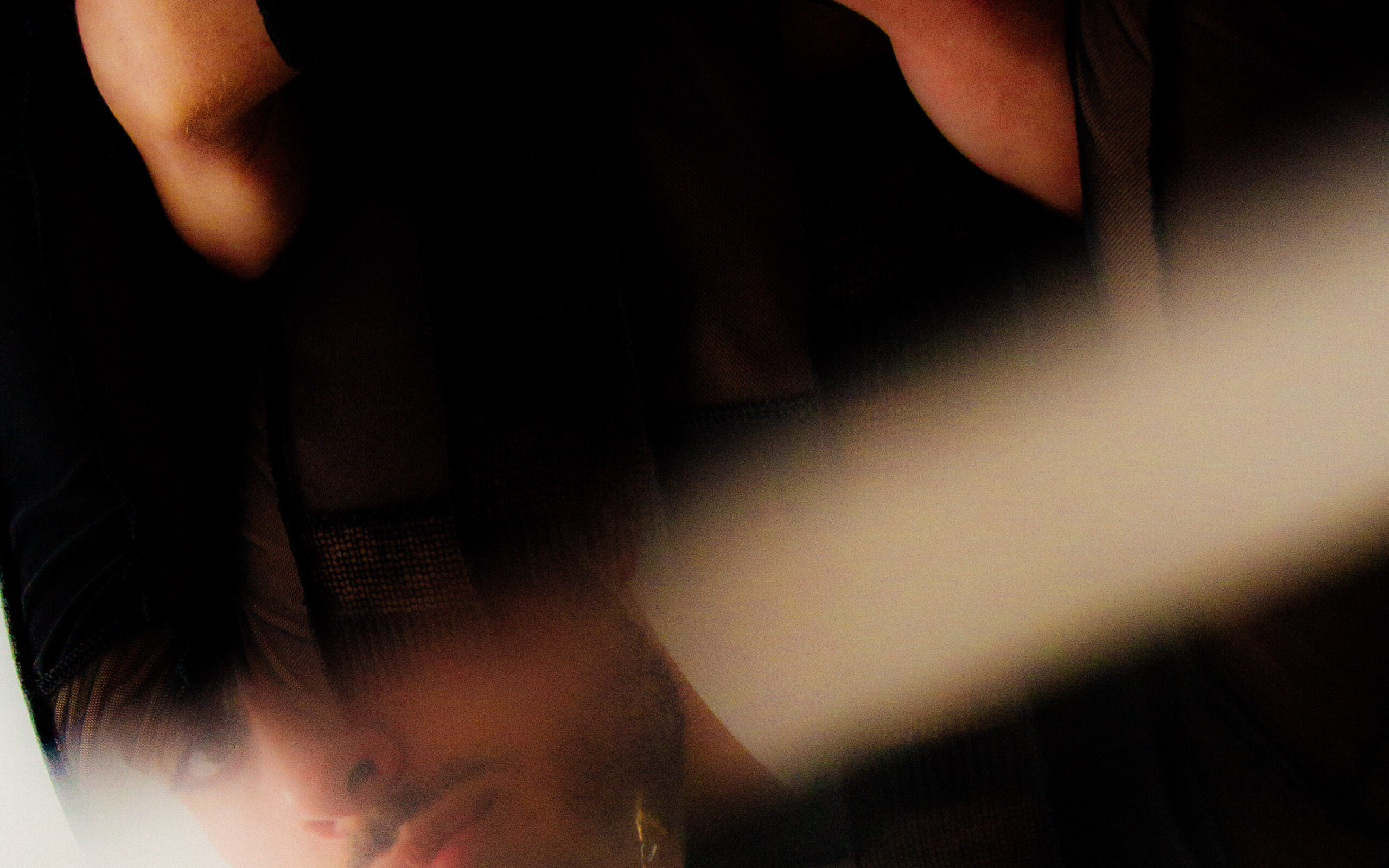
You talk a lot about lineage through your work – your sculptures are often based on women who’ve impacted your life. What is it about family and femininity you’re so drawn to?
Yes of course, I’m incredibly proud of my black heritage and I want to represent that always. My mum has definitely been the biggest influence for me, and my grandad. Despite all the hardships they have endured because of their ethnicity they have always maintained a positive outlook on life and I find that super inspiring. You know, I think it’s because I’m gay. Haha! and ever since being young I’ve always been obsessed with women, divas and all things feminine. I’d like to think of my work as my expression of the divine femininity.
Tell us about your relationship with masculinity and the masculine figure in art?
Well, as I just mentioned my two times Mr Universe grandad is one of the major influences on my work. I suppose it all really starts with him and what he was all about. Originally he was from Antigua and Barbuda, and was a competitive bodybuilder who also did a little bit of acting. This whole idea of body culture and black excellence has just been something I’ve always known, so it’s only natural that I want to push this within my work.
You’re bridging a lot of influences. Mythology obviously plays a big role. What else are you looking at and taking notes from?
Pop culture now and from the past, for sure. I’m a very nostalgic person and I love to look into the past as I find that this informs the future. I’m a sucker for anything 90’s – whether it’s movies, music or fashion. This is definitely the era I find most inspiring. I think had I not been a creative person I would have been a historian.
As a former Glasgow School of Art student, how do you feel about creative institutions?
I think it totally depends on the individual and how well you deal with that kinda thing. I didn’t really enjoy my time at GSA. I found everything to be too fast-paced and I couldn’t handle the essays, although I learned a few things for sure. I will say that my portfolio prep course at Tramway to get me into GSA was my artistic awakening. They really helped me to develop my understanding of what was important to me.
What advice would you give to someone about to leave art school, looking to transition from university to a career in their field?
Be sure of yourself. I wish I had known this sooner – it’s the most important thing that you believe in what you’re creating or doing. Having integrity will get you far.
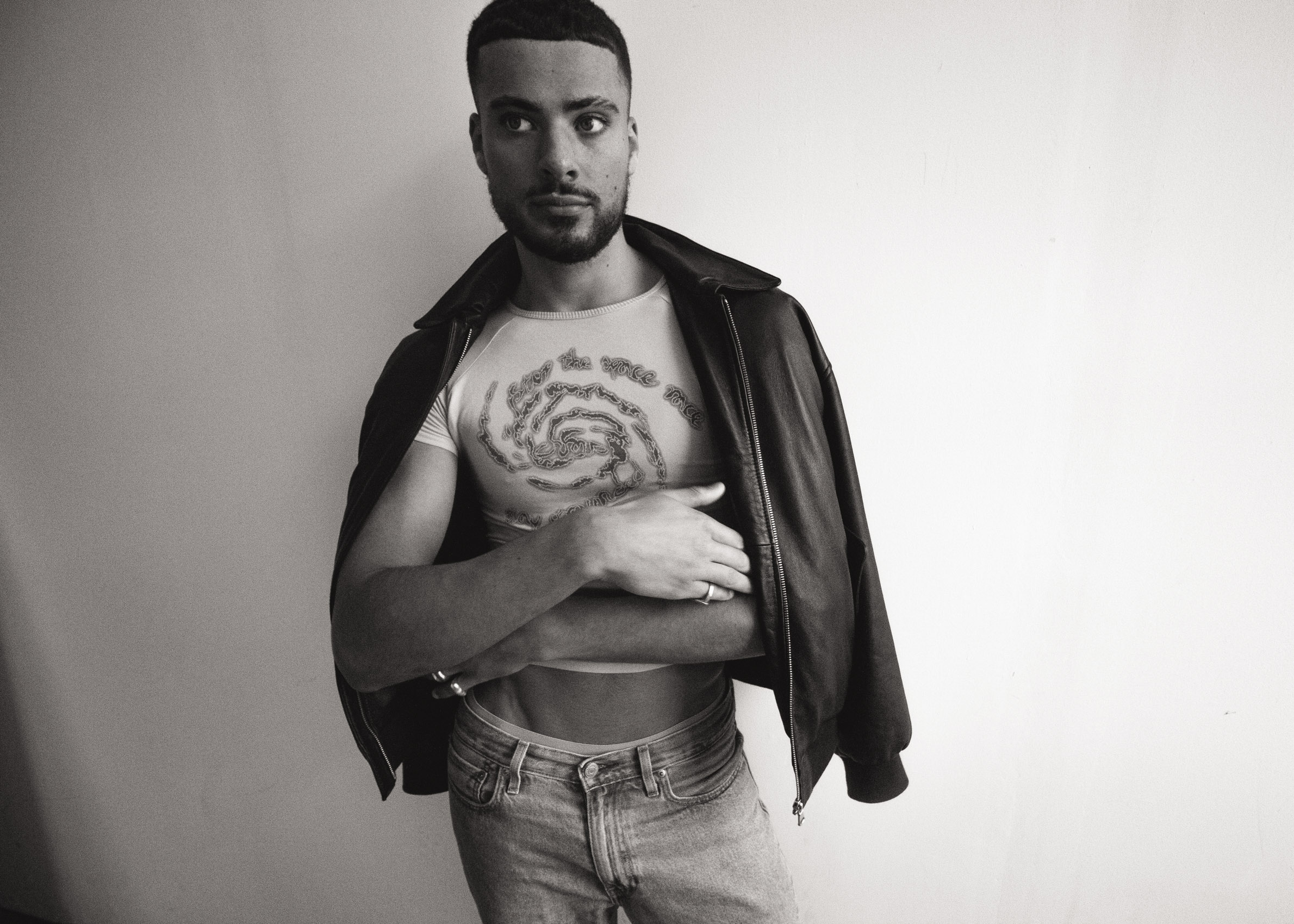
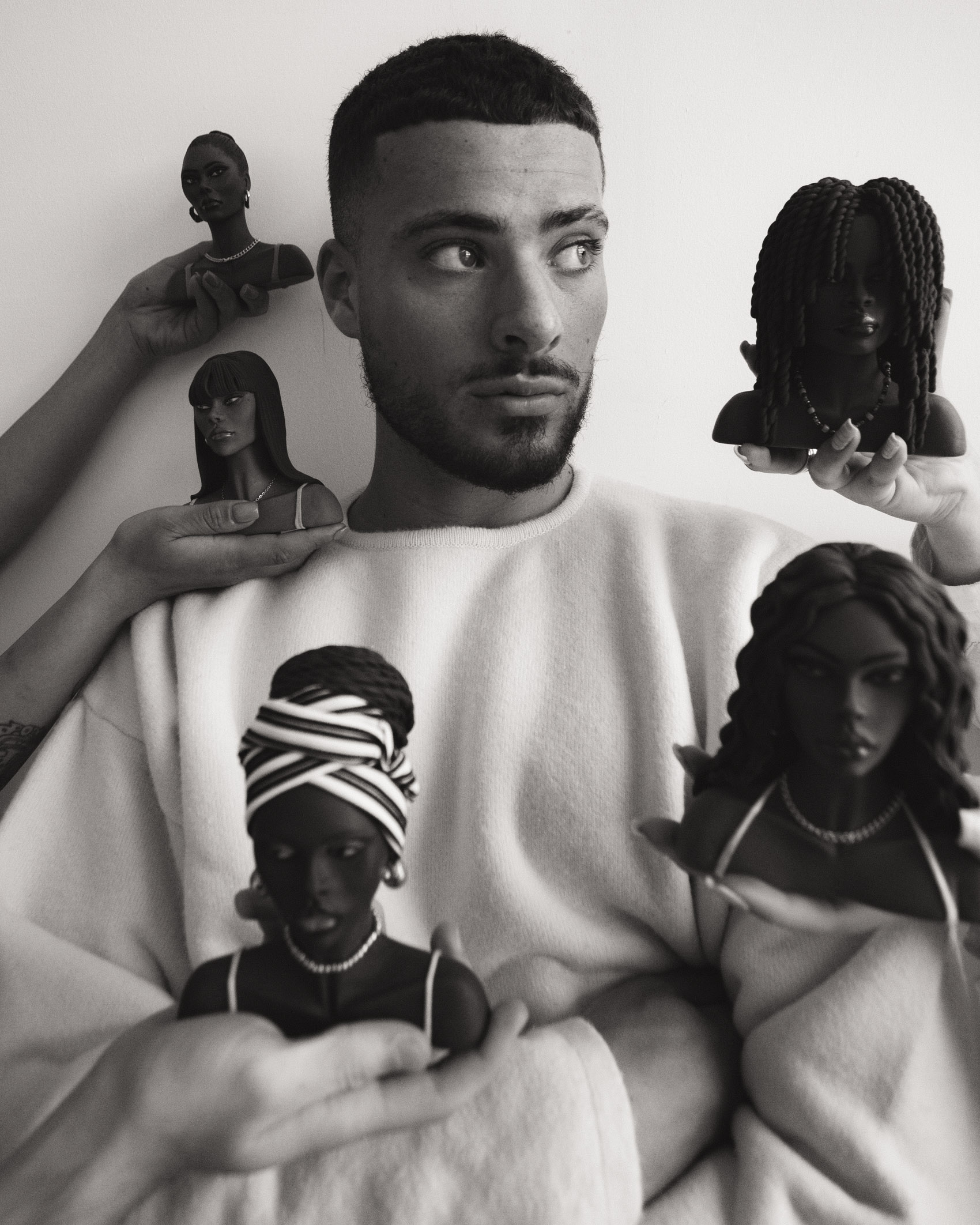
People talk a lot about how difficult it is to establish a creative career from Glasgow as opposed to elsewhere in the U.K., but you’re proof that that’s not necessarily true. Do you see yourself always being here?
It’s incredibly difficult but it happens and it’s important not to give up if things aren’t happening fast enough. I don’t see myself staying here for too long. I’d love to take my work to other countries. I want to do America just to see what it’s like, but these are plans for the future. Right now I’m quite happy in Glasgow.
You’ve worked with a lot of big names. We loved the sculpture you did for Jorja Smith. Who’s your dream collaborator?
Thank you, that was such an amazing opportunity for me. Being a fan of Jorja for a while then getting to collaborate was truly fantastic. That’s a difficult one, there’s so many people I’d love to collaborate with. I’d maybe have to say Erykah Badu, Rihanna or Megan the Stallion, but the list of dream collaborators is endless!
We imagine there’s been a shift in your relationship to your work since gaining a bigger profile. How do you stay focused with all the noise going on around you?
The main thing for me is that I want to make all my ideas and I end up overwhelming myself with a ridiculous amount of work, I’m now starting to realise I can only do one thing at a time. But I’m so lucky to be in such an amazing position with my work right now and it’s exciting to see what the future has in store.
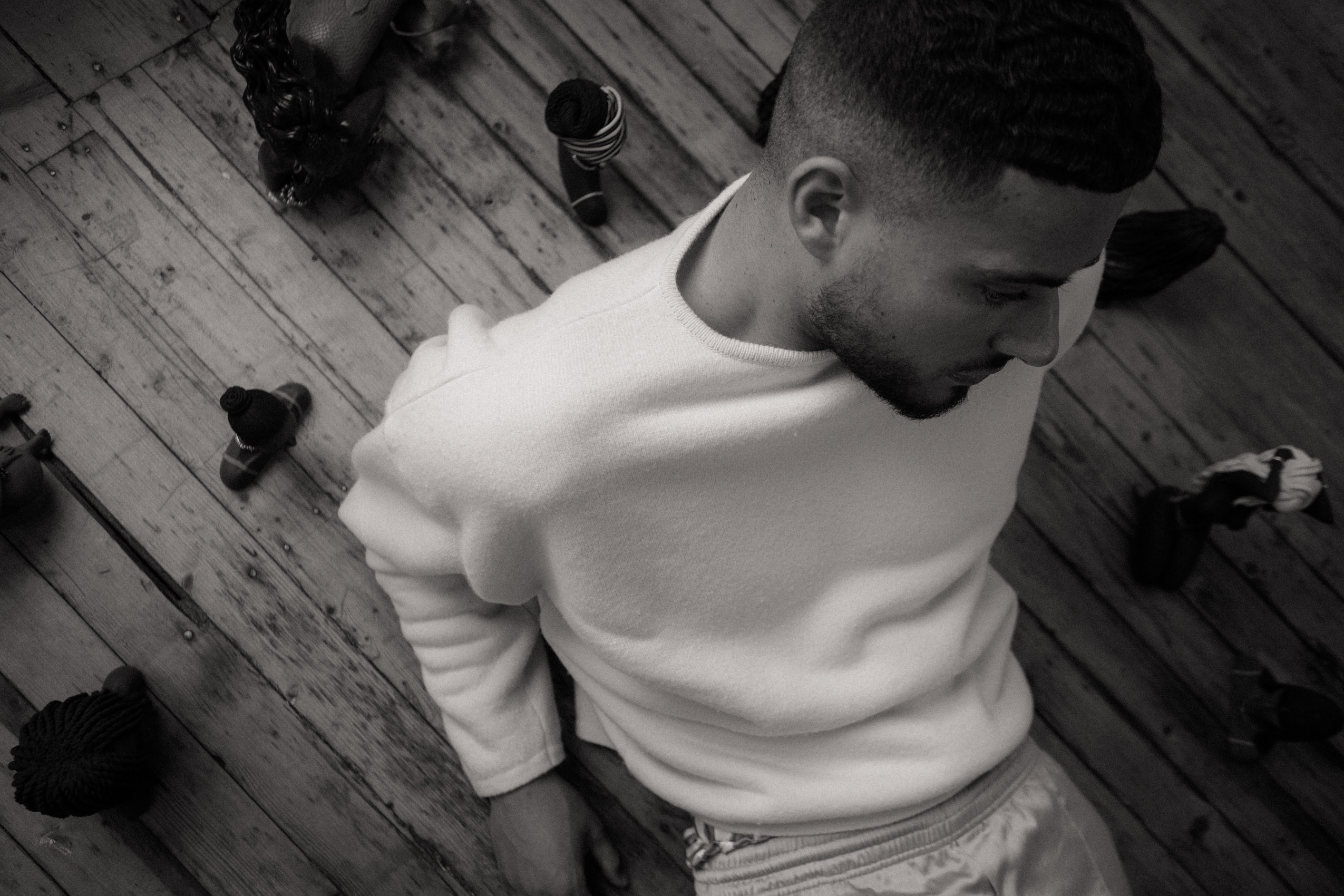
A NEW DARK-AGE with SHREK 666 & Lucid
07.07.22
Featuring SHREK666 & Lucid
Words by Graham Peacock
Styling by Tamara Turnbull
Photography by Bethany Grace
Fetish, magic, and surrealism collide in the work of SHREK 666 and Lucid. As individuals and as partners, both performers move through Scotland’s creative circles, embodying gothic folklore whilst innovating the country’s club scene.
They’ve emerged as something of an industry blueprint: charting a new path for queer perfomers, reminding them that a devotion to a single practice is as unneccessary as appeasing the mainstream. Taking in DJing, tattoo artistry, performance art, and prosthetics work, the term multidisciplinary barely scratches the surface of the couple’s work. And is it all paying off? Their roles in the launch of ‘Trollops’ at Glasgow’s famed Berkeley Suite in the same month as their prime-time set at Riverside Festival suggests it might be.
Their increasing omnipresence in Scotland’s club spaces hasn’t diluted the air of mystery that surrounds both SHREK 666 and Lucid. Getting to the bottom of it all seems to spoil the fun, as the couple most likely know, but our conversation with them got us thinking about the power in sexual liberation and queer collectivism.
Check out the feature below. The main take-aways: conventionality is dead, kink is forever.
Hey SHREK666 & Lucid, How are you?
SHREK666: Hey, I am well thanks. Pretty tired today after a big weekend but feeling joy from it.
Lucid: Enjoying the sunshine today and having a relaxed Monday.
Who is SHREK 666?
SHREK666: SHREK 666 is my performance avatar of an ogre embodiment. The name and troll I’ve been working under for years now.
Lucid: The love of my life.
Your artistic practice covers prosthetics, DJing, tattoo artistry, and performance. How do you describe yourselves as artists?
SHREK666: Multidisciplinary. I work mostly in performance and as a maker and director and collaborator on a wide variety of projects, shows, and events. It’s more about concept and feeling before medium.
Lucid: I am a performer and collaborator. I give creative direction as well as concept input for various multimedia and live performance projects.
It feels like you’re everywhere at the minute. You performed at Riverside which is such a staple in Scotland’s festival circuit. What was it like performing in front of that crowd?
SHREK666: It was fun, the reaction was fab. My slot was in between Big Freedia and Roisin Murphy on the main stage which was kinda crazy. To be on a festival lineup so full of queer representation is a rarity and shouldn’t go unnoticed, and that was due to the hard work of Bonzai Bonner. Safety is a big issue however when mixing crowds. I know of multiple trans* people who were physically and verbally attacked. There’s still work that needs to be done.
Lucid: I was working BTS at Riverside, stage managing and working artist liaison. The Saturday had the most diverse line up that
Scotland has seen on a festival.
Both of your work appears to take influence from medieval imagery, body horror, religious imagery, and folklore. Have these been lifelong areas of interest? What shaped your performance style?
Lucid: We are both into surrealism and magic. As well as being goths these things influence our performance style.
SHREK666: We’re in a new dark-age.
Congratulations on the launch of Trollops at Berkeley Suite, too. Can you tell us a bit about the backstory and purpose of this night for readers who don’t know?
The backstory is in where the fight for sex workers rights and queer & trans rights meet. It’s a space that celebrates those intersections evolving strip club culture to the next level so it’s not just for cis men. A way of thinking about how you can appreciate bodies respectfully and showing how it’s perfectly possible to respectfully “objectify”. Also, importantly, Trollops is giving opportunity and celebrating trans* & gender nonconforming dancers for the first time in Scotland.
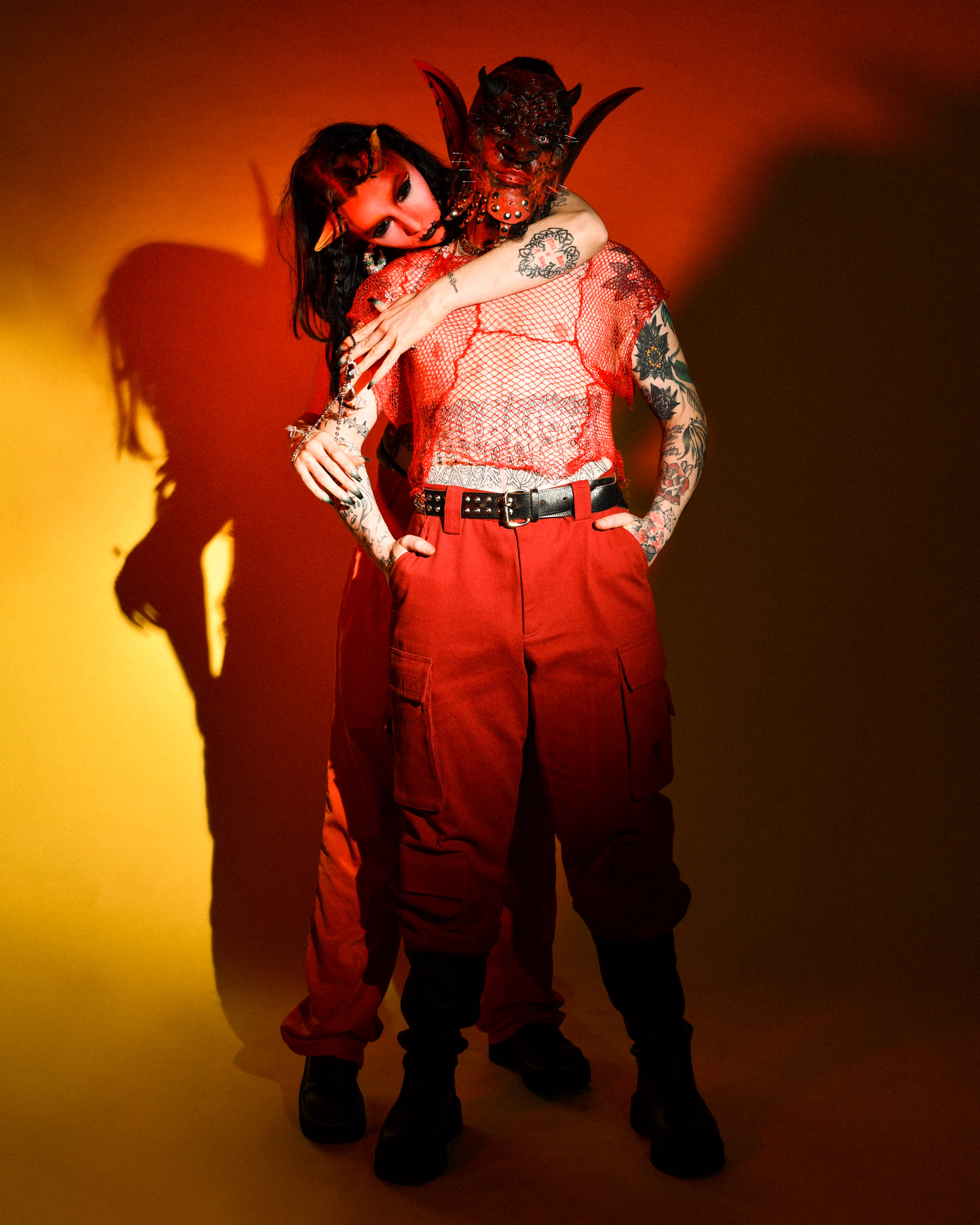
SHREK666 wears Jean Friot
Trollops felt like at its core a celebration of sex in all its forms. It can be easy to forgot how binary and prudish mainstream discussions of sex are. What are you both hoping to communicate about sex, sexuality, and relationships through your work?
Lucid: We tend to play with fetish and power play when we work together. We like it when our audience leaves thinking about why they feel a certain way and hopefully it can open some peoples perspective up on sex. Our audiences are placed delicately into the role of a voyeur. As each person’s sexuality is individual to them we are hoping to communicate to the viewer as an individual that curiosity can be powerful.
SHREK666: Having a deeper understanding of pleasure and where those feelings come from will overall allow for more pleasure, better relationships, communication, and sex. I often use one specific fetish or kink as a starting point for a performance and explore within that, although there are so many ways to explore and share intimacy [other] than sex and we play with that through our performances.
The kind of spaces you both create, independently and collectively, no matter the event, promote love and acceptance. They’re spaces you can dive into and forget about all the anger and judgement outside. Do you feel a responsibility or even a pressure to be role models or spokespeople on queer topics?
SHREK666: I think who you choose to work with is important. Having a mutual understanding, ethos, and passion for making the space comfortable for especially queer people but open to all who show respect. We want and deserve a good time but these things take constant communication and work. I don’t feel a responsibility to be a certain way, I care about community and believe it’s important to share information.
Lucid: I do not feel pressure to be a role model or spokesperson. I have certain lived experiences that have shaped me and made me realise the importance of community and speaking up. Energy flow, blockages, and healing through movement have been a big part of my adult life. Hence why clubs have always been attractive to me: they can be a place to break patterns of shame, heal from trauma through dance, and share connection. There is however a level of whit and care required when working with club nights. Any space where d*ugs or alcohol will be consumed is not a safe space. These spaces are important and should be protected.
What’s coming up next for you both?
Lucid: I am studying Community Development in the Autumn, with hope that I will learn more effective ways of activism and hoping to continue to work in the queer and sex work communities.
SHREK666: I’m working on an exciting performance commission for Fierce Festival with my boglins and I’m doing a few more music festivals in the summer. Making more music, performance, and sculpture and working on future events for our collaborative club night which is currently called Ministry of Pound.
IN TALKS with SPENT
22.06.22
Featuring Spent
Words & Styling by Graham Peacock
Photography by Scott McWilliam
Make-up by MVB
Venue Bonjour Glasgow
It’s exciting to see an artist like Spent gain traction in the music scene. With infectious electronic beats, and a lyrical ability that sees them move between powerful and unbothered from one line to the next, Spent’s sound appears as effortless as it is unpredictable.
Not satisfied with solely releasing music, Spent creates an entire world for their listeners to immerse themselves in. With a bold visual style and innovative videos, Spent has emerged as a multidisciplinary artist who cares about serving up thought-provoking, hedonistic, complex work, and who doesn’t give a f*** about what everyone else is doing.
Having climbed through the ranks despite an absence of live venues, we visited the Cybersexy musician in Bonjour, a queer bar in Glasgow’s East End, to talk about all things digital, physical, and queer.
Spent! How are you?
I’m good. I’m feeling very extroverted, which is lovely for both of us.
We’re in Bonjour: a profit-sharing, workers co-op queer bar in Glasgow. How does it feel getting to perform in spaces created for and occupied by queer people?
It’s nice. It’s refreshing. When you’re coming up, and you’re performing in spaces where no one wants you, and no one’s ultimately listening to you, and you’re just selling your soul, it can be a bit disheartening. I think especially for queer people that’s kind of just everyday on the street. So it’s quite nice to come into a space and be turned the whole way up and be fully you and do your art, and everyone’s there to really be there. It’s nice. It’s good.
Tell me about your name.
It’s simple. Spencer is my last name, Teddy is my first name. So, half of Spencer, and T for Teddy. But the alternate way is Spencer, and I’m bent, so: Spent.
We’ve read other interviews you’ve done, and you talk about Spent in the third person. It feels like Spent is more than just a stage name, do you feel like they’re separate from you?
It’s both, I think. Spent is completely informed by my personal life and my experience. It’s so personal, but I think by removing Spent from Teddy I get this freedom to be as creative as I want with no restrictions. It’s removed from the physical space so I can exist in the digital. And this can be expressed through sound, visuals, performance, anything. I think Spent just removes the limitations of physical space.
Your work seems more preoccupied with the digital world than the physical one. I think queer people find a lot of power in the way they present themselves online, do you feel this way?
Yeah, I do for sure. I think a lot of queer people do because it’s a space where you have complete agency to be whoever the fuck you want and do whatever you want to do. But I don’t necessarily think my work focuses on the digital space, I just think it focus on queer experience. I think, as I’m growing up, it’s more about how I then translate that into the world and the people I have around me. So it was very online-based, and now as I move on it’s more as a commentary on the time.
Speaking of the digital world, what was your most recent Google search?
‘LoveHoney discount code’.
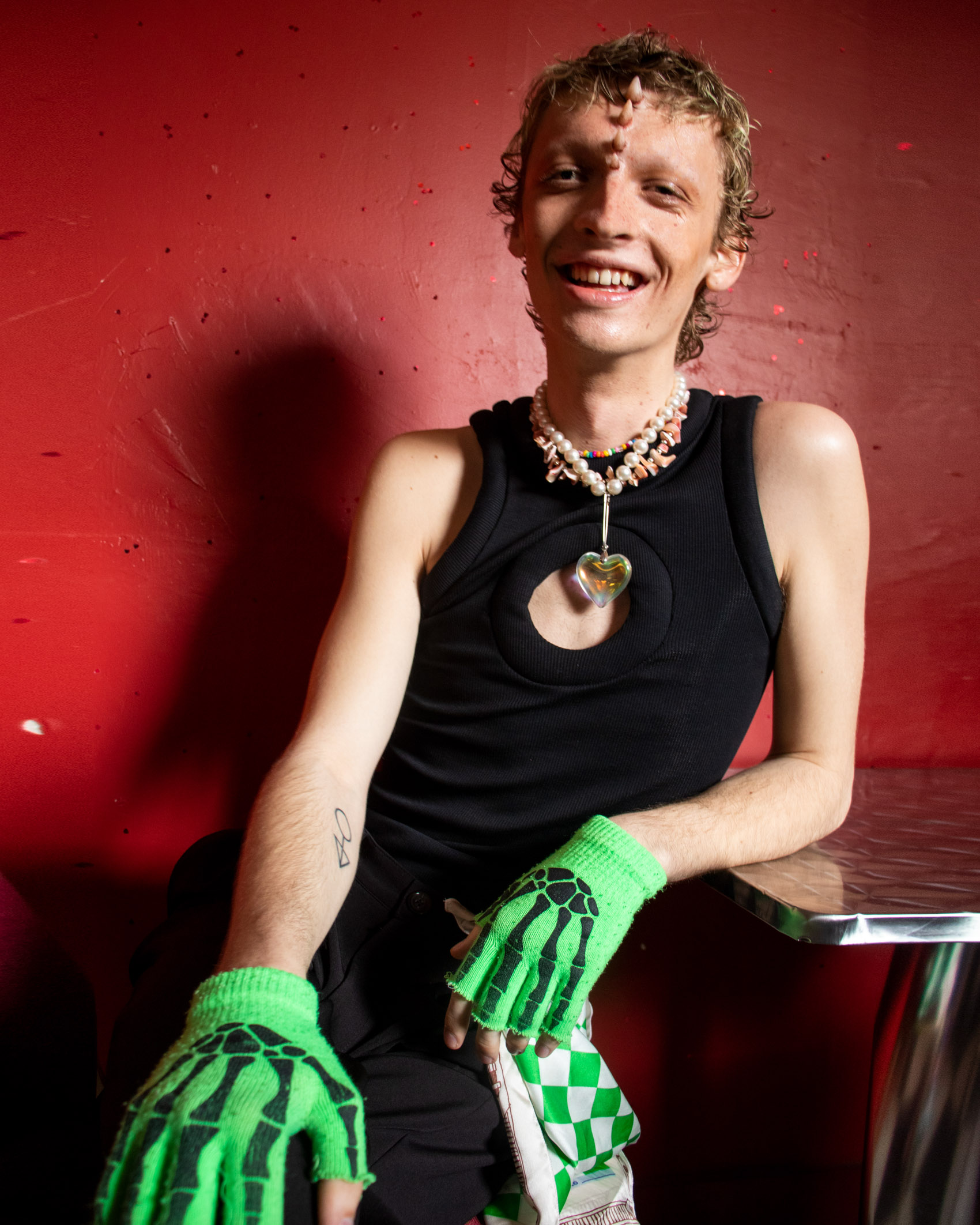
We keep listening to Cybersexy. Is this song part of a new project?
Yeah, it’s part of new stuff. It’s planting a foot in reality, this whole new project. I’m in my Basquiat era. Like, I’m not trying to paint a really realistic situation. I’m just churning shit out about the real queer, nonbinary experience. My new song is called Eyes. Cybersexy was the club, it was the online space. Eyes is that feeling of walking down the street with all eyes on you in the best way and the worst way. Like yeah I look good, but do you want to fuck me or do you want to fight me?
The same can be said for any creative industry, but the music industry feels especially fast-paced. Do you feel a pressure to release new music, or do you feel like you can take your time?
I definitely felt pressure with the last stuff. I was at uni full time and releasing songs and music videos every single month for a year. It was so intense, but I felt I needed to otherwise I’d be forgotten. Now I don’t feel that at all. I’m an independent artist, I don’t have a label. Okay, I might be in the industry, but I’m also not in the industry – I think that provides such freedom, because I can just do whatever I want. I believe in my music, I’m giving this perspective that hasn’t been given a lot before. Regardless of the sound, the subject matter, where it’s coming from, is not in mainstream stuff. So I don’t need to chase, I need to give my authentic real experience, and if that happens to be once every 2 weeks then fine, if that’s once every six months, then fine. It’s just about authenticity.
Speaking of authenticity, people throw around the term authentic, and they throw around the word experimental. But we feel like your work is genuinely both. It’s experimental in the sense that it fits into the genre of experimentalism, but listening you can tell that you yourself are pushing yourself to experiment within your sound. Who influences you?
I’m influenced by everything, and a lot of things. At the moment, it’s James Blake, Frank Ocean’s Tumblr – Patti Smith’s book Just Kids is the reason I moved to Glasgow. Obviously Arca, JPEGMAFIA, and Andy Worhol at the moment randomly. I was never really into him before now.
Okay, that’s all. I’m buying you a drink at the bar. What are you ordering?
A pint of your cheapest cider.
IN TALKS with MEDICINE CABINET
25.11.21
Makeup by MVB
Words by Tegan Jaimie
Scotland is a hotbed for musical talent, a burning underground scene that’s witnessed the likes of LUNCH pals Lucia and the Best Boys, Nova and TAAHLIAH ignite to roaring critical success. This week, we meet another burning talent, Medicine Cabinet, and let’s get started by stating it’s a Medicine Cabinet world, and we’re just living in it.
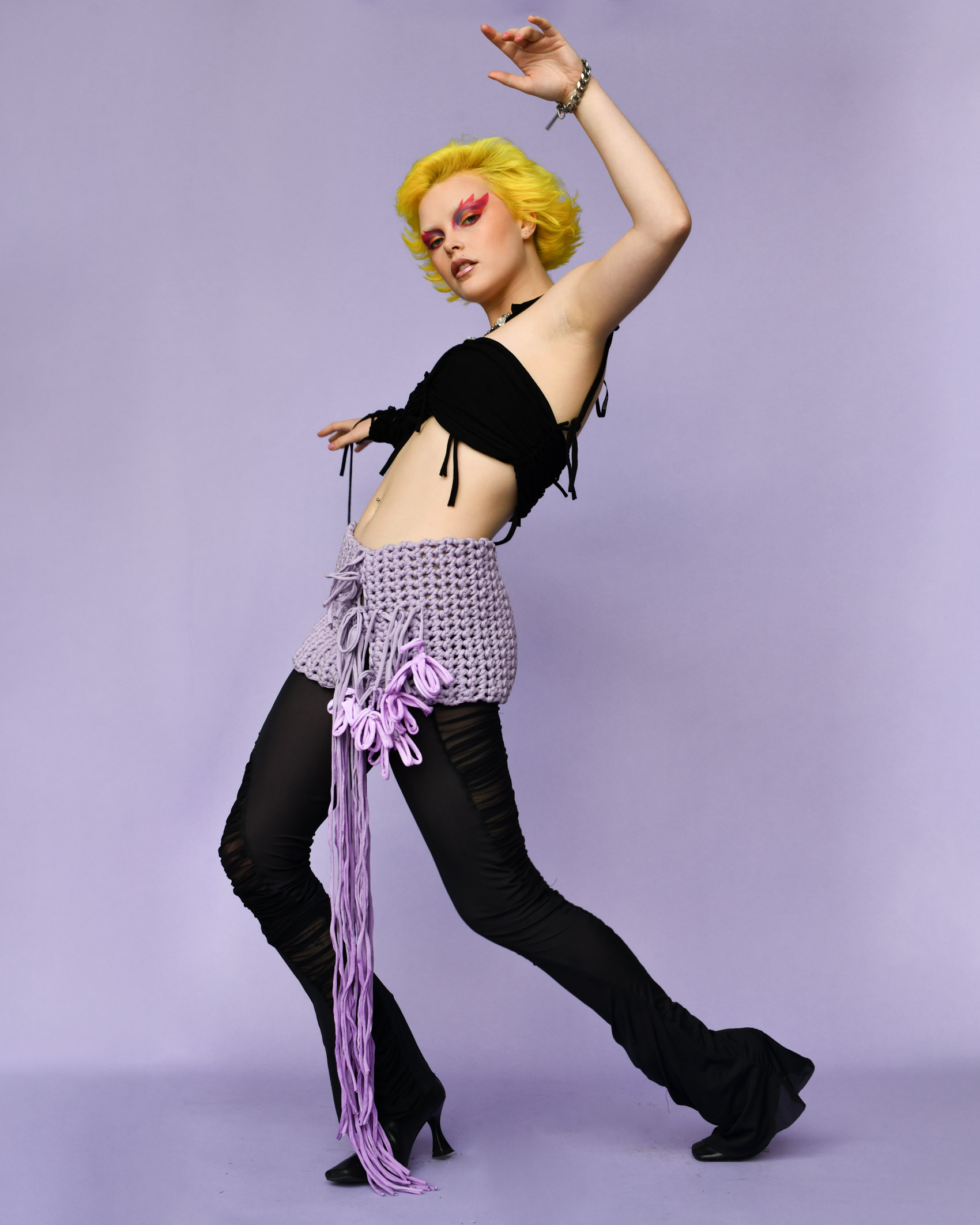
Still to release any music online, the five-some is finally ready to digitally debut. LUNCH chatted to Anna, Eilidh, Josh and Joseph about the serendipitous origins of the band, the theatrics of world-building on stage, and most importantly, their pre-gig snacks.
Anna and Josh originally connected over a mutual swipe right on Tinder but after establishing no romantic intentions the chance nature to their meeting was ultimately the beginnings of the band as we know it. In quick succession, the five-some had all crossed paths and with that their friendship and collective talent grew. “I kind of bookmark when the band started as when we all became friends. Because as long as the band’s been going together, and as the band’s progressed our friendships have progressed too” says Josh
And how does that friendship impact them as a band? “When you’re in a band because people are watching you on stage they can totally see when it’s bullshit. You can see if you don’t like each other and it’s not fun to watch. I think it’s nice to watch people have fun up there. If you’re having fun, people are gonna have fun watching you have fun.”
And fun they had. With a successful run of gigs across the early formation of the band, they quickly carved themselves a reputation as an act to watch. By gig three they were supporting The Murder Capital and Kingdom Management got in touch. “They sent us a message afterward and we’re like ‘Hey guys, we’re interested in helping you out with no strings attached for like six months’. And then yeah, after that six-month period everyone was very happy. Scott’s an absolute legend.” says Anna
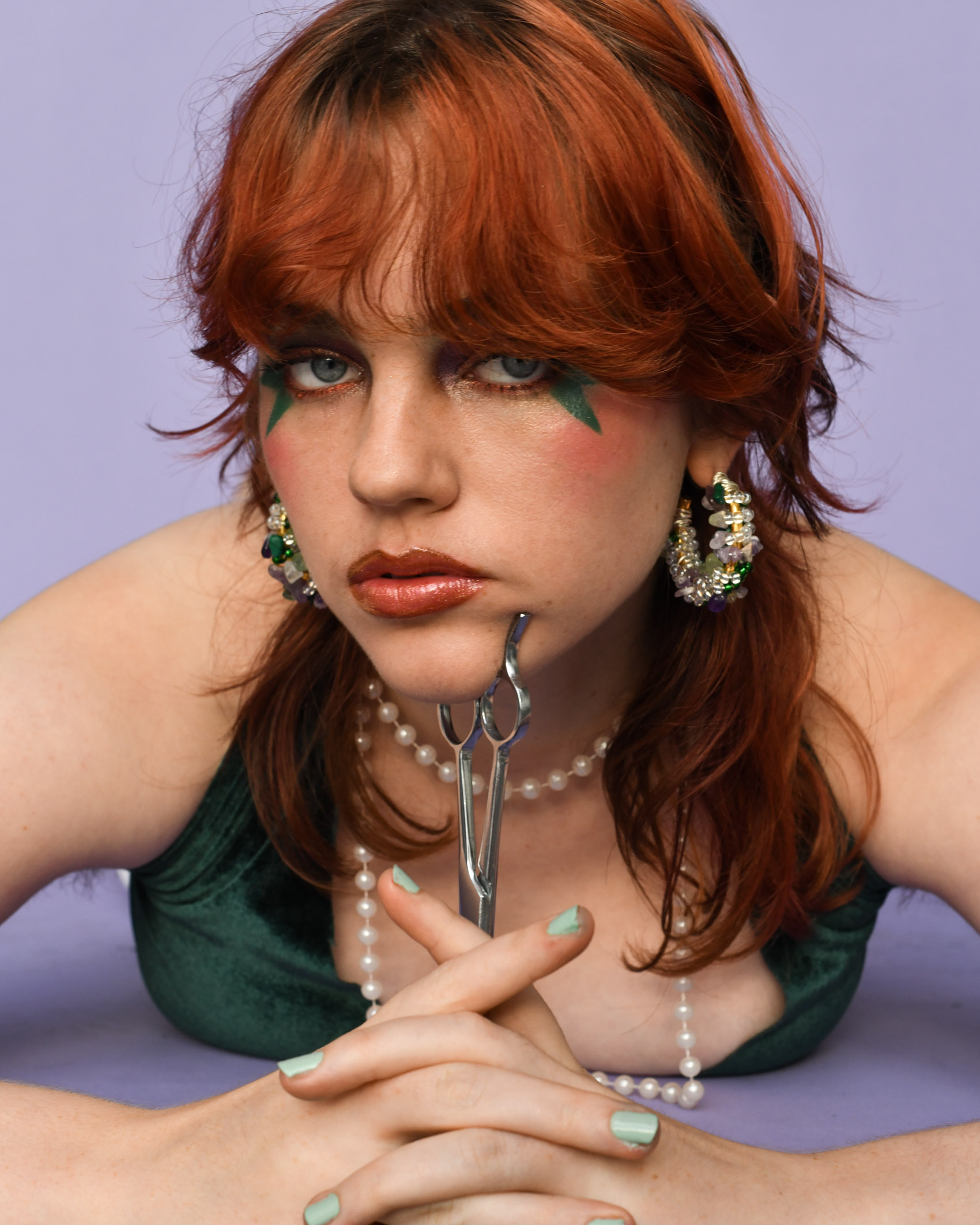
To have experienced Medicine Cabinet’s music you have to have been lucky enough to hear them live. With an uninhibitedness that dominates the stage, they were quick to point the likes of Grimes and Madonna as inspiration when it comes to the theatrics of gig performance. “Madonna’s stage stuff has been incredible as well. She’s amazing in terms of her world-building which is not where we’re at right now but that’s something that we would definitely like to do in the future. I’m picturing that one where she was sort of dressed as Mary Antoinette. It’s like an opera. That’s very cool.” says Anna.
So who are Medicine Cabinet channeling when they perform? “When we’re on stage we all sort of using it to embody saturated versions of ourselves. And that can change depending on how we’re feeling that day or what’s just happened to us in our lives.” explains Anna. This fluidity as a band hungry to explore different facets of their creative energy has kept them evolving and also caused the unlikely experiment of them not releasing music yet. “I think if the lockdown hadn’t happened we would have probably released by now. But I’m really, really glad we actually haven’t because during a lot of them we kind of changed everything up and wrote songs we kind of actually have always kind of wanted to write. And if we released when we were going it we would have been totally different band I reckon.” explains Josh
With gigs returning, Medicine Cabinet are back on stage and set to support Spector on their upcoming tour in January. Keeping on brand here at LUNCH, what’s the all-important pre-stage snack for the band? A collective agreement that you can’t go wrong with a Tesco’s meal deal and a Tennent’s.
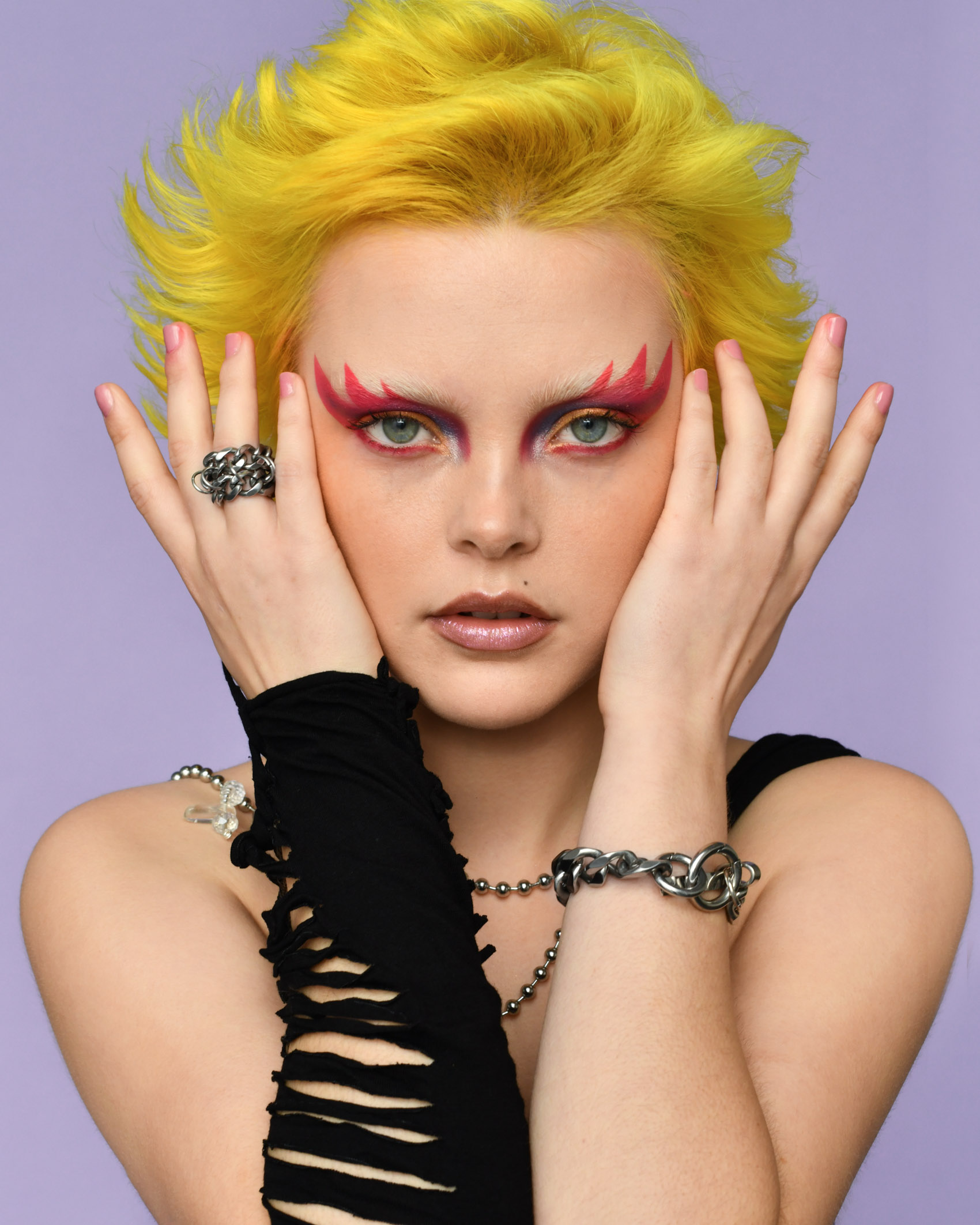
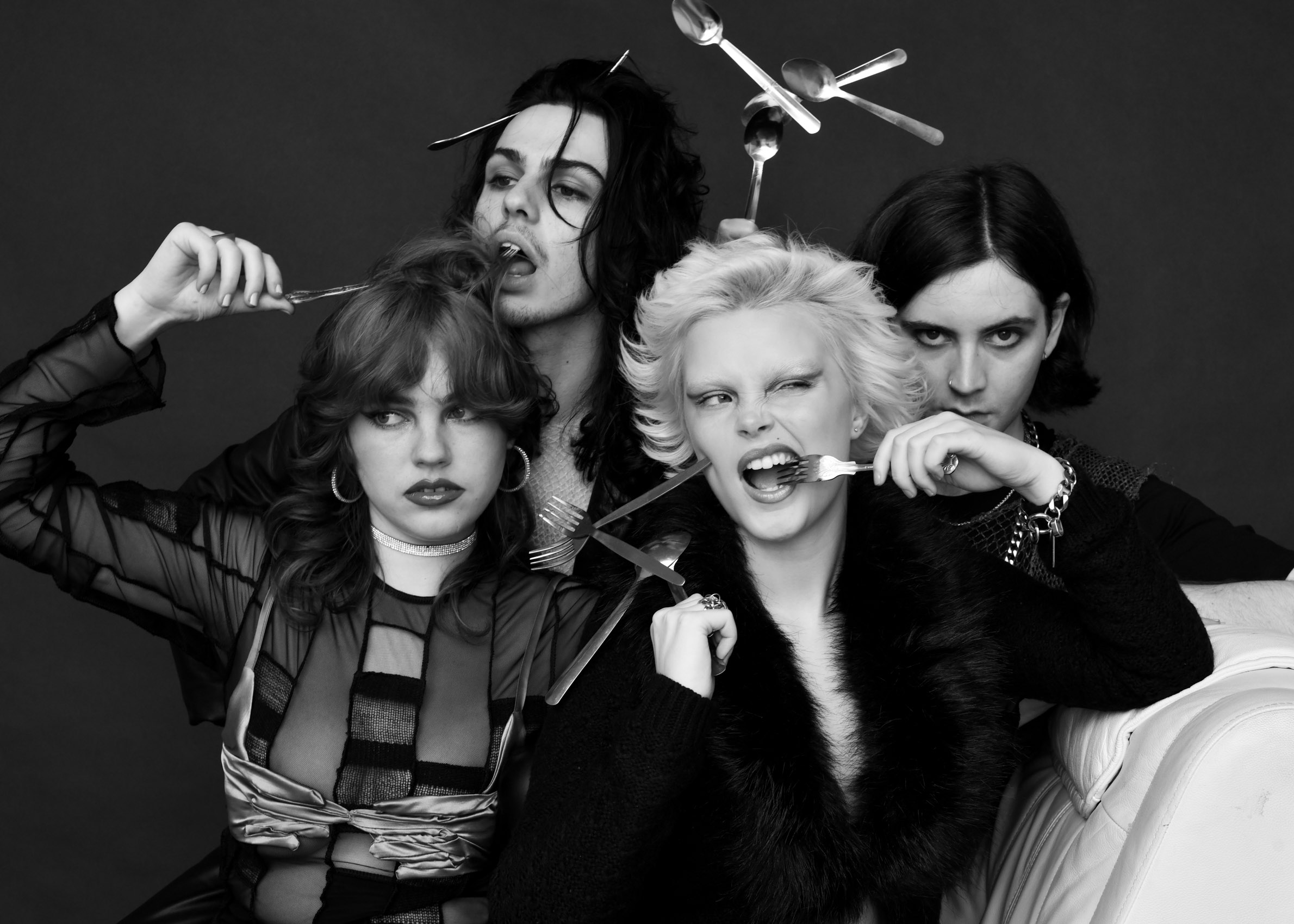
IN TALKS with SBA
21.10.21
Words by Tegan Jaimie
Made-To-Order brands are leading the charge in a new wave of conscious fashion labels. Revolting against their zeitgeist-led fast-fashion counterparts, the MTO movement isn’t fleeting or short-lived. In fact, these agile business models may be the only viable way forward to solve the industry’s significant contribution to the climate crisis.
We chatted with one of our original made-to-order designers, S-BA here at LUNCH to discuss the origins of the brand, seasonless collections, and of course, an ideal lunch in the studio. The S-BA founder Samantha Balcombe is hand-making pieces that are enduring and timeless and it’s time to get to know the designer now.
EXPLAIN THE DNA OF THE S-BA BRAND?
S-BA started very loosely about 5 years ago. I was in between jobs and internships and was very unsure about what step to take. I was working in a cool concept store and my boss told me that I should just start my own brand and we can sell it in the store. So that is where it started! Back then it was completely different, I was listening to a lot of techno and raving every weekend so it was very dark, unisex, and oversized designs. I was working full time at this store so I was just making a few things here and there to test the waters. It wasn’t until about 2 years ago that I started to take it more seriously. I found the style that I actually liked making and wearing which I think is more feminine and pretty but still comfortable. I like my pieces to feel unique to the buyer so most of my pieces have an element of hand stitching or embroidery. My mum taught me how to sew when I was very young, I think of her a lot when I am making so I say she would say is a big part of the DNA of this brand too.
WHERE DO YOU DRAW INSPIRATION FROM?
I draw inspiration from lots of different things. Could be from the music I am listening to, things I see when I am traveling, or people I see on the street who I want to wear my designs. Sometimes even just seeing a certain fabric I want to use can inspire me as I think about what I could make with it. At the moment I am quite inspired by sparkly and embellished things so I think something new will be coming to S-BA soon!
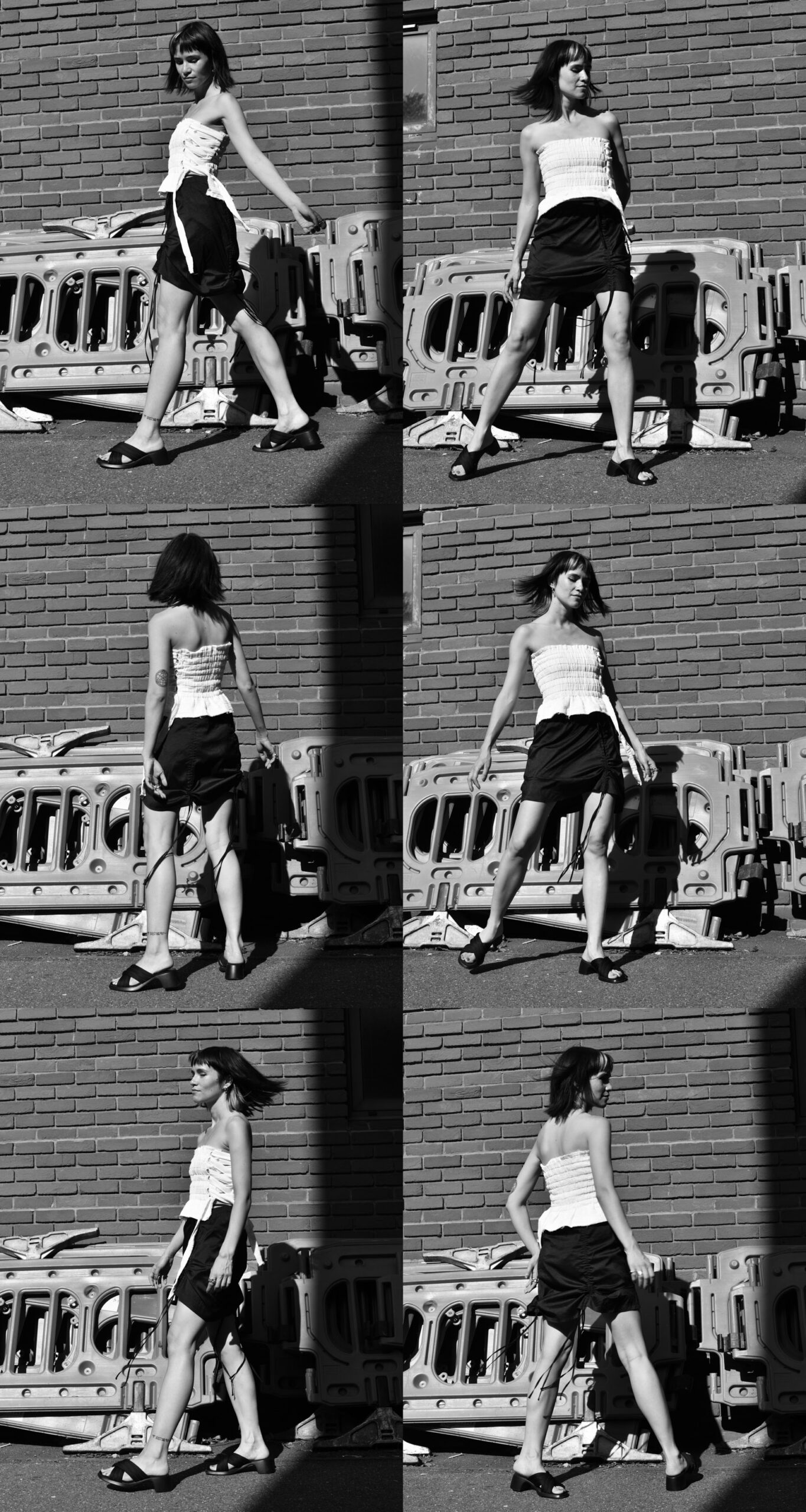
YOU ARE (HAND)MADE-TO-ORDER, WHY DID YOU DECIDE TO HAVE THIS BUSINESS MODEL?
All my pieces are handmade to order to help reduce wastage. I prefer to do it this way instead of having multiple garments and lots of fabric sitting around. And in some weird way, I feel like it is more personal making each piece to order. Also as I have moved my studio to home, it is a lot more space-efficient as my flat is tiny!
AS A SEASON-LESS LABEL, WHY IS THIS CONCEPT IMPORTANT TO YOU?
The season-less aspect was always gonna be my concept before I started my little label. After interning with designers and realising the mad stress and the amount of work leading up to each season, having to create so many looks that are soon to be branded as “past season” 6 months later. Having zero breaks and no sleep. It just always seemed so wasteful and not good for your mental health. I would rather create one season a year with staple pieces that can be worn throughout the seasons. I do carry over some designs as well from previous collections such as the Slit Trouser. This was only of my first ever designs and still one of my favourite pieces!
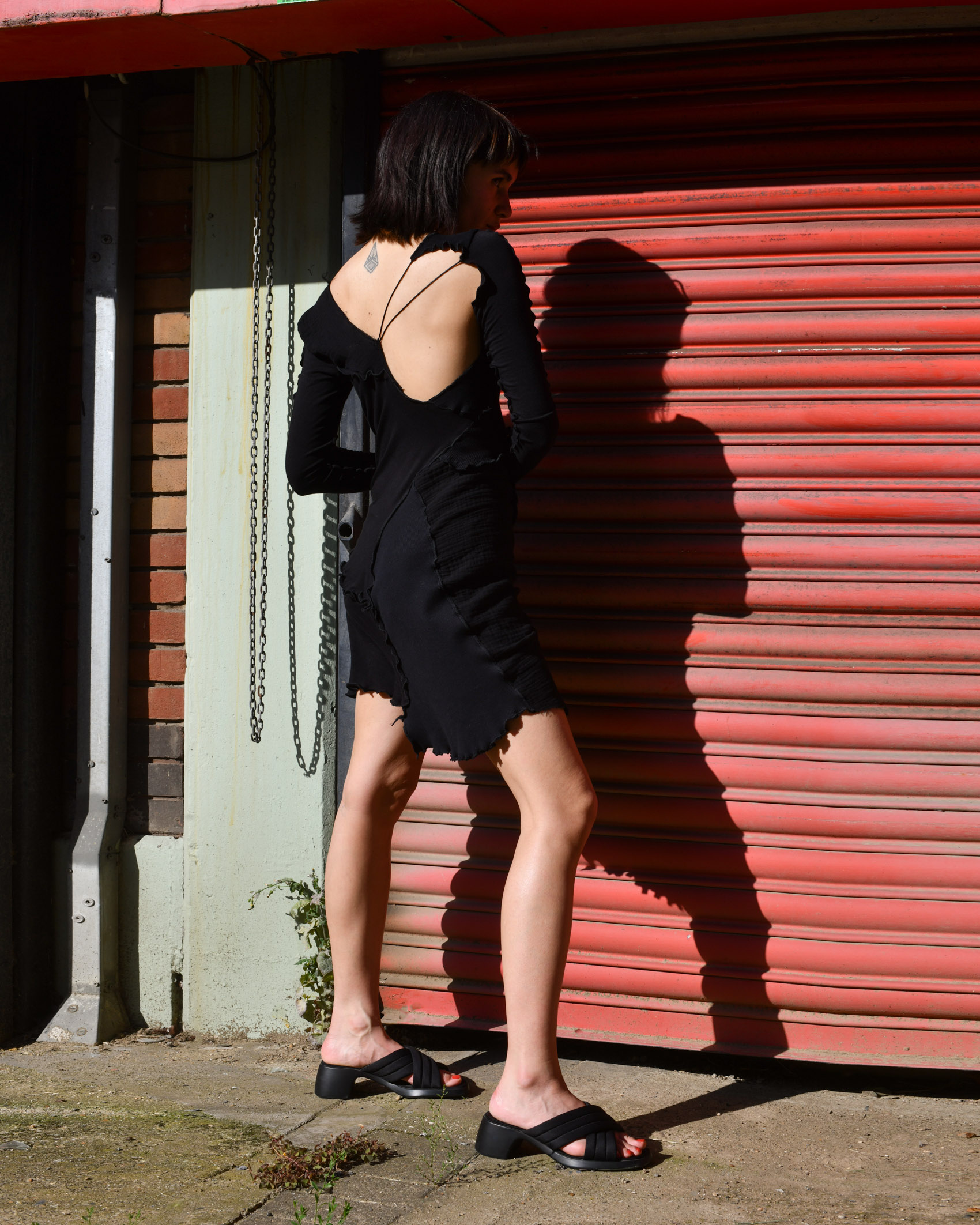
COULD YOU EXPLAIN MORE THE RESPONSIBILITY AS A FASHION DESIGNER TO BE MORE SUSTAINABLY CONSCIOUS?
I think it is very important when starting a brand to think of how to be as sustainable as possible. There is so much mass-produced and fast fashion shit out there that I think it is important to not follow the trends and create unique pieces that are special to you, whilst also trying your hardest to not damage the environment. I am always thinking of new ways to be more sustainable. A couple of years ago I stopped getting my fabric labels made, and instead, I bought a stamp for my logo and I handwrite the care instructions onto scrap fabric. I also have always kept most of my fabric scraps, and over the last year or so I have been turning them into remnant tops and dresses. One-off designs that I patchwork together. These have been my favourite things to make and have been a hit!
AND FINALLY, WHAT IS YOUR IDEAL LUNCH WHEN IN THE STUDIO?
I am currently trying to be healthy so my current lunches have been very green salads. However, my ideal lunch would be fried chicken or a burger and chips!
